- Credit cards
- View all credit cards
- Banking guide
- Loans guide
- Insurance guide
- Personal finance
- View all personal finance
- Small business
- Small business guide
- View all taxes

You’re our first priority. Every time.
We believe everyone should be able to make financial decisions with confidence. And while our site doesn’t feature every company or financial product available on the market, we’re proud that the guidance we offer, the information we provide and the tools we create are objective, independent, straightforward — and free.
So how do we make money? Our partners compensate us. This may influence which products we review and write about (and where those products appear on the site), but it in no way affects our recommendations or advice, which are grounded in thousands of hours of research. Our partners cannot pay us to guarantee favorable reviews of their products or services. Here is a list of our partners .
How to Start a Retail Business: A Step-by-Step Guide
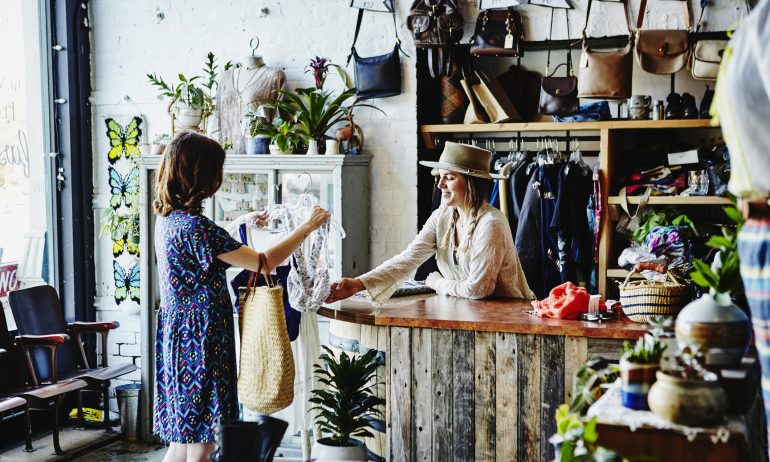
Many, or all, of the products featured on this page are from our advertising partners who compensate us when you take certain actions on our website or click to take an action on their website. However, this does not influence our evaluations. Our opinions are our own. Here is a list of our partners and here's how we make money .

If you’re thinking about starting a business in the retail industry, you’re in good company. Although local retailers don’t get the same level of attention as nationwide brands do, small retail businesses actually make up the vast majority of all U.S. retail businesses.
In fact, researchers found that small retailers (with 50 or fewer employees) made up 98.6% of all retail businesses in 2019. To break into this vibrant industry and open a store of your own, therefore, you first need to understand how to start a retail business.
To help you through the process, we’ll guide you through all the steps required to start a retail business, as well as offer additional resources to assist you on your startup journey.

How to start a retail business in 10 steps
These steps will have you running your retail business in no time. Let’s get started.
Step 1: Find your niche.
The first decision you'll need to make in order to learn how to start a retail business is figuring out your company's niche. You may already have an idea of the type of company you want to form, or you may still be grappling to figure out where to focus your retail company. To determine your niche market, we recommend:
Explore your interests and passions: Determine what you love doing or what you'll enjoy selling.
Brainstorm potential conflicts: No industry is perfect, but figuring out what obstacles or issues you could encounter in your niche will help you plan ahead and determine if an industry is a good fit for your business.
Consider profitability: At the end of the day, you want to make money from your retail business, so you'll need to find a niche that has the potential for profitability. Generally, if your niche has absolutely no competitors, it's usually a sign there's no demand, and therefore, your focus will not be profitable. Use our guide to learn more about the most profitable business ideas.
Research competitors: Once you've found a niche market using the above three steps, it's time to research your competition. Figure out how they're marketing and selling and determine what you can learn from them and how you can improve upon what they have to offer.
Retail business examples
Deciding on your niche can take a long time. It requires significant research and the passion to work within a particular market. To help you get started in identifying your niche market, here are a few retail business examples worth exploring:
Coffee shops
Apparel shops (eyewear, sports apparel, undergarments, outerwear)
Restaurants and bars (determine a theme, whether that's the cuisine, small plates, a canteen, etc.)
Game centers (board games, video games, etc.)
Monthly box subscriptions
Pet supply shop
How much do you need?
with Fundera by NerdWallet
We’ll start with a brief questionnaire to better understand the unique needs of your business.
Once we uncover your personalized matches, our team will consult you on the process moving forward.
Step 2: Write a business plan.
We don’t doubt that you have an amazing idea for a retail store, but an idea alone isn’t enough to turn a dream into a reality. By writing a business plan, you’re providing yourself (and, potentially, future lenders and other stakeholders) a physical roadmap detailing every step you’ll take to open and run your retail business.
Therefore, when you're crafting your business plan for opening a retail store, you can start by answering essential questions about your business model:
What kinds of products are you selling?
Will you open a brick-and-mortar location, an e-commerce website , or will you take an omnichannel selling approach?
Who is your target market, and how will you market to them?
How will you set your store apart from your competition?
You’ll also need to dig into details related to your processes, answering questions such as:
Who are your vendors? How will you store your inventory?
How much staff will you need?
What will your hiring process look like?
What will your startup costs be?
How much money will you need to launch?
How long will it take for you to break even?
How long will it take for you to make a profit?
Keep in mind, however, that your preliminary business plan is exactly that—preliminary. You can always return to your retail store business plan to make changes, updates, and additions as you gain experience with starting and running your business.
Create a business budget
Along the same lines, you should also create a business budget, to the best of your ability, well before you’ve opened your doors. At this stage, you should be paying especially close attention to your startup costs.
Unfortunately, if you're wondering how to start a retail business with no money, you're going to find it's extremely difficult. Although there a variety of ways to cut costs—selling online instead of opting for a physical location, for example—there will always be a handful of costs associated with starting and launching your retail store.
This being said, in addition to standard startup costs like equipment, business insurance, and payroll, if you’re opening a brick-and-mortar retail store, you’ll have to cover some specific costs, like a down payment, potential renovations, and monthly rent and utilities for your store. You’ll also be responsible for purchasing your merchandise, shipping and delivery costs, and storing excess inventory.
And don’t forget about the other tools and software you’ll need to run your business, including a POS system, retail accounting software , and a security system to monitor shoplifting and theft.
Step 3: Register your business.
With your business plan and budget in hand, you can now move onto the next step involved in learning how to start a retail business—making it official.
Come up with a business name
If you haven’t already, you’ll first need to come up with a business name. Choose a name that reflects your business’s purpose and brand identity, allows you room to grow, and, perhaps most importantly, is actually available for use.
Once you’ve landed on your dream business name, run your moniker through a Google search to make sure another entrepreneur isn’t already doing business under that name. Then, check for trademark filings in the U.S. Patent and Trademark Office, and conduct a Secretary of State business search to make sure there isn’t another business in your area with your potential name.
Once you’ve established that your name is free and clear, you'll want to buy your domain name and create social media accounts with your name. That way, you can build a business website and launch your marketing strategy ASAP.
Determine your legal structure and register your business
Next, in order to register your business, you’ll first need to decide on your business’s legal structure. Your business structure determines how you’re taxed, the degree of legal protection you’re afforded, your business’s ownership structure, and your ability to receive business funding (in addition to allowing you to register your business in the first place).
There are lots of business entities to choose from—all of which we overview in detail in our guide to types of business entities. Additionally, we’d highly recommend consulting a business attorney or accountant to guide you through this crucial step.
Once you’ve landed on a business entity type, you can go ahead and register your business through your state’s Secretary of State website. After that, head over to the IRS' website to apply for an EIN (employer identification number) online. Your EIN is a bit like your business’s social security number, and it’ll help the government identify you for tax purposes. You might also need an EIN to apply for a business loan down the line.
Step 4: Obtain licenses, permits, and business insurance.
Some states require a general business license, while others require licenses and permits at an industry level. You may also need to acquire local permits and licenses, so consult your county or city clerk’s website for their particular requirements, too. The SBA is an excellent resource for licensing and permitting information at both the federal and local levels.
For those learning how to start a retail business, you’ll likely need to obtain multiple retail licenses related to your field, including a resale certificate, seller’s permit, and a certificate of occupancy. We also recommend partnering with a trusted business attorney during this step.
Additionally, you won't want to forget about business insurance. As a retailer, you should consider general liability insurance, a business owner’s policy, and business crime insurance; and as an employer, you’re likely required by law to carry workers comp insurance, health insurance, and unemployment insurance for your staff.
Take a look at our guide to small business insurance for more information on the types of coverage you need.
Step 5: Find a physical location and build an online store.
If your retail business will include a physical store, finding the right location is arguably the most important aspect of this process. Your location can make or break the success of your business: If you’re located in a heavily trafficked area, then your marketing efforts are practically built-in. If it’s in a tough-to-find location, or if parking is limited, then your bottom line might suffer.
The right location for your business depends largely upon who your target market is and where they hang out. If you’re opening an upscale boutique, for example, you probably want to choose a neighborhood that skews less toward students and cash-strapped millennials, and more toward people with some discretionary income to burn.
Of course, you’ll also have to keep in mind how much space you need for display areas, a back-office and break room for your staff, dressing rooms, and an inventory storage area. Your location will also depend largely upon how much room you have in your budget for renovations, store design, remodels, updates, a down payment, and your monthly rent and utility bills. That may mean opting for your second or third choice location to protect your budget.
Build an e-commerce store
Even if you always dreamed of a brick-and-mortar store with in-person transactions, we also recommend opening an online store to give your retail business as much exposure as possible.
Luckily, building and managing an online store is incredibly easy with an e-commerce platform. Here are a few recommendations to get you started:
Shopify: This platform provides an infinitely customizable, standalone store that you build and manage entirely on your own.
Squarespace or Wix: These business website platforms are simple to use and offer e-commerce functionalities.
Etsy, Amazon, or eBay: These popular marketplaces will provide you with plenty of built-in traffic and handy seller tools. On the downside, you won’t have as much control over your branding, customer relationships, or fulfillment process as you would with your own e-commerce store.
The combination of e-commerce and in-person retail is sometimes referred to as "bricks and clicks." You can use our guide to learn more about the bricks and clicks business model.
» MORE: How to start an online boutique
Step 6: Establish relationships with vendors and suppliers.
This is the next step to learning how to start a retail business—and beyond your store’s location, arguably one of the most crucial aspects of your potential success—is finding trustworthy vendors and suppliers. Your vendors might become your most valuable partners and a great vendor can present you with new merchandise, determine which products will sell best, and cut costs for you.
There are a few considerations to keep in mind as you’re searching for vendors.
Budget: Your vendors need to work within the supplier budget you’ve established.
Quality: The quality of their merchandise is crucial.
Reputation: You want to work with a supplier who is guaranteed to deliver your agreed-upon items on time and in good condition—every time you place an order.
Customer service: Remember that you’ll be working closely with your vendors, so their service team must be reliable, personable, and easy to contact in case you run into any issues.
We recommend establishing relationships with several vendors. Even if your vendor of choice is stable, reliable, and cost-efficient, you need to have a contingency plan in place—without merchandise to sell, you won’t have a business to run.
Step 7: Hire staff.
If you’ve never hired an employee before, take a look at our guide on how to hire great employees who’ll stick with you for the long run. When hiring for a retail position, make sure to interview as much for their attitude as you are for their experience. While you can train your employees to use your POS system and manage your inventory, you can’t teach them to be kinder, friendlier, or more trustworthy than they innately are.
In advance of hiring your first team member, make sure you understand your state-regulated employer requirements. Your state might require that you buy certain types of insurance for your staff. Additionally, you’ll probably need to complete some other steps, like creating a state withholding account for payroll, reporting new hires, and verifying your potential new hire’s employment eligibility as well.
Step 8: Find the right POS system.
Your POS system just might become your retail business’s best friend. It’ll certainly become your employees’ best friend—assuming you choose an intuitive, easy-to-use model, of which there are tons on the market right now.
A point of sale system combines hardware and software that enables your business to accept and process all kinds of payments. Most POS software is loaded with valuable back-end capabilities, like inventory management, employee management, CRM tools, sales reports, and vendor tracking.
If you’re opening a brick-and-mortar location, you’ll need a POS system that can accept cash, checks, contactless payments, and both chip and swipe cards. In addition, you’ll need a barcode scanner, receipt printer, and cash drawer.
For more flexibility, you might want to look into a POS system that allows on-the-go payments, too. For example, Square (and most other POS systems) has mobile card readers that plug into your phone or tablet so you can accept payments from virtually anywhere, whether that’s at a pop-up shop, craft fair, or trunk show.
Similarly, Clover also has a fully equipped, handheld POS device so you or your staff can ring up your customers from anywhere in your store.
Ultimately, you have options—a lot of them. To help you navigate the selection process, consult our guide on the best retail POS systems.
Step 9: Organize your finances.
As we mentioned earlier, it's nearly impossible to figure out how to start a retail business with no money—so, whether you have a large amount of startup capital or are operating on a tight budget, it's extremely important to organize your finances.
First, you'll want to open a business checking account . If you’re happy with your current bank, you may want to open a business bank account there. It’s logistically easier for you to maintain all your finances with the same institution. In addition, many banks offer discounts and other incentives when consumer clients open business accounts. If you want to compare your options, we recommend looking into our best business bank accounts guide.
Next, you'll want to get a business credit card . Most credit card companies allow business customers to apply for a business credit card online—which makes this step even easier than opening a business bank account.
If your business is too new to have any financial data, you can provide your personal financial information on your application. If you’re approved, you’ll receive your card in the mail in about a week or two. Use it for your business’s smaller, daily expenses, and be mindful of only using it for business-related purchases to maintain personal and business financial separation.
Get funding
Most entrepreneurs need a little (or a lot of) financial help to get their businesses off the ground. That may be especially true of retailers and brick-and-mortar business owners, who have a few extra startup costs to contend with.
Although it can be difficult to get a business loan as a startup, there are a variety of alternative options you can consider, especially as you start to run your retail store and become more established.
Finally, don’t forget to sign up for a good business accounting software solution, which will streamline, automate, and organize your business’s finances.
» MORE: Best retail business loans
Step 10: Market your retail business.
At this point, you've learned the most important pieces of how to start a retail business, and now, you're ready to open your doors and get to work.
Of course, to get the word out about your business, you need to develop a small business marketing strategy, which provides you with an opportunity to get a little creative. The best marketing strategies, especially for brick-and-mortar stores, use a combination of SEO, social media, email marketing, paid online marketing strategies (if their budget allows for it), and analog marketing efforts.
At the very start of your venture, your time is best spent building a business website and creating social media accounts. Squarespace and Wix provide users with tons of customizable, professionally designed templates and built-in SEO tools. For social media, focus on creating diverse, high-quality content, posting regularly, and responding promptly to your followers’ comments and DMs—both the positive and the negative.
As a brick-and-mortar store owner, in-person marketing tactics are also important. We recommend:
Getting active in your local retailer community, networking with your fellow business owners, and participating in craft fairs and other events showcasing local businesses.
Partnering up with a local business whose target market is similar to yours and putting on an event together, or hosting pop-up shops or trunk shows in each other’s locations.
Using good sales incentives—like BOGO deals, giveaways, and free trial periods—to draw even more customers into your store.
To boost your marketing strategy, it's important to take some time to develop your brand identity. Establish your messaging, market positioning, and how your unique business can provide your customers with what they’re looking for—then create the materials to reflect those core values.

LLC Formation
The bottom line
As you navigate the business formation steps, be careful not to lose sight of why you’re opening your retail business in the first place. If you remember the passion that inspired you to launch your business, you might even enjoy the finer points involved in the process—who knew finding a POS system could be so fun?
This article originally appeared on JustBusiness, a subsidiary of NerdWallet.
On a similar note...
LIMITED TIME OFFER

Ink Business Unlimited® Credit Card

How to Start a Coffee Shop Business Successfully
How to start a coffee shop business.
Coffee Shop Startups
The Ultimate Step-by-Step Coffee Shop Guide (2024)

With 210 million daily coffee drinkers in the United States and two billion cups consumed worldwide, the American and global markets point to a solid retail coffee future.
Whether you want to start a coffee truck business, open a drive-thru coffee stand , or a brick-and-mortar coffee shop, you will likely find coffee lovers in your community who would visit your business. After all, the world runs on coffee!
Successful coffee shop owners come from every walk of life – so don't fret if you are NOT a barista champion or a seasoned coffee roaster! Chances are that your personal and professional experiences have likely prepared you to start your journey. By following the steps and recommendations we outline in this article, you'll be well on your way to planning your successful coffee business!
Alright, below is a list of major steps to start your coffee shop. Let's look at them now.
Steps to Start a Coffee Shop Business:
1. Determine Your Coffee Shop Concept & Vision 2. Develop Your Menu 3. Write a Business Plan 4. Build a Coffee Shop Budget 5. Create a Funding Mix 6. Establish Your Business Structure 7. Determine Your Competitive Advantage 8. Create Your Coffee Shop Brand 9. Determine Your Target Market 10. Understand Your Health & Buildings Department Regulations 11. Choose an Excellent Coffee Shop Location 12. Purchase Your Coffee Equipment 13. Explore Wholesale Coffee Roasters, Vendors and Partners 14. Analyze the Coffee Shop Competition 15. Get Your Permits & Licenses 16. Hire Amazing Baristas 17. Promote Your Coffee Shop
Not too shabby, right? Yet, getting started requires a little more detail. So, we'll discuss each of these below. But before doing that, we need to consider several pre-planning elements as you start your coffee business.
Laying The Ground Work for a Successful Coffee Shop
Preparing to Start a Coffee Shop Business

Here are a few critical recommendations as you set out to start a coffee shop:
Start Your Research.
When we start anything for the first time, we “don't know what we don't know.”
Dedicate yourself to learning as much as possible about opening a coffee business. You can do this in different ways. For example, you may work as a barista or train as a coffee roaster for a coffee shop. You may also have experience in other relevant fields, such as accounting, finance, marketing, or food service—all helpful in operating a coffee shop.
Consider exploring our coffee business blog for relevant topics and purchasing our Complete Coffee Shop Startups Kit . It is a complete coffee shop business course, with one-on-one interviews with experts and business owners, multiple guides, worksheets, and resources.
Write a Coffee Shop Business Plan
Your coffee shop business plan will serve as your road map. It will help lay out your vision and mission for yourself and other important stakeholders.
Business plans can be a powerful tool to help secure your funding through lenders and provide your future property manager with the necessary information.
A business plan is also essential for two crucial outside stakeholders: lenders and property managers. Both will likely require one before they enter into any financial arrangement with you.
Your plan should outline your coffee shop concept, target market, budget (costs), branding, income projections, and more.
Consider your business plan an opportunity to shine and strengthen your thoughts and ideas so that others can understand and believe in your vision. No doubt, your coffee shop business plan helps to connect all the dots – from your financial goals to your financial needs and everything in between.
Sections of a coffee shop business plan:
- Your Executive Summary
- Concept, Vision, and Mission
- Business Structure Details
- Budget and Funding
- Coffee Shop Menu
- Net Income Projections
- Permits and Licensing Issues
- Branding and Marketing
Deep Dive: Check out our in-depth blog post, How to Write a Coffee Shop Business Plan .
Consider the Startup Costs
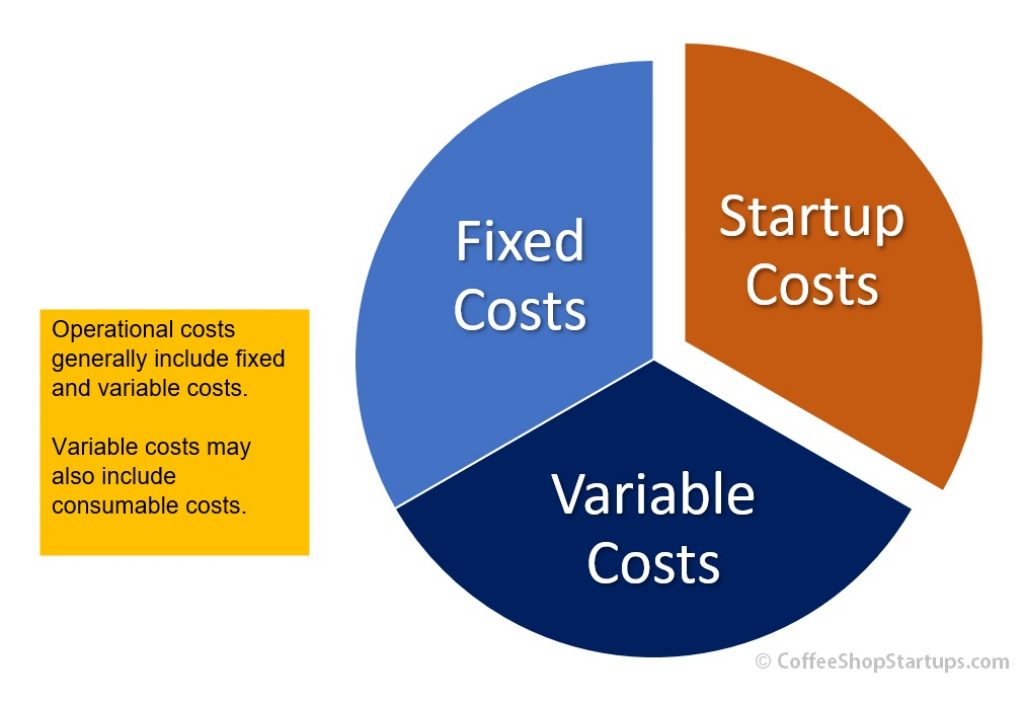
Still, you should be aware of specific elements that make up many of a coffee shop's costs.
Coffee shop costs are impacted by the following:
- Your Coffee Shop Concept
- Coffee Shop Equipment
- Build out Costs
- Legal and Administrative Fees
- Contract work and Labor
Determine Your Coffee Shop Budget & Funding Mix
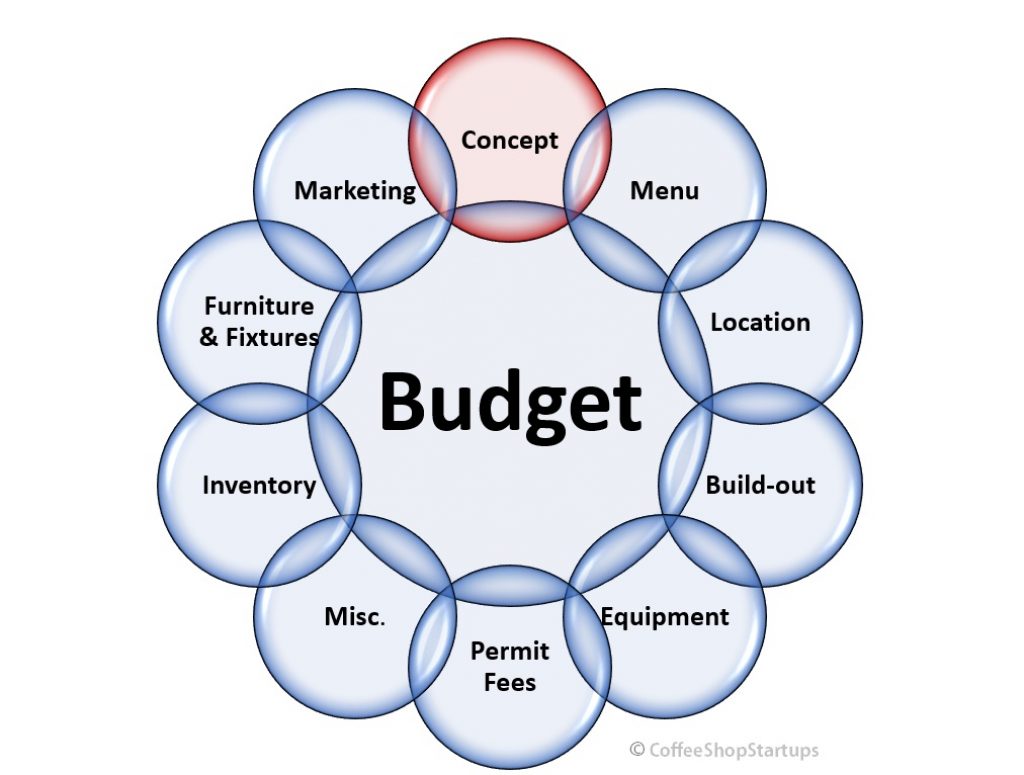
After understanding your concept, location, menu, and coffee equipment needed , you'll want to put this together in a budget. It is recommended to write down every possible expense and put them into categories to help you keep track of all your anticipated expense areas.
Budgetary tips:
- Be honest with yourself about the numbers
- Diligently write everything down
- Keep your “budget” updated
- Determine where you will get the money from
Ways to Open a Coffee Shop Business
Starting a coffee shop, mobile, or drive-thru coffee stand business is a great way to make money and earn a living.
There are three main ways to start a coffee shop:
- Start a coffee shop from scratch.
- Invest in a coffee shop franchise.
- Buy an existing coffee shop.
We'll skip the last two ways and focus on opening your coffee shop from scratch. But we're not going to pull any punches. Starting a coffee shop will take knowledge, determination, and hard work—and we're here to help you with that.
Determine Your Coffee Shop Concept & Vision
Developing your coffee shop concept is where you turn your ideas into action. Your coffee shop concept is a universal idea that combines all essential elements.
These elements include:
- Vision & mission
- Menu offerings
- Your Unique Selling Point (USP)
- Location and space
- Customer experience
Your coffee shop's concept centers on the experience you want your customers to have when they walk through your doors.
A few questions might help you develop your concept:
- What kind of experience would you like to provide your coffee customers?
- What kind of products would you like to offer?
- What location would be most accessible to the customers I'm trying to reach?
Whether you are starting your coffee shop on a shoestring budget or you have ample funds, determining your vision, menu offering, unique selling point , location, and customer experience can cost little, if any, money.
Build Your Coffee Shop Menu

Without your menu, you won't be able to determine your coffee equipment needs , estimated budget, physical space requirements, target market, and, thus, your geographic location.
Spend some time developing your coffee shop menu. For starters, visit potential vendors (For example, bakeries and wholesale sandwich vendors). It's also good to see what your competitors serve and how customers respond to their menus.
While coffee might be your central focus, other essential products (and money-makers) will play an important role in expanding your average ticket price. This may include beer, wine, and hot food.
Planning early is critical because your menu can boost your coffee business's startup costs , increase scrutiny from the health department, and require a more specialized space. These costs are offset by the potential to generate more sales and significant revenue with likely higher-margin food items.
Time Saver: Our Complete Coffee Shop Startups Kit has a Coffee Shop Menu Concept Worksheet to help you develop your menu.
Build a Coffee Shop Budget
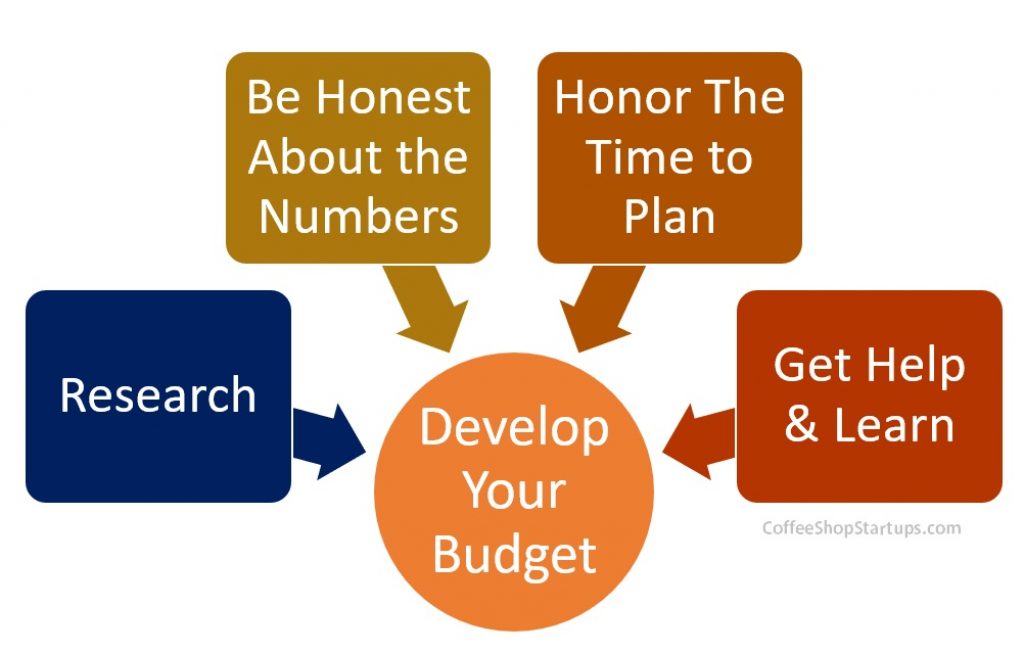
How will you estimate your coffee shop startup costs?
Creating a coffee shop cost analysis that documents your costs will be necessary. This would likely include costs such as:
- Initial startup costs
- Materials for your build-out
- Contract work design and layout
- Coffee shop equipment
- Barista training
- Miscellaneous operational expenses
- Inventory & Supplies
- labor and payroll costs
I recommend building your menu, considering potential equipment needs, and considering location costs when developing your budget. Once you have these elements, you can build your overall coffee shop budget .
Be honest with yourself and confront the anticipated costs directly. If you have a solid business plan and an excellent way to execute it, you will have a better chance of securing the money to start your coffee business.
Establish Your Coffee Business Shop Structure
When starting a coffee shop, you'll have several options to form your business . From a sole proprietor to a limited liability company (LLC) to a corporation, you have choices to set up your business legally.
You'll want to research which type of business formation will work best for you. From our experience, many independent coffee shop owners have found that establishing their coffee shop as an LLC has many benefits .
A legal business structure, like an LLC, is an important step that will help protect your assets and establish essential business elements, including your bank account, taxes, worker's compensation, liability, commercial auto insurance, etc.
Consider reviewing what business structure works best for you and the type of coffee business you set up. This entails examining your tax obligations, obligations to maintain your business entity, controlling funds, and liabilities.
In most states, creating your coffee shop business structure is usually done through your state's Secretary of State office. Some states have other designated departments.
What to do:
- Determine the best business formation for you
- Contact your state's Secretary of State's office
- Register your business
- Pay any fees
- Apply for an EIN
Determine Your Competitive Advantage
What makes your coffee business unique?
Your competitive advantage will separate you from the rest of the competition and answer the question: Why do your customers choose to buy from your coffee shop rather than the competition?
Your competitive advantage is your North Star. It helps guide your priorities, training, branding, customer service, and marketing.
Your competitive advantage – or Unique Selling Proposition – plays to your strength and what your target market cares about.
Capture the essence of that difference, write it down in your business plan, and develop a barista training program around it.
Focusing and training to fulfill your competitive advantage will help you strengthen your position in your marketplace.
Create Your Coffee Shop's Brand

As consumers, we all have some understanding of what a brand is. We are likely seasoned shoppers; we know what brands we like and those we don't.
From the concept, colors, logo, and slogan, your branding will play a vital role in the perception of value your customers will have and the connection they feel about your business.
Whether you want to set up a coffee shop, drive-thru espresso stand, or a mobile coffee trailer , spend time and thoughtfully cultivate your coffee shop brand .
Determine Your Target Market
Every successful business solves a problem – even coffee shops. Believe it or not, you are solving someone's problem with coffee.
First, you must understand the problem and who you are solving it for to develop your target market.
Are your customers going to be:
- Students waiting for the bus?
- Commuters on their way to work?
- Lunchtime casual coffee drinkers?
Knowing your target market requires you to do a little research and understand the traits and needs of your customers. Sometimes, this means understanding the demographics of your target coffee drinker with a specific geographic location.
Learn about your customers:
- What is their income level?
- Are they students or professionals?
- What mode of transportation do they depend on?
Knowing your target market helps you with your entire effort and aligns your competitive advantage to better position your coffee shop, drives sales, and creates effective marketing.
Know Your Health Department Regulations
Every coffee business will fall under the jurisdiction of one health department's rules and regulations.
All coffee businesses require health department permits to operate legally. Your local health department will be a prominent agency signing off on your coffee shop's readiness for business.
It would help if you determined your contact within your local health department. Start early and decide what you need to do to meet their requirements.
Most health department agencies want you to succeed and will work with you, but you'll need to do your part and understand what is required for your business.
Time Saver: Our Complete Coffee Shop Startup Kit offers an informative look at one of the nation's seasoned health departments. It's worth listening to as it will allow you to think about the essential steps to addressing your health department's permitting.
Choose an Excellent Coffee Shop Location

- Customer accessibility
- Sales and repeat business
- Customer convenience
Choose a location with high visibility, easy accessibility, and close to your target market.
As you would imagine, you need to start early with this part of your coffee shop business plan and evaluate the best coffee shop location for your business.
Consider exploring multiple coffee shop locations in the general area where you wish to do business. Find out where your competitors might be. Talk to neighboring residents and businesses. Determine the traffic flow of the area. Look at other “anchor” businesses, living spaces, and organizations like other restaurants, apartment buildings, dorm rooms, colleges, and office buildings.
In addition to looking at possible coffee shop locations, have a written business plan so you can readily give your plan and proposal to the property manager.
Your Coffee Shop Property Lease
You found the perfect coffee shop location , but the lease may ruin your business.
A good property lease may help promote your business and be an element that leads to your success. A poor lease, on the other hand, can pile up the challenges and cost you much more in the long run.
Signing a multi-year property lease that could cost you tens of thousands of dollars can be intimidating. Therefore, preparing for your coffee shop property lease and understanding more than the basics is essential.
Our Complete Coffee Shop Startup Kit offers a great discussion on your coffee shop property lease and location . While we don't offer any legal advice, we recommend that you listen to it before signing a lease.
How to Choose Your Coffee Equipment

To first determine your menu needs, consider asking the following questions:
- Who is your target market?
- What food or beverages does your target customer want?
- Will you serve breakfast, lunch, snacks, or alcohol?
In addition to determining what food and products you will sell, your sales volume will play a big role in the size, brand, and model of your coffee shop equipment. For example, you may want a three-group espresso machine or two separate two-group espresso machines for high-volume coffee shops.
Consider estimating your future sales before buying your coffee equipment .
Having the wrong equipment will cost you more money in the short-run (and long-run) and lead to lost sales if your coffee equipment cannot handle the sales volume you may get.
Example of coffee equipment:
- Espresso machine
- Refrigerator(s)
- Ice machine
- Toaster oven
- Coffee roaster (If you will roast your beans)
When you open a coffee shop, you will want to use NSF-labeled items to ensure commercial grade. Additionally, you may need to get and/or build out many other pieces of coffee-related equipment, supplies, and fixtures before you can open and serve your menu. These may include your electrical system, plumbing, physical coffee bar, seating, and other elements of your space. You will want to plan and budget for those items.
Time Saver: *Our Complete Coffee Shop Startup Kit contains an excellent hour-long discussion on coffee equipment that you want to hear before you buy anything.
For more information on coffee shop equipment, please read our post, Coffee Shop Equipment You Need to Start a Coffee Shop.
Explore Local Coffee Roasters
The quality of coffee matters.
You likely want to sell the best coffee possible when opening a coffee shop. Therefore, choosing where and how you get your coffee will be essential to success.
If you opened a wine shop, you would not aspire to sell mediocre wine, would you?
Make it a priority to learn about serving excellent coffee and the coffee roasting process and appreciate the effort that goes into developing delicious coffee taste profiles and blends. In time, you'll choose a wholesale coffee roaster that appeals to your tastes and favorable vendor terms.
Roasting Your Own Coffee Beans?

While roasting your coffee beans can save you significant money in the long run , you probably already know that roasting your beans will take up much of your time and will require extra financial capital, including cash for a coffee roaster, equipment installation, and the administrative effort to coordinate purchases and deliveries of green beans.
If you buy your beans wholesale from an existing coffee roaster, I recommend approaching local coffee roasters early in your coffee shop business planning process. It will also be fun and exciting to speak to passionate coffee roasters, exploring different blends and how their coffee would fit into your menu, concept, and brand.
Many coffee roasters will offer a free “coffee cupping” for you to sample their coffee. I recommend visiting several local coffee roasters and attending their cuppings.
Feel free to reach out to local coffee roasters. Ask them to provide their wholesale cost of a coffee per pound and what type of support they could offer you if you served their coffee.
Analyze the Coffee Shop Competition
Your coffee shop will likely have competition from other local businesses. This is not necessarily bad, as competition often drives businesses to improve.
However, knowing what competition exists in your market and how you will respond to it is essential – and vital to act upon. For starters, you will want to determine the experience other coffee shops provide, what menu items they serve, and how they serve it. You'll also want to devise a plan to beat the local coffee shop competition .
You will want to analyze the competition before you choose a location and while you are open.
Consider asking yourself:
- Where will your coffee shop fit within the marketplace?
- How will your competitive advantage stack up against the competition?
- Can you compete on your product quality or service?
- How can I adapt to better compete and drive sales up?
Good coffee shop management includes making decisions that improve your competitive advantage and increase sales and customer retention.
Know Your Local Laws, Regulations, Zoning Permits
Before you open your coffee shop, you will need various licenses and permits from multiple departments to operate legally. Different elements will determine the permits and licenses you need to open your coffee shop. These include your business concept, location, menu, and power needs.
The city and county you are in will provide the framework for your coffee shop operations. Getting in touch with them early and determining their specific regulations is essential.
Taxes, employment regulations, health and building codes, and other coffee shop requirements can all be impacted by where you decide to set up your coffee shop.
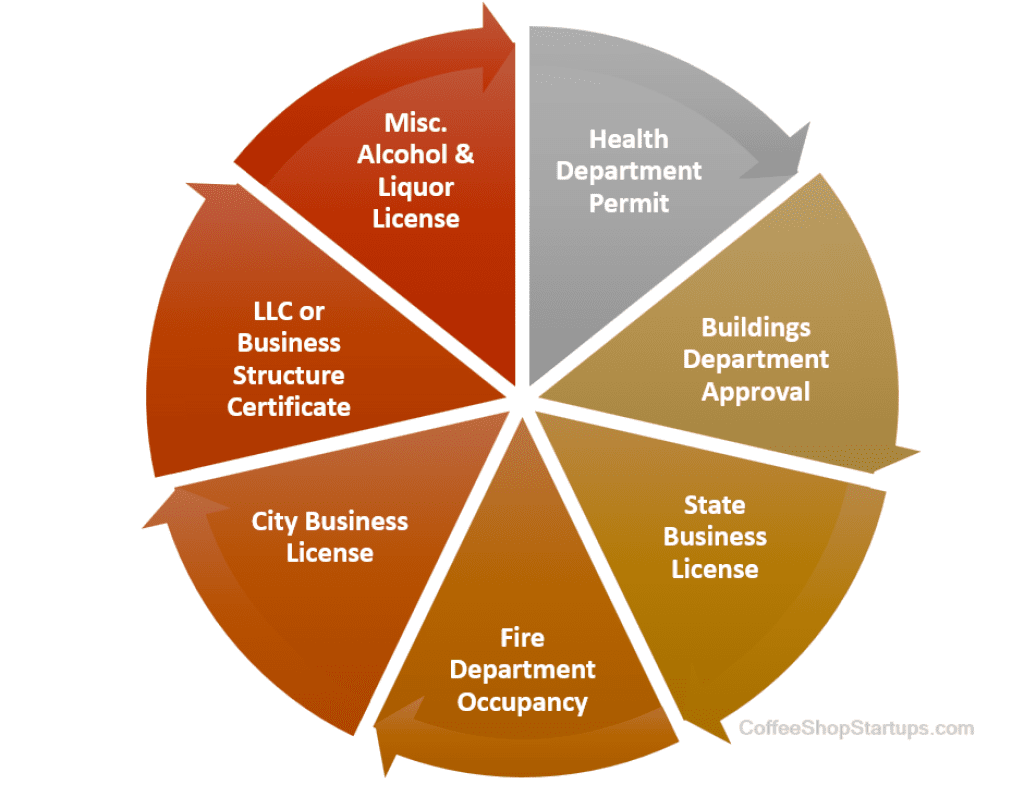
Permits and Licenses Often Required:
- Health Department Permit
- Buildings Department Approval
- Fire Department Occupancy
- Fire Department Fire Suppression Units
- State Business License
- City Business License
- LLC or Business Structure Certificate
- Liquor License (If applicable)
- Food Handler's Permit
- Reseller's Permit
For a more in-depth look at the coffee shop licenses needed for your coffee shop, read our post, Permits and Licenses You Need to Open a Coffee Shop .
Coffee Shop Design & Layout
Your priority may be to create a welcoming environment for your customers to sit and enjoy your coffee and menu items. Your coffee shop design and layout will impact your customer's mood, energy, and overall experience. However, it also affects your efficiency, workflow, and safety.
Your coffee shop design and layout are intertwined with your central concept's goal: defining your customers' experience.
Design your layout to maximize comfort, ease of sitting, and efficient workflow. Every location and every space is different, so prioritize safety, understand the regulations, and fulfill your permit requirements.
Hire Amazing Baristas

Use the process to weed out poor candidates or those without the skills you seek.
A barista training program for your new hires (and established baristas) is essential. Barista training allows your staff to be their best, improve their skills, and deliver a consistently good cup of coffee. Training also improves morale, reduces turnover, and creates a healthier work environment.
Hire your coffee shop staff for:
- Reliability
- Having People Skills
You can always train and educate your staff on how to serve coffee, implement quality control mechanisms, and serve your menu items with care. However, you can't train for good attitudes, honesty, or reliability, and therefore, your hiring decisions are critical to your ultimate coffee shop success.
Promote Your Coffee Shop Like Crazy
Promoting your coffee shop and building greater awareness of your new coffee business is critical to getting off to a great start.
Consider having a marketing and coffee shop promotion plan that starts with your coffee shop's grand opening. A grand opening aims to create excitement and a social buzz about your new coffee shop and provides you with the opportunity to meet your future customers.
Ultimately, coffee shops are about community. Having a grand opening and developing a marketing and promotional strategy that builds trust, improves your brand, and generates sales will be paramount.
You may want to develop connections with local school businesses and promote your coffee shop with local blogs, newspapers, social media, and your website.
Other Essential Steps to Starting a Coffee Shop
We've laid out some essential first steps in starting a coffee shop, but there are additional things you'll want to consider. Below is a brief list of items to think about:
Design and Layout Planning:
A detailed design and layout plan is often strongly recommended before purchasing coffee equipment or finalizing your location and signing your coffee shop property lease . This should consider customer flow, seating arrangements, the location of the equipment for efficiency, and the overall aesthetic appeal of the space.
Technology and POS System Selection:
In today’s digital age, selecting the right technology and Point of Sale (POS) system can greatly enhance the efficiency of your operations and the customer experience. This includes systems for managing inventory, sales tracking, customer loyalty programs, and even online orders if you plan to offer them.
Sustainability Practices:
Opening and operating a sustainable coffee shop doesn't just help the environment but it may also help your bottom line. As consumers become more environmentally conscious, incorporating sustainability practices into your business model can serve as a competitive advantage. This can include sourcing ethically produced coffee, offering discounts for customers who bring their own cups, using biodegradable packaging, and implementing waste reduction strategies.
Menu Development and Testing:
While you've mentioned developing your menu, it’s also important to conduct testing. This could involve hosting tasting events for feedback or having soft openings with limited menus to refine your offerings based on real customer preferences.
Marketing and Promotion Strategies:
Beyond the initial promotion of your coffee shop , developing ongoing marketing strategies is crucial for sustained success. This includes leveraging social media, email marketing, participating in community events, and possibly creating a blog or vlog to share stories about your coffee shop, highlight employees, or discuss the origins of your coffee.
Operational Workflows and Employee Training:
Detailed planning on operational workflows, including opening and closing procedures, cleaning, restocking, and emergency handling, can ensure smooth daily operations. Additionally, investing in comprehensive training for your staff not only in making coffee but also in customer service, upselling techniques, and handling difficult situations can significantly enhance the quality of service.
Financial Management and Growth Planning:
After the launch, keeping a close eye on the financial health of your business is critical. This includes regular reviews of your profit margins, cost control measures, and revenue growth strategies. Planning for future growth, whether through new menu items, additional locations, or expanded services, should also be continuous.
Open a Business Bank Account Early

Make your life easier at the beginning of your coffee shop planning by establishing your business bank account early.
Separating your business money from your money has its advantages. Come tax time, this will help ease the accounting headaches.
Before opening your bank account, you must establish your business structure and obtain an EIN, which you may have to apply separately at the time of your business formation.
Setup Your Coffee Business Website
It's been said that if your business doesn't exist online, it doesn't exist. Sometimes, this is true for coffee shops.
At the very least, your coffee shop website will be advantageous for affirming your coffee brand and sharing your story with your customers.
For more information about having your coffee shop website, read How to Setup Your Coffee Shop Website .
Create a Timeline To Open Your Coffee Shop
Develop a timeline for starting your coffee shop development. A timeline will help propel you to create your coffee business more effectively and efficiently.
We recommend setting an end goal (or date) and working backward.
Create a realistic time frame with periodic benchmarks. Balance your timeline by placing a little pressure on yourself, but not so much that you get overwhelmed and paralyzed.
Start small, but start.
Get Insurance For Your Coffee Shop
Every coffee shop needs insurance. You want to protect your coffee shop business and your employees. This means having general liability and workers' comp insurance, among others.
Determine what coffee shop insurance you'll need and get it immediately. You will likely need worker's compensation insurance in every state. This will satisfy your state's requirements and protect you and your business assets from a potential accident.
Avoiding accidents will be important through hiring competent people, training, and developing best practices, but “accidents do happen,” so insurance is a must-have.
Ask an insurance agent in your city to help you determine what suits you and your café (for general liability insurance), and check with your state's Worker's Comp agency.
Always Strive for Excellence
As you open a coffee shop, continuously look for ways to improve. Always strive for excellence, whether by providing a higher level of service, improved coffee, menu items, service, or ambiance.
Listen to your customers and employees and be willing to adapt to fit your customers' needs. By prioritizing excellence, refining your competitive advantage, and always looking for ways to be responsive, you'll position your coffee shop for lasting success and profitability.

Steps to Open a Coffee Shop
Frequently asked questions:, how much does a coffee shop cost .
A coffee shop's cost depends on your business concept, menu, and location.
For example, a drive-thru coffee stand might cost less than a full coffee bar. A bakery & café may cost much more than a small mobile coffee business .
Critical factors like your geographic location, real estate market, labor cost, etc., significantly affect your coffee shop business's cost.
Traditional Coffee Shop Business Startup Costs
- Small coffee shop with seating: $40,000 to $200,000
- Large coffee shop with seating: $75,000 to $350,000
- Franchise coffee shop: $100,00 to $350,000
- Café & Bakery: $120,000 to $350,000
- Coffee Shop Bookstore: $80,000 to $250,00
We discuss coffee shop startup costs in greater detail:
- How Much Does It Cost to Open a Coffee Shop?
- How to Start a Coffee Shop on a Budget
- Low-Cost Coffee Shop Ideas
What are the requirements to start a coffee shop?
Each city and agency will have business regulations and steps you'll need to follow and take, including the appropriate licenses and permits you need to obtain before opening.
A list of local agencies may include your health department, buildings department, licensing department, and fire department. Your requirements will be based on the type of coffee shop business you'll have, your menu, and other essential factors.
Despite the differences between states, counties, and cities, there are often standard requirements to start a coffee shop from one jurisdiction to the next. We've covered this important topic in our post, Requirements to Start a Coffee Shop .
How much money can I make by opening a coffee shop?
How long your coffee shop turns a profit depends on several important factors, including your total coffee shop startup costs, your operational costs, and your total revenue.
Determining how much money your coffee shop will make is essential to your business planning and should be estimated early.
Your menu, anticipated pricing, sales volume, and costs impact how much revenue your coffee shop will make. Creating strategies to improve your coffee shop profits is an ongoing challenge for coffee shop owners.
For a more in-depth post, please read How Much Do Coffee Shop Owners Make?
Should Invest in a Coffee Shop Franchise?
One way to open a coffee shop is by becoming part of a franchise. This business model is standard for many industries, including restaurants and coffee shops. If starting your independent coffee shop may be too difficult to muster, but you still want to own your own business, then a coffee shop may be one option.
A coffee shop franchise with a well-established brand, proven menu, and operational guidance – may be appealing. Like others, a franchise can have its pros and cons. Determining whether a specific coffee shop franchise will work for you will require research, careful budgeting, and planning.
Should I buy an existing coffee shop?

Buying an existing coffee business offers advantages and disadvantages, like opting into a franchise or starting a new coffee shop from scratch. Which option you choose always depends on your current situation, access to funds, timing, and management abilities.
Buying an existing coffee shop can be one of the fastest ways to enter the retail coffee scene and start making money. But you inherit the potential for pitfalls, such as lackluster sales, debt, past tax obligations, and poor branding and goodwill within a community.
Indeed, starting any business from the ground up takes much work, time, and money. Finding a suitable location, negotiating a lease, spending thousands on a build-out, and going through the permitting process can be a big hassle.
Yet, even the most promising coffee shops may be riddled with baggage (financial obligations, legal matters, and a poor reputation). Buying an existing business may also cost more as business owners want to maximize their profit and cash out.
Depending on the coffee shop, buying an existing coffee business might be a good deal. However, it's essential to consider all the pros and cons and decide based on what works best for you.
Are You Ready To Get Started?
Unlock your dream coffee shop business with our exclusive coffee shop startups kit.
Ready to transform your passion for coffee into a thriving business? Look no further! Our Coffee Shop Startups Kit is your key to brewing success. Here's why you can't miss this opportunity:
Includes Exclusive BONUS Material!
👉 Order Now and Begin Your Journey!
Don't let the complexities of starting a coffee shop overwhelm you. Our Coffee Shop Startups Kit is your ticket to entrepreneurial success. Take the first step towards owning a profitable and fulfilling coffee business today.
Join the thousands of successful coffee entrepreneurs who started with a dream and a great plan. Your journey to coffee shop greatness begins right here!
Comprehensive. Proven. Affordable.
The Complete Coffee Shop Startup Kit
(Instantly Delivered To You)
Based in Seattle, Washington, USA, Coffee Shop Startups is dedicated to providing you with the most relevant information on how to start a coffee shop business successfully. Over the last 11 years, we've helped thousands of aspiring coffee business owners worldwide. We harness the experience, wisdom, and knowledge of many successful coffee shop owners to help you increase your chances of success and profits. We support business owners who want to start a coffee business by providing them with valuable information on starting their coffee business successfully.
- Coffee Blog
- Mobile Coffee Coaching
- Coffee Shop Business Course Info
- Testimonials
- Frequently Asked Questions
- Refunds, Terms & Conditions
All of our kits are delivered digitally. No physical delivery is made.
Based in Seattle, Washington, USA, Coffee Shop Startups is dedicated to providing you with the most relevant information on how to start a coffee shop business successfully.
Over the last 10+ years , we’ve helped thousands of aspiring coffee business owners worldwide. We harness the experience, wisdom, and knowledge of many successful coffee shop owners to help you increase your chances of success and profits.
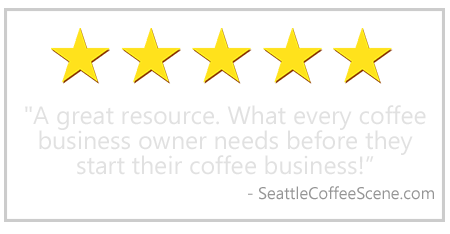
Your trust in us is important. Buy securely online with our Teachable Payment System. We have a no-hassle 14-day refund policy. Email us, and we’ll refund your money within 14 days of your purchase. Please read our testimonials from satisfied customers!

Disclaimer: The information and advice presented through this site and its products should not be considered legal or financial advice. The information within the website, affiliated websites, blogs, and any communications (electrical or otherwise) are for educational purposes only.
The author and publisher make no representations or warranties regarding the outcome or the use of the information within this website and products and are not assuming any liability for any claims, losses, or damages arising from the information.

How to start a café or coffee shop

Written and reviewed by:
Startups.co.uk is reader supported – we may earn a commission from our recommendations, at no extra cost to you and without impacting our editorial impartiality.
In recent years, the UK had been steadily moving towards the kind of well-established café culture that our European cousins are famous for. These independent brewers have taken a hit due to the ongoing cost of living crisis, but the industry is readying for growth and recovery in 2024.
In April, the UK economy grew by 0.2% thanks to a boost from the nation’s humble hot coffee makers. And, according to an economic report by UKHospitality, the sector has the potential to increase its contribution to create half a million new jobs by 2027.
It’s also now easier than ever to set up a simple store or pop-up with limited equipment – taking payment on your phone using a mobile card reader , for example. This means that starting your own café or coffee shop is becoming an increasingly accessible (and affordable) venture.
Still, future cafe owners need to be aware that consumer behaviour, and buying habits, have changed. Although convenience and cost are still big drivers, brand identity and aesthetic now play a huge part in a customer’s purchase decision – making marketing a crucial consideration for wannabe baristas.
Below, we’ll outline exactly what you need to know to take your café or coffee shop business plan from bean, to cup.
Get the latest startup news, straight to your inbox
Stay informed on the top business stories with Startups.co.uk’s weekly newsletter
By signing up to receive our newsletter, you agree to our Privacy Policy . You can unsubscribe at any time.
Read on to find out more…
How to write a café or coffee shop business plan, market research, financing your café or coffee shop business, concept, branding and design, waste disposal, equipment, utilities and supplies, taking payments, recruitment, regulations, useful links.
At Startups.co.uk, we’re here to help small UK businesses to get started, grow and succeed. We have helpful resources for helping new businesses get off the ground – you can use the tool below to get started today.
What Does Your Business Need Help With?
When writing a business plan for a café or coffee shop specifically, you’ll need to consider:
- The overall industry, and how your business will fit into it – are you catering to the growing trend for premium products? Are you offering an independent alternative in an area with a lot of chain brands?
- Competitor analysis – following on from the above, the business plan needs to show a clear understanding of your intended area and customer base, as well as how your café will cater to a gap in the market
- Sales and marketing – for a coffee shop, this means outlining how you plan to price products, along with which items will be available on the menu. Similarly, if you have any ideas for promotions or other purchasing incentives (such as deals or loyalty schemes), include them in this section. See the dedicated marketing section for more information
This is in addition to the standard requirements of any business plan, such as account information and financial forecasts, as well as details of the management structure and operations plans.
You can learn more about what to include, and get help to create your coffee shop business plan, using our business plan template page.

Sarah Heward, founder and co-owner at The Real Food Caf é tells Startups : “I had to think about the main players in the business and their backgrounds. I then conducted market research before focusing on design, including building a website and menus. My SWOT analysis came next, followed by timeline and financials.
“We made some basic errors – one was getting carried away with our enthusiasm and not doing our homework thoroughly enough, which led to some costly adjustments and mistakes.”
While choosing a convenient location is key, when it comes to running a café, coffee quality is still paramount. With the continued interest in premiumisation and sustainability in the industry, people are becoming increasingly aware of where their coffee is sourced and how it’s roasted. This connects with the growing conscious consumerism movement.
However, while some coffee brands are expanding rapidly, it appears that customers are nonetheless enticed by the intimacy of an independent coffee shop.
Starbucks struggled through the recession, and was forced to close a number of stores across the UK. Fast forward to 2019, however, and the company now has 995 UK stores – the second highest number of outlets for coffee shops in the country.
While the estimated value of the UK coffee shop market stands at £10.1bn (according to the Allegra Project Café UK 2019 report), there are still opportunities within the sector. Indeed, approximately 95 million cups of coffee are drunk each day in the UK.
What’s more, high street café culture is booming – according to data published by The British Coffee Association , 80% of people who visit coffee shops make a visit at least once a week, while 16% visit each day.
Cafe owner Heward continues: “I feel that the customers are now more into the quality of the coffee and they are conscious about reducing plastic waste. Artisan coffee producers are now more favoured over the bigger brands; people know the blends that they like and where to find it.”
Need help staying organised?
Starting a cafe or coffee shop takes time, and there are a number of steps to take.
We think project management software is a great way to keep everything on schedule. Whether you’re working alone or with other people, you can streamline processes, assign times and track progress to keep everything moving efficiently in the right direction.
Find out which project management tool we think is best .
Premises, equipment, staff… all of these things take money. Fortunately, there are a number of options available if you’re just starting a business and need to raise finance. While many people start businesses using their own savings, or money borrowed from family, there are also various other paths to pursue.
Despite the phenomenal success of Costa and other chains, coffee shops are not the kind of business to set up if you’re expecting a quick multi-million pound exit. Profit margins will only become significant if you open multiple outlets, and even then, your initial costs will be considerable. If you’re feeling particularly ambitious, it may be worth investigating if you can get a business loan to help you get started.
However, if you’re after a lifestyle business which provides you with a modest income, then setting up a coffee shop could be a great decision.
Startup loans – the Startup Loan company is a government-backed scheme, where you can borrow up to £25,000 with a fixed interest rate of 6% p.a.
Business loans – business loans are similar to startup loans, except they are not just for new businesses and don’t have the same caps.
You should also consider how you will keep track of your finances. It’s best practice to use a business bank account to separate your personal and business expenses and income, and you’ll have to if you’re starting a limited company. Nerdwallet compares leading UK business bank accounts if you need to find one.

Consider lighting, layout, and furniture when creating your café’s concept
Managing your money
Starting a business takes money and time, and accountancy software can help with both.
Whether you’re running your cafe alone as a sole trader, or with a staff, you’ll need to stay on top of your finances. If you’re not ready to employ an accountant to help out, then we suggest using an online accountancy tool.
Accountancy software is designed to simplify the complex processes related to money. From tracking your outgoings – whether that is salary or other necessary costs – to managing your taxes, you’ll find any finance process simpler with the right tools in place. Take a look at the accountancy software that we’ve rated best .
Or, take a quick look at our top recommended picks for accounting software that’s best suited to small and fledgling businesses below:
It’s not vital for you to have worked in a café before, but as with any business, industry experience goes a long way . If you don’t have any prior experience, it’s a good idea to spend at least a few weeks working in a similar establishment to the kind you want to open.
If you choose a business to learn from that’s in a different geographic area, there won’t be any issues with competition, and you’ll find people are surprisingly receptive to offering advice if you’re honest about what you’re planning to do.
When doing her research , Sahar Hashemi , the co-founder of Coffee Republic, spent a day on the Circle Line, getting off at each of the 27 stops to investigate what type of coffee was on offer. It’s important to make sure you’ve spent some time considering the business from more than just a customer’s point of view.
This includes thinking about the type of company you want to create: do you have plans to become a big brand eventually? Or do you want your coffee shop to keep its small and local vibe for the foreseeable future?
And in turn, consider what your café can bring to the scene : whether that’s a focus on a certain type of bean or drink, a particular atmosphere you want to create, or an overarching ethos (e.g. charitable, eco-friendly).
As part of the design process , you’ll need to create a floor plan – you can either hire a professional to do this for you, or use floor planning software to do it yourself. Some of the most well-known software packages are RoomSketcher and CADPro.
Essentially, a floor plan will divide the space into customer-facing areas and dedicated work spaces. Ensure you meet any legal requirements, such as building and accessibility regulations.
Also, think about the layout of the space, including decoration , along with how your staff will interact with customers. You should also consider what your logo will look like, and where it will be positioned. These are some of the main points to consider when creating your café concept, and contribute to how your coffee shop will be branded and designed.
One of the most well-known coffee brands around the world is Starbucks. For inspiration and advice that could benefit your own brand, think about the beverage giant’s marketing strategy, and the process it followed to create such a remarkable brand .
Ozkan Ozdemir is owner of Emy’s Kitchen, a Turkish cafe based in Islington. Ozdemir tells Startups said : “The idea to start Emy’s Kitchen was on our mind for many years. My mum, Emy, is a really good cook and we knew her food would be appreciated by other people too.”

Your café stands to benefit from having a website that provides the key details that your customers need to know. This includes contact information, opening hours, what’s on the menu, and where to find the café.
But a website goes beyond a business listing: think of it as an opportunity to further showcase your brand and reach a wider audience. As your coffee shop grows, you could write a blog that responds to industry developments, or highlights the social good your café is doing. Be sure to include any awards or nominations that your café may receive, too.
An ‘About us’ section is a great way to connect with customers and create a sense of community. Plus, it’s an opportunity to reinforce your café’s USP.
If you want to sell products online (such as coffee beans or bespoke cakes), then you’ll need to set up an online shop. Not sure which platform is best for your business? Check out our guide to the best ecommerce platforms for more information.
Also, if you want to host events (whether personal or private hire), then a website will allow you to easily and quickly manage registrations and bookings.
If you’re wondering how to create a business website , it can either be designed professionally, or you can use a website builder to make your own.

Location and size are key when choosing a premises
The biggest decision you’ll have to make when thinking about how to start a coffee shop is regarding your premises. When looking at prospective sites, location and size are the two main factors you need to consider.
Mintel research found that 79% of Brits purchased an out-of-home hot drink in 2017, while this figure increased to 90% for younger millennials aged 18-27.
Ozkan Ozdemir, founder of Emy’s Kitchen, recalls: “Our biggest challenge was finding a good premises. As the business was a whole new concept we had started, we didn’t actually know which area in London would be best.”
So when choosing a café location, it may be worth looking for a busy urban area with a lot of foot traffic. However, these types of properties are expensive and the amount of square feet you will be able to get will be less than if you choose a more suburban or rural location.
Equally, you may have envisioned a spacious, airy coffee and tea shop with room for large sofas and coffee tables covered in newspapers or books – bear in mind that this may come at a price.
And as the premiumisation trend continues, it may even be more profitable to forsake the perfect location in favour of investing in better beans. The important thing is to be flexible – focus on visiting a range of properties, big and small, in busy and quiet locations.
Researching your market is essential: look into the locations that are popular among branded coffee shops, as these are the areas that have been identified for drawing in a good trade. If these shops are too busy during peak times, there could be room for an independent alternative.
It is also important to know your competition. Consider what the most popular brands are offering, and how you could improve upon that.
While the size of the property you will buy or rent is intrinsically linked to its location, you should know roughly what sort of size and square footage you need. You should also be aware of how many covers (i.e. people seated) it can accommodate, as this will help you when going through property adverts.
You need to be clear about your requirements: you’ll require a large seating area, a kitchen, a coworking area, a performance space, and/or a small retail section. A rough guide to café sizes is as follows:
Think about what you need from your coffee or tea shop, what is already provided, and what you would need to add yourself. When viewing properties, take the layout into careful consideration. Imagine your service area is fully staffed, and that you’re dealing with a bustling sitting space decked out with tables, chairs, and lots of customers in need of a caffeine injection.
Ozkan adds: “After we had started the business, we realised that the location wasn’t really that important as we have customers travelling from all around London for our breakfasts.”
As part of getting your café up and running, you’ll need to ensure you dispose of its commercial waste correctly. Whether you choose to hire a private company to collect it, or opt for the service provided by your local council, this is an essential part of operations.
Some providers offer specific services for the hospitality sector, such as collecting glass, food waste, or coffee grounds. To help you choose a provider, read our guide to the best waste management companies .
Of course, it’s ideal to reduce the amount of waste created in the first place as much as possible. Not only does this help to save money (less waste means fewer collections), but it’s good for the planet, too. Look for a provider that offers coffee cup recycling, and learn more about business recycling in general.
Before you negotiate the lease or purchase of a property, you must also check what commercial classification it currently falls under. If the property does not already have the correct classification for a coffee or tea shop, you will need to get planning permission from your local authority. You can use the Gov.uk licence finder to help you.
A café or coffee shop will most probably be classified as an A3 use class, although this will depend on the local authority. Planning permission for A3 use permits the sale of food and drink to be consumed on premises. For example, if you take on a property with a different class (e.g. a shop, which falls under category A1) and want to use the premises as a café, you’ll need to get the planning permission to change it to an A3 use class.
To learn more, and to apply for a licence, visit the Gov.uk page on food business registration .
Here, we outline the equipment, utilities and supplies you’ll need to start your own coffee shop. We’ll also look at the process of sourcing equipment, utilities, and suppliers.
Opening a café or coffee shop requires a lot of equipment. Some of it you’ll need straightaway, while other items you may be able to get further down the line, depending on your business requirements.
Essential kit includes:
- Coffee makers – espresso machines, as well as drip and cafétieres, plus equipment for any other specific drinks you offer e.g. pour over/filter
- Coffee grinders – ensure these are suitable for commercial use
- Cooking devices – e.g. ovens, toasters, sandwich presses
- Cooling and storage – e.g. refrigerators, freezers, shelving/cupboards
- Food containers – for syrup, ingredients, milk etc.
- Security devices – e.g. alarms , CCTV cameras , water detectors
- Payment equipment – this includes a card reader, an iPad and/or a till, plus software. For more information on payment equipment, read our guide on small business POS systems
You can choose to buy some items outright from the beginning, or you can hire them on a rental or lease basis. For example, espresso machines are notoriously expensive, and it may be more sensible to rent one. By contrast, food containers are likely to be cheaper to purchase.
Utilities
You’ll need to get connected with business gas and electricity suppliers – be sure to compare energy suppliers to get the best packages for your small business.
Supplies/suppliers
You’ll need to think about the type of coffee you’ll choose for your café. Consider which (and how many) strengths will be on offer, and do your research about where it comes from and how it’s produced. When choosing suppliers, be sure to do taste tests (with coffee that’s been correctly prepared) so that you can know what your customers will experience.
Also, check out a supplier’s record – have they won any awards or other industry recognition? Are they FairTrade and/or organic certified? Be sure to review the contract from a potential roaster as well – would you prefer an exclusive supplier, or to be able to use beans from multiple roasters?
Beyond this, the supplies you’ll require will depend on the type of café you run. For instance, the supplies used in a café that specialises in plant-based foods compared to a coffee shop that offers rum and other alcoholic beverages (like London-based Grind ) are going to be very different.
You’ll also need to factor in non-edible supplies, like plates and cutlery, including both those used in-store and for takeaway. Plus, take into consideration the aprons or other items that your staff will need to wear or use.
You can find suppliers in the following ways:
- Asking other small business owners for recommendations
- Attending trade shows and industry events (such as Caffé Culture , Coffee Shop Innovation Expo , and European Coffee, Tea & Soft Drinks Expo )
The Real Food Cafe founder, Sarah Heward, advises: “Speak to industry leaders with a lot of experience – they will challenge your thinking and not just tell you what you want to hear! Listen to them and prepare to be flexible
A card machine is an essential piece of equipment for your café. While cash is still popular, it’s good business sense to offer customers as many payment options as possible. Read our guide on how to take card payments to learn more.
As well as the device itself, you may need to enable online payment methods, such as a payment gateway . This will be the case if you’re offering online ordering or other ecommerce options.

Baristas, kitchen staff, and waiters are some of the roles to hire for in a café
Any business in the catering or hospitality industries involves hard, physical labour. Unless you can afford to employ staff from the outset, running a café will involve standing on your feet for the vast majority of the day.
Taking on staff is a highly legislated area, so you’ll need to understand and follow regulations on everything from health and safety to managing holiday requests . How much of the process you do yourself, and how much you outsource to a HR company , will depend on you, your vision for your business, and your budget.
Some top tips to consider when recruiting in the hospitality sector include:
- Culture – what type of atmosphere do you want to create, for both your staff and customers?
- Attitude – café staff are the face of your business, so it’s crucial to hire people who reflect its ethos and brand
- Experience – want perfect latte art with every pour? In need of standout dishes? If so, seek out experienced candidates for more skilled roles (such as baristas and chefs) so that your café can offer top-quality produce from the outset (and while other team members receive training)

Product images and other visual, shareable content are great for social media marketing
Emy’s Kitchen owner, Ozkan Ozdemir points out: “The food industry is very hard and you only have 20-30 mins to make customers happy, so you need a good team to achieve that goal.”
There are a number of ways to promote your café, including:
Social media
Loyalty programmes
Traditional marketing
When it comes to marketing a café or coffee shop, be sure to use social media. Creating content tailored to your target audience and the platforms they use is an essential part of social media marketing .
Whether you film your baristas making the perfect cup of coffee, or share photos that your customers have taken, this type of business is highly visual – making it ideal for social media platforms. But it’s more than that just advertising – social media also offers an opportunity to engage and interact with your customers.
Whether you opt for a card that’s stamped per purchase, or a digital app that allows customers to collect points, loyalty programmes are a key part of marketing a café or coffee shop.
Not only is this an incentive for people to return to your coffee shop, but if you use a digital system you can collect valuable information as well, such as common orders or popular visiting times.
While it’s easy to focus solely on digital marketing, remember that cafés and coffee shops are often central places in a local community. Be sure to connect with people face-to-face as well.
Options include printing and handing out flyers in your local area, as well as printing banners and posters. Plus, reach out to nearby offices and other companies to let them know you’re new in town.
Currently, there is no law that states you must undertake formal training to open a café or coffee shop.
However, you must ensure that you and anyone else working with food at your business has the appropriate level of training and/or supervision to do their job properly. The legal responsibility lies with the business owner, so make sure you have all the information you need.
You’ll need to be clued up on the basic principles of food preparation. Make sure you check out our restaurant and sandwich shop guides, as many of the principles for those kinds of businesses will also apply here.
The Food Standards Agency (FSA) is the body appointed by the government to be responsible for all food safety standards. The FSA can provide you with advice on all food hygiene matters, and offers an information pack called ‘Safer food, better business’ , which will help you to comply with the law and make your premises safe for the public. The publication covers key aspects of serving food, including contamination, cleaning, chilling, cooking, management, and keeping a food diary.
Your business must also be registered with the local authorities. You can and likely will face inspections in the future, and a failed inspection is bad for your café in a number of ways: either legally (you could be closed down), in terms of business (bad publicity and referrals) or morally (as people could be taken ill or even die from contaminated food).
In order to avoid such pitfalls, you should follow the Hazard Analysis Critical Control Point (HACCP) . This is an internationally recognised and recommended system of food safety management that focuses on identifying the ‘critical points’ in a process where food safety hazards could arise, and puts steps in place to prevent things from going wrong.
Take a look at the rules and regulations section of our catering guide , as the same restrictions on food preparation will apply.
Your café or coffee shop will need to be appropriately insured – this is to protect you, as well as your customers.
There are a range of providers out there who can offer cover that is tailored to your unique business requirements. However, you’ll usually need the following types of insurance:
- Building contents – this protects your café’s stock
- Business interruption – with this type of cover, you’re insured for profit losses if you’re made to stop trading temporarily
- Employers’ liability – cover for the health and safety of your employees
Sarah Heward, founder and co-owner at The Real Food Café has this positive final message for Startups readers comments : “Starting your own business and seeing it go from strength to strength is an incredible sense of achievement. Hopefully, the long-term financial benefits make it all worthwhile.”
Here’s a recap of some of the most useful links from throughout the article:
- Gov.uk Licence Finder
- Gov.uk Food Business Registration
- Safer food, better business
- HACCP guidance
In addition, check out the links below to learn more about relevant industry organisations and events:
- British Coffee Association
- Specialty Coffee Association (UK Chapter)
- Caffe Culture Show
- Coffee Shop Expo
- European Coffee, Tea & Soft Drinks Expo
Startups.co.uk is reader-supported. If you make a purchase through the links on our site, we may earn a commission from the retailers of the products we have reviewed. This helps Startups.co.uk to provide free reviews for our readers. It has no additional cost to you, and never affects the editorial independence of our reviews.
- Featured guides
Written by:
Related articles.

Small Business UK
Advice and Ideas for UK Small Businesses and SMEs
How to start your own coffee shop

Keep reviewing your coffee shop business plan

Fancy opening your own coffee shop? We explain what you need to know about cash flow, hiring staff and of course, finding the right coffee.
Starting a coffee shop is at once exciting and daunting – there’s a lot to factor in before you even start writing your business plan.
This guide will take you through the main steps of how to start your own coffee shop, with comments from experts in the industry and links to further information.
What should be included in my coffee shop business plan?
The first part of your start-up is always the same: your business plan.
Your coffee shop business plan will look very similar to any other. It should include:
- Your business proposition
- Unique selling point (USP)
- Target customer
- Marketing strategy
- Sources of funding
- Financial forecasts
What’s different with a coffee shop is that you’ll need to talk about what kind of coffee you’re going to use and what’s included in your menu. Is it food or drink that you expect to be your biggest money maker?
Along with the proposition, you should include your business’ purpose. Many businesses now launch with an ethical core. Not only will having your purpose in your business plan keep you on track with fulfilling your goals, but it will also help to attract ethical investors.
You must have these points nailed down before you approach partner companies. “The first questions we ask are, ‘What food are you going to serve? What kind of volume do you want to do?’ Sometimes they haven’t quite got that down on paper,” said Lloyd, founder of takeaway packaging supplier, Catering24 . “They need to work out the portions of food to costings, to then work out what volume they need to do per day to cover their premises or their van rental or pitch space and rental.
“It’s the nitty gritty details that we try and get down to because sometimes we can offer them a container that’s 30p per portion or one that’s 10p per portion. That starts to make the difference between whether the takeaway or coffee shop is actually going to be profitable from day one.
They need to know the cost per unit of everything that it takes – from ingredients all the way through to a stirrer to go with that coffee. It must be all priced in. “I can go to a van on the side of the road and get a £1 coffee from a polystyrene cup,” said Lloyds. “The cheap cup costs 10p and is not very ergonomically friendly. It’s actually got quite good insulating in the cup. If I go for that same quality of coffee in a 15p cup, I can sell it for £1.70 from the same brand, but it’s the perception of value that the customer is getting. Now it’s paper, it has a better fitting lid, you can actually sip out of it without it going over your clothes.”
Your business proposition and USP
Coffee shops are a popular trade and it’ll take ingenuity to stand out. This is where your business proposition and USP come in.
People watching, a popular pastime in cafés, could be illuminating here. “If you find this shop that you like, grab a coffee, sit outside for a few hours and just see how many people will pass,” said Stuart Wilson, founder of Lost Sheep Coffee. Yes, that’s a bit weird. But you can get an idea for them and who your target customer is.”
It’s also wise to know about current and upcoming trends in coffee and beyond. “For me, the next big thing is going to be your speciality coffees and your iced coffees. If I was a coffee shop owner now, I’d be planning for my iced coffee offering to be strong next year,” said Wilson. “All those sorts of things and your alcoholic coffees, like espresso martini. We talked to a few brewers actually about doing coffee-infused drinks, beers and stuff.”
Lloyd has noticed another trend coming from the rise in takeaways: “Afternoon tea boxes are massive at the moment. I Imagine someone starting out at the minute might not think of that first thing. They might think about takeaway coffee, because that’s what the norm is for a coffee shop.”
Décor can bring people into your coffee shop and support your USP. Think palm trees, retro arcade games or neon signs. For the basics, you can keep costs down buying furnishings second hand – it has added bonuses of being sustainable and giving your coffee shop a quirky charm.
Small Business Pro is the ideal tool for you when you’re starting your business. It will help with the heavy lifting of managing customers, taking payments, insurance, finance and HR, plus you’ll get a host of personal wellbeing benefits.
You can find out more about Small Business Pro here .
Where should I should set up my coffee shop?
This will depend on a few things: where you’re based, what units are available to you and what your goals are for the business.
Most will go for a traditional coffee house set-up. This a bricks and mortar café with indoor seating. Finding a location rests on what you want your business to be and where your customers are. Try Rightmove as it can show you spots that could potentially become your coffee shop while sites like Floorplanner will help you visualise where everything will be placed.
The other option is somewhat more mobile. Having a cart, kiosk or van has the advantage of being in a busy area like a train station or bus terminal for a much lower cost. Plus, you can opt for a fixed spot every day or, in the case of the cart or van, choose different spots and hit popular events like festivals. Lost Sheep Coffee started as a micro van back in 2012. Wilson tells us more: “For us, the cheapest way to do our [then] hobby was small, hence why it started with a three-wheeled coffee van. I set the whole thing up for less than £10,000. We were able to get a pitch slap bang in the middle of the high street in Canterbury, which, to this day, people still remember the cart. From a marketing perspective, it was fantastic.”
Why do people go for bricks and mortar coffee shops? “I think to be honest, it’s tradition,” said Wilson. “A lot of people don’t think of kiosks as a proper business. It’s just like a glorified market. Some people want the bricks and mortar, if you will, to feel validated.
“A kiosk doesn’t always bring that for someone. They are becoming a lot more popular now that you’ve got your Costas and your Greggs in the service stations. It has been popularised in the last four or five years.”
How much money will I need?
Start-Up Loans says that it can cost £20,000-£100,000 to start up a coffee shop depending on its size, offering and location.
Though it needn’t be as pricey. “A lot of people these days are taking on affordable units. So actually, they can start becoming a bit more accessible,” said Wilson. “A good selection of people who are starting out as a coffee shop these days are taken on premises that might be rates exempt, basically, because of the current government’s side of things.”
These could have perks like giving you three months free rent. They’re already fitted with water and electricity too. “I’ve got a customer who’s just launching one in Folkstone and she’s pretty much doing it for less than £15,000. It’s a full-size shop,” he added.
There are properties like this in the south east of England, but you should be prioritising areas that you know and like. If you do find such an affordable unit, just ask what your landlord can do for you.
However, it can be done more cheaply if you opt for a kiosk. “That chaos in Canterbury, that is a lot of work still done by me to be honest with you, but it’s still less – more like a £30,000 project” said Wilson. “The shop we had in Ashford was a 750 square foot shop and to kit that out from a shell with everything came in at around £15,000-60,000.”
He added that they’re looking into a bricks and mortar shop and it would cost £100,000 a year just on rent. The kiosk, just around the corner, costs a fraction. It could be worth going for the full shop as they generate more revenue. “You’ve got the kiosk, which you’d take X amount a year, and then your shop should be probably taking more like 700,000x,” said Stu. “You pay more, but you actually end up with a higher revenue stream.” Again, weigh up the costs and see which option works best for you.
As for your overall cash flow, if the rent is 15 per cent more than your projected rates and sales, it’ll be difficult to make a profit. Staff should not exceed 50 per cent of overheads, according to Start Up Loans.
Choosing the right coffee
Now, arguably the most important part of your coffee shop business.
Are you going single origin or a blend? Does the target customer decide the coffee or vice versa? Are you targeting regulars or passing trade?
“The product itself needs to be relevant to the to the person who owns the business, but also the person drinking it,” said James Sweeting, founder of coffee roasters, Lincoln & York . “These tend not to be one off purchases. They have a very high level of repeat client. I’m guessing that 90 per cent are likely repeat visitors.”
He added that you should really know your customer. “I think these days, you tend to think of an artisanal-type coffee shop, with hand-roasted coffee and healthy cake and all that kind of stuff,” said Sweeting. “Of course, it could be a coffee shop in a shopping centre, or it could be in another format that’s not necessarily Metropolitan. That’s why the coffee needs to be relevant.”
He does stress that there should be a ‘high-quality aspiration’, no matter if the coffee is espresso-based, filter or cold brew. “It should probably be a 100 per cent Arabica coffee blend, or singularity, or a blend of Arabica and Robusta beans that will produce a great espresso coffee. Quite often, you do need an element of reverse engineering to do that. Anyone who says otherwise doesn’t really know the full 360 degrees of the coffee business.”
The coffee shouldn’t just reflect you as a business owner, it should also reflect the values and purpose of the business, as discussed earlier. If you’re claiming that you’re ethical, you need to root through your supply chains to make sure they have the same standards as you.
“You’ve got to have an idea of the standards – where it’s grown, some story element. Have you paid a fair price to your supplier? Has the supplier, in turn, paid their fair price to the grower?” said Sweeting. “if you buy something cheap, somebody has possibly been exploited. Can you defend yourself as a business if somebody walked in and said to a coffee shop and asked, ‘Where do you get your coffee from?’ If you can’t at least give an answer, you haven’t done the homework.”
A quick way to spot a supplier or roaster’s standards is to look out for certifications, which they’ll likely display on their website. Fairtrade means that the group of growers has been paid a known price level as well as covering elements of training and origin. Rainforest Alliance is more focused on the environmental management of the growing.
You should ask your supplier how the coffee will be roasted and how it behaves under certain types of roast. “You should ask questions on along those lines and say, ‘Well, what difference does it make if you roast it slowly and roast it dark? What does that do to the taste? And what will my consumer think of that when I make coffee to it with themes like that?’” said Sweeting.
Don’t forget to factor in the freshness of coffee. “There are one or two myths around whether coffee should be freshly roasted or not,” he added. “Well, of course, if you see ‘freshly roasted’ on a pack, well, it was definitely true when the rest of the pack was freshly roasted. By the time the consumer gets it, it might not be the case.
“Now, for a coffee shop, the ideal gestation period is probably two weeks to six weeks. The reason for that is and you could say well, ten days to 30 or 35. If coffee is very fresh, i.e. roasted one day, then consumed the next, the blend itself hasn’t had chance to settle down. When you get it into a grinder, you know the grinding characteristics will be different if you roast today, it’s a day old versus one that’s ten days old.” Ensuring it’s settled for around the same period each time will give your coffee more consistency, giving a consistent taste experience to your regulars.
Finally, there are questions about what certain roasters can offer. Some of the craft roasters can do very small quantities, perhaps up to six kilos. However, other businesses would want to be able to drop off around 20 kilos plus artillery products to make it worthwhile. “There’s a balance between pure coffee freshness and sensible logistics as well,” said Sweeting. “I think a coffee shop probably should be able to get a delivery every fortnight.”
If you’re struggling to commit to one supplier, you can sample a variety to see what their offerings are like. “Another good little way of coming across roasters you might want to work with is setting up subscription services,” said Wilson. “There are so many companies now that will send, say, three bags a month from different speciality coffee roasters from around the country. You could look into setting up a speciality coffee shop. Sign up for one of these for a few months or go old school and pick up the phone and just ask for samples.”
What coffee shop equipment should I be buying?
Now you want to ask yourself what equipment you’ll be buying and whether it will be new or second hand. It’s also important to look at the lifespan or warrantee.
Depending on what you’re offering, this could include:
- Espresso machine – £1,500 to £10,000 to buy. You can also lease for around £5 a day
- Cooking appliances
- Water softener, depending on location
- Coffee bean grinder
- Fridge/freezer
- Toaster/panini press
- WiFi router
It’s not just the purchase you’re thinking about. It’s also what you need to clean your equipment and how costly that’s going to be time-wise. “There are a lot there’s lots of great choices of coffee machines out there. It can be fully automatic, or semi-automatic or fully manual, but maintain them very well. It’s got to be scrupulously clean,” said Sweeting.
Some firms offer hospitality of coffee shop-specific point of sale (POS) systems. Read more at The essential guide to point of sale (POS) systems .
Finding the right suppliers for goods other than coffee is overlooked. Spend some time researching different suppliers, focusing on their story and values as well as their products.
“Try and get an idea of their history, how many years they’ve been trading. You want them to be big enough to support you when you’re starting out,” said Lloyd. “The long-term supply is lots of knowledge. They usually have customer service and salespeople that have been speaking to businesses for decades. Often, they have great ideas.”
Look for positive testimonials and third-party certifications to tell you what your supplier is like. “These are little cues to tell a customer that this is a reputable company, something that they can rely on,” said Lloyd. “They’re doing things properly in terms of sourcing supply. These products come from all over the world, sometimes it’s very difficult to for a café or coffee shop, to know where their products genuinely come from.”
Hiring staff and training
The size and goals of your coffee shop will help you decide which staff members you need to hire and who comes first.
You’ve got baristas and chefs/cooks of course, but your staff could extend to managerial roles, marketing and accounting, to name three. If you’re hiring them, your manager and marketing specialist should be recruited first, according to Rebecca Siciliano, managing director of hospitality recruitment firm, Tiger Recruitment . They’ll help you lay out the ground-level stuff before your café even opens.
It’s a good idea to have barista training yourself, even if you’re not the one making the coffee. But your baristas are incredibly valuable to your business – coffee shop owners often look for somebody who is already trained. However, training can vary, so it’s up to you to ask the right questions. “If it’s a coffee shop [they worked at before], fine.” said Wilson. He would then ask for the name of the coffee shop and look them up on Google and/or TripAdvisor to read the reviews and see pictures of the coffee. “You know, if it’s a greasy spoon or something, and they’ve made a couple of coffees that are frothy, that’s not barista training,” he said. “If they’re working for a well-known coffee shop, and you know they take their training seriously, then great.
“I then say, ‘Have you got any photos of your art?’ With someone who’s a barista who’s proud to be a barista, I guarantee you has photos on their phone. I then say, ‘Can you email it to me?’”
He added that the final thing during interview is getting them on the machine to make a coffee in front of you – the one they’re most comfortable making. “You can see what level of training they’re going to be at straight away,” he said.
If you can’t get hold of staff who are already trained, speak to your coffee roaster. They may offer training themselves or at least be able to give you some reputable names.
Attracting and retaining staff can be a real task across the hospitality industry, so try and offer what perks you can. “You have to offer a little bit more to be able to attract those candidates, like higher pay,” said Siciliano. “Then it’s also some of the other benefits. In fact, there’s one coffee shop we know of where they’ve got one designated day that all staff have been told that they can have the day off, just to acknowledge that they know how hard they’ve been working.” Flexible working is important too, with staff looking for leeway to have days off for important events or to be able to work during the day and have evenings off.
She also recommends posting roles on social media to target people who may already be interested in your brand.
With all this said, you should avoid overstaffing. “I’ve walked into a new café and they’ve got a 15-seat café and they’ve got five people working,” said Wilson. “The biggest, quickest way to kill any new business is to waste all your money on staffing costs. I mean, don’t get me wrong, you want to recruit people, but you’re no good to anyone if you go out of business.”
One way to tackle this is to hire temporary staff for busier periods. “Temporary staff can be ‘dialled up’ and ‘dialled down’ according to demand,” said Novo Constare, co-founder of Indeed Flex . “This makes them invaluable during busy periods when it’s hard to find enough permanent staff. Their flexibility means there’s no requirement to keep using them during quieter periods.
“Having ready access to good temporary staff also gives a coffee shop a defence against staff absences. A big pool of trained, vetted – and above all, available – workers can save the day at short notice if the shop’s regular staff call in sick.”
Legal considerations
This section will be dry but could save you an inordinate amount of hassle later on.
First off, register your business. This can be done as a limited company, as a sole trader or a legal partnership.
> See also: Should I go sole trader, partnership or limited company?
You must register your coffee shop through the government website at least 28 days before opening. It’s free to register and you can’t be refused.
Next, coffee shop licences. If the premises is not already classed as a coffee or a tea shop, you’ll need to get planning permission. Coffee shops will mostly be classed as an A3 premises which permit food and non-alcoholic beverages to be consumed on the premises. Find out what need with gov.uk’s licence finder .
There’s a lot of health and safety paperwork to get through. Visit the Food Standards Agency (FSA) for more information about your business’ needs.
The right insurance is crucial and there are a few different types.
Public liability insurance : Cover for claims made against you from employees or clients if something happens to them or their property is damaged as a result of your work. It can be an event which took place on your premises or off-site
Employers’ liability insurance : Protects you against claims for accidents involving staff and customers and covers issues with appliances and other breakages.
Deterioration of stock insurance: Covers damage to goods stored in specified cold storage spaces, which can happen because of a change in temperature caused by a breakdown of refrigeration equipment or accidental damage to it.
Contents insurance: Covers the contents of your coffee shop if they’re lost, damaged or stolen, including fixtures, fittings and your employees’ personal possessions.
Business interruption insurance : Could cover Covid-like events as well as weather-based events like flooding.
Different insurers will have different core packages and add-ons. Remember that, if applicable, your business insurance will need to cover takeaways as well as your delivery drivers. This also applies to alcoholic takeaway drinks and the provision of late-night refreshments in your establishment.
A couple of extras, should you need them. Get an entertainment license if you plan to play music in your caff. See PRS for more .
Finally, know about your staff’s employment rights – this includes working hours, holiday and other leave.
Marketing your coffee shop
Let’s start off with your branding – make sure it’s consistent online and offline. Having an instantly recognisable logo that you can put on all of your marketing material will help customers remember you.
For your offline marketing, this could be well-placed signage like bus stop advertising near your site. You’ve likely seen something similar with fast food restaurants who have signs with their logo and an arrow pointing towards their nearest restaurant.
Entice locals and passing trade into your shop with free samples of cake (Covid restrictions apply at time of writing). Drive more brand loyalty by joining a food event or hosting a coffee making/bakery classes. This can be in-person or online. Give participants an exclusive discount on their next coffee and cake or your in-store products.
Of course, it’s essential to establish regulars – they’re a great source of word-of-mouth advertising too. Treat them well by getting to know them and learning their regular order. Try getting in contact with local groups such as parent and toddler clubs or a nearby sports team – you can look at meetup websites for this – and offer them a regular space at quieter time to build up that customer base, making yourself the go-to for the locals. Having discounts and deals for quieter times and a loyalty scheme for regulars will drive footfall.
As for your online offering, you really need to consider having a website and being on at least one social media platform. This is especially true if you’re in the city and have a lot of competition. An easy starting point is getting on Google My Business. This is the widget you see when you type something like ‘coffee shops near me’ into the search engine. It includes your opening hours, images of your café and customer reviews.
Make sure you have a user-friendly and detailed website for customers to visit. They can find out more about you and your business story as well as your menu and info on upcoming events. We’ve got loads of guides to building a website , but here’s one tip: remember your keywords. This is what people will be searching when they’re trying to find businesses like yours. For example, include ‘afternoon tea’ and ‘high tea’ if that’s one of your main draws.
Take beautiful pictures of your food and drink for your website and social media. Customers will get a better sense of what you’re offering, and pictures may tempt them into coming to your café. Driving loyalty is important online too – you can achieve this through your newsletter. Offer an exclusive discount off their first booking or order when they sign up.
Plan for bigger events when your coffee shop will be busy. “They need to be looking ahead to Christmas. Big style,” said Lloyd. “This Christmas will be the biggest hospitality boom we predict for years. You need to be looking to Christmas and what’s going to make you unique.” He suggests speciality coffees like gingerbread lattes or other special syrups.
“We do our own Christmas cups for the independents. They can then play a massive part in the café’s own marketing.”
He warns of a ‘humongous drop in January’. “You’ve got to make it really work October, November, December. Then cash off, have a good Christmas. February and March will be when it starts to pick back up again.”
So, is opening a new coffee shop right for me?
As you can see, setting up a café is quite a process but don’t let that put you off if you believe in your idea.
Reading industry maedia like Caffeine and going to coffee events with other baristas and roasters will give you an introduction to the community. If you’re still unsure, try working in someone else’s coffee shop for a few days to gauge if it’s something you could do long-term.
For a transition into the coffee shop world, you could open a franchise such as Costa instead. Read Buying a franchise: the key considerations to find out more.
Trade Shows
Food & drink trade shows for coffee shop owners, further reading.
Five successful business ideas for 2021

Anna Jordan
Anna is Senior Reporter, covering topics affecting SMEs such as grant funding, managing employees and the day-to-day running of a business. More by Anna Jordan
Related Topics
Related stories.

Should you register as a sole trader or a limited company?
Mart Abramov, CEO of TaxScouts, shares the positives and negatives of being a sole trader or a limited company, so you can make the best choice for your growing business.

The best cities in the UK to start a street food business
Setting up a street food business can be tough but incredibly rewarding and profitable. Here are the best cities in Britain to start.

List of small business associations and networking groups
Business associations and networks offer SME owners and entrepreneurs useful resources to help them grow their companies.
Aaron Hurst

How to negotiate a commercial lease – tips for negotiating with a landlord
Solicitor Simon Maddox tells you what to look out for when negotiating a commercial lease agreement
Simon Maddox

A small business guide to going freelance
In this piece, we look at the main considerations when going freelance, from procedural advice to managing your work-life balance.
Starting a Business | How To
How to Start a Consignment Shop in 9 Steps
Published January 12, 2022
Published Jan 12, 2022
WRITTEN BY: Meaghan Brophy
This article is part of a larger series on Starting a Business .
Starting A Business?
Get your free ebook.
- 1 Choose the Right Type of Consignment Shop
- 2 Create Your Budget
- 3 Create a Business Plan
- 4 Select a Storefront
- 5 Acquire Merchandise
- 6 Design & Outfit Your Store
- 7 Advertise
- 8 Hire & Train Employees
- 9 Plan & Launch Your Grand Opening
- 10 How to Start a Consignment Shop FAQs
- 11 Bottom Line
To start a consignment shop, as with any business , you’ll need a prime storefront and a strategy for acquiring customers and merchandise. It involves choosing a niche, establishing a budget and business plan, finding merchandise and laying out your store, advertising, staffing up, and, finally, opening to the public.
Starting a consignment store can cost up to $10,000, according to a commonly reported figure from Entrepreneur, with average salaries for consignment shop owners ranging from $40,000 to $60,000. Here’s how to start a consignment shop―as a brick-and-mortar store―in nine steps.
1. Choose the Right Type of Consignment Shop
If you’re wondering how to start a consignment shop, the first step is to narrow down exactly what kind of store you want to open . The most successful stores cater to a specific audience and have a specialty or focus area that helps them stand out from other online or offline retail competitors. To make the most money with your new business, choose a product area that is in high demand and/or hard to find, to lure shoppers into your store.
Designer & Luxury Goods
The secondhand luxury and designer goods market was worth an estimated 33 billion euros in 2020 (about $37 billion), a figure expected to continue to rise. These are popular items because shoppers can purchase products that may otherwise be outside their budgets. People looking to get rid of gently worn designer products often opt to sell them to a consignment store rather than donating to get a partial return on their investment.
Popular designer goods to sell include watches, jewelry, sneakers and other footwear, handbags, wallets, jewelry, and apparel.
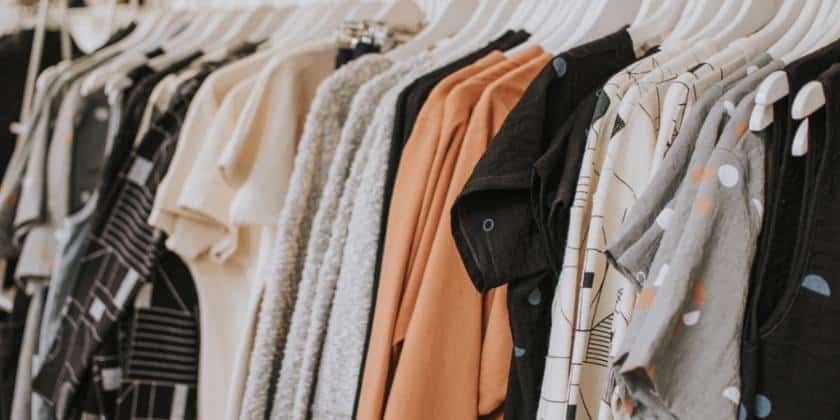
The apparel resale market will hit $77 billion in the next five years , according to ThredUP.
LXR is an online consignment shop for luxury and designer handbags and accessories. The store focuses exclusively on authentic designer label goods. It also purchases used goods to sell on its site.
Apparel & Footwear
Clothing and shoes are popular secondhand items, even if they’re not expensive designer-label. More than three-quarters of people who’ve never done it would consider selling secondhand clothes. They’re relatively easy to source—more than 95% of the 36 billion tossed clothing items each year could be salvaged—and they’re items for which there will always be demand.
In fact, clothing is the most-purchased secondhand good . And as much as 7% of the average person’s wardrobe consisted of used items in 2019, a figure expected to hit 17% in 2029.
The largest target market for this type of consignment shop are Gen Z women, according to ThredUP. So keep those styles and trends in mind if you’re going after that audience.
Omnia is an excellent secondhand apparel and accessories shop to check out for inspiration. It sells a carefully curated selection of used vintage goods.

Secondhand books are another popular consignment category. In addition to regular paperbacks and hardcover books, some used bookstores deal in rare books, such as antiques and signed copies, or specialty books like cookbooks and textbooks.
Popular websites like ThriftBooks and Better World Books are examples of online retailers that have found success swelling used books. Puerto Rico-based El Coquí Bookstore sells used books in-store only—shoppers have to visit the shop and explore the wide array of books in a variety of languages.
Children’s Wear
Clothing for children and babies is a popular and profitable type of consignment store. Since parents have to purchase clothes for growing children very often, many turn to secondhand stores as an affordable option. Plus, you’ll have a steady supply of parents looking to sell their children’s gently used clothes.
Once Upon A Child is an example of a secondhand shop that sells both children’s clothing and toys. The brand operates several retail shops as well as a full online presence.
Online Consignment Shop
During the past several years, online consignment stores have become very popular, especially for apparel and accessories. Starting an online consignment shop gives you a wider customer base than a local store.
Check out these resources to help you learn how to start selling online:
- How to Start an Online Store
- Best Ecommerce Platforms
- How to Set up Click and Collect
One key thing to remember when starting an online consignment shop is that you’ll need to photograph each item individually. This can be time-consuming, so it’s important to weigh how much time it’ll take you against the opportunity for profit.
Pop-up Consignment Shop
If you’re not ready to commit to a full-time storefront, having a pop-up business is a great way to test products and locations before diving in. If you’re looking to start a consignment business as a part-time venture or side gig, having temporary stores is a good option as well.
Pop-up shops come with less commitment, so they’re a great way to get into retail without all the overhead of running a permanent storefront. This is exactly the approach that Grapevine Events takes with their secondhand goods pop-up shops. As a result, they’re also able to offer higher rates to consignors.
2. Create Your Consignment Shop’s Budget
Once you know what kind of store you want to open, the next step in how to start a consignment shop is setting a budget for your store . To set your budget, first consider your current income and savings. What can you save and set aside for your new business venture? How much outside funding will you be able to get from personal loans, business loans, business credit cards, and so on? Opening a consignment business requires a lot of upfront cash. Once you’re open, it will take time to build your sales volume.
Next, estimate your expenses for opening your store. Include how much you can spend on a storefront, outfitting the inside of your store, signs, and marketing, and your initial product purchase.
Now, estimate your monthly expenses for once you open. Include set bills like rent, phones, internet, payment processing, and so on. Also factor in advertising budgets, employee salaries, merchandise purchase orders, and other store supplies.
The hardest part of setting a budget for a business that is not yet open is predicting your monthly sales volume. This is especially hard for apparel and retail businesses as sales can fluctuate drastically, depending on the season, holiday, weather, economy, and consumer confidence. According to the Retail Owners Institute , used merchandise retailers had an average inventory turnover rate of 4.1 in 2021. That means they sold through and replaced all of their inventory about four times throughout the year.
Keep that number and your total inventory value in mind when estimating your monthly sales. Err on the side of caution, and plan for lower sales when you open, so that you have enough cash flow to cover expenses. Subtract your estimated monthly expenses from your estimated monthly sales, and that will give you an approximate monthly cash flow for when you open.
Pro tip : Retail is an extremely seasonal business. Most retail businesses bring in a ton of money around Christmas and the winter holidays. There are also spikes in revenue around back to school shopping, and spring holidays such as Mother’s Day and Father’s Day. Your monthly sales can vary, so always have extra cash on hand to cover slower months.
3. Create a Business Plan for Your Consignment Shop
Once you figure out what kind of consignment business you’d like to open, you’ll need a solid business plan to piece together all your ideas and form a strategy for making your store profitable. If you’re seeking outside or startup funding such as a bank loan, your business plan will be evaluated during the approval process.
Here are the nine elements found in a typical business plan :
- Executive summary : An introductory paragraph outlining your consignment shop’s purpose, mission, and why it will be successful.
- Business description : Describe what need or market hole your consignment store is filling in the community, who your customers will be, and the talent on your team.
- Market analysis : Write an overall outlook on the consignment and resale industry including trends, what successful competitors are doing, and what your strengths will be.
- Organization and management : Outline who will be running your business and the experience your team members have in retail, consignment, or your store’s area of specialty.
- Product line : Outline what kinds of products you will sell, how you will sell them, and where your supply will come from. Include research on why you’re selecting those products, such as sales trend data.
- Marketing and sales : Describe your general marketing strategy and your plan for attracting and retaining customers.
- Funding requests : If you need outside funding, outline your needs and specify exactly how you will use the funds.
- Financial projections : Detail how your business will become stable and profitable, including a projected financial timeline of at least five years. If you are borrowing funds, include a plan on how you will be able to repay the loan.
- Appendix : Use this space for any supplemental documents, such as logo or branding designs, sketches of what your consignment shop will look like, credit histories, licenses, permits, etc.
When writing a business plan, use the format and software you’re most comfortable with. Many people use a traditional word processor like Microsoft Word or Google Docs. You can also create your business plan in a presentation format using PowerPoint or Google Slides. There are also business plan software programs that offer templates and guide you through the process.
Choose the Best Legal Structure
Choosing a legal structure for your consignment business is important because it dictates how you will collect and report taxes, your level of personal liability, and how you will get paid from your business. There are many types of legal structures, but the three most commonly found in retail are sole proprietorships, limited liability companies (LLCs), and corporations .
- Sole Proprietorship
- Limited Liability Company
- Corporation or C-corp
If you don’t set up a legal structure for your business, this is the default. Operating under a sole proprietorship essentially means you’re doing business as an individual and, therefore, are not separated from your business in any way. Sole proprietorships are popular options for freelancers, business consultants, and other individuals conducting low-risk and low-visibility work by themselves.
With sole proprietorships, your business revenue is considered personal income. This means you will pay sole proprietorship taxes based on your personal income bracket. While you are subject to self-employment taxes, you do not have to pay any corporate taxes, which is a plus.
However, sole proprietorships also come with greater risk because you and your business are one and the same. Your personal assets, such as your house and car, are at risk if there is any kind of lawsuit against your business or if you declare bankruptcy.
LLCs are legal structures for small businesses that protect your personal assets, such as your house and car, in the case of lawsuits or business bankruptcy. This is the most popular legal structure for small retail businesses and the one we recommend if you are planning on maintaining a single consignment storefront.
If you’re the single owner of the LLC , you’ll likely still pay taxes the same way you would as a sole proprietorship but with the benefit of personal assets protection from liability. However, many states have separate LLC taxes, which may make it more expensive than operating as a sole proprietor. It’s always best to check with your local regulations.
To form an LLC, you need to choose an official name and file paperwork to establish your company, whereas a sole proprietorship doesn’t require any paperwork. Luckily, the paperwork isn’t overly extensive and can be filed easily in a few steps using a tool like LegalZoom .
Corporations are the most structured legal form for your consignment business. They have strict tax guidelines. When you create a corporation, it’s a completely new and separate entity in the eyes of the government and the IRS.
Corporations are an ideal structure for consignment businesses that want to expand into multiple storefronts, become a public company, or want to secure a lot of outside funding. Corporations provide you the most personal liability protection out of the three legal structures. However, you will need to pay federal corporate tax on top of personal income tax. Corporations are also expensive to form and require you to keep detailed business records.
Organize Your Finances
No matter which legal structure you choose, getting your finances in order is a crucial step. This involves opening a business checking account to separate your personal and business finances right from the beginning. Having two separate accounts makes it easier to monitor your business’ cash flow and track expenses accurately and will make the process of filing taxes much easier.
Chase is a great banking solution for retailers because it offers small business checking, business credit cards, and merchant services―payment processing―so business owners can manage all their cash flow in one place. Plus, Chase offers competitive rates and great customer service. Contact Chase to learn more about its small business retail solutions.
Learn more about the best small business checking accounts .
4. Select a Storefront
Choosing a storefront is a critical step that needs to be considered carefully. The location you select can all but make or break your business. The decision can seem overwhelming. So, start by narrowing down a geographic location. You’ll be spending long hours at your consignment shop nearly every day when you first open. Think about how far you are realistically willing to commute and choose areas that are accessible from your home easily.
Spend time in each area to become familiar with specific neighborhood demographics and preferences and scope out other local businesses. There are many factors that go into choosing the right location for your business, but it all comes down to picking the location that will attract the most customers.

Choose a storefront that gets a lot of foot traffic for increased sales and visibility.
Determining foot traffic can help you figure out how many walk-in customers you can expect in each location. In addition to staking out your prospective storefront locations, ask other local business owners questions about the traffic, shopper demographics, and neighborhood.
Additionally, consider details such as parking and signage. A Main Street location is ideal, but only if your customers can park near your store easily. Likewise, you’ll want a location that allows for a big storefront sign. Some locations have strict rules about the sizes and types of signage they allow.

Used clothing store Buffalo Exchange has several locations across the US. Many of the stores have been strategically placed in college towns where they have a steady stream of supply and demand from students. (Source: Buffalo Exchange)
5. Acquire Merchandise
Finding merchandise to sell at your consignment shop is trickier than sourcing products for traditional retailers . You’ll want to have a buying strategy in place before you open to ensure a steady stream of products to sell. You’ll probably use a combination of tactics to keep your store stocked.
Popular secondhand product sourcing strategies include:
- Joining the Association of Resale Professionals (NARTS) : This professional organization connects resale buyers with suppliers through its directory.
- Advertising to potential consigners : Advertise in print and online (on social media too!) regularly that you’re purchasing gently used items. Many of your potential shoppers could also be suppliers.
- Purchasing from flea and thrift shops : You can find some great deals on products to sell in your store by searching through flea markets and other thrift stores.
- Finding an off-price supplier : Off-price products aren’t secondhand, but they’re deeply discounted products that are either overstock or slightly damaged. You can find them through trade shows.
6. Design & Outfit Your Consignment Store
After securing a storefront and finding product sources, it’s time to start strategically planning your store layout . Your store layout has a dramatic impact on in-store sales. A well-designed layout will welcome shoppers, make them feel comfortable, and direct them toward specific products.
The first thing you need to decide is what type of floor plan you want. Most retail stores fit into one of three basic layout categories:
- Loop or racetrack : Best for specialty stores, showrooms, and retailers that want to lead shoppers on a specific path throughout the store.
- Grid or straight : This floor plan is exactly what you would expect: straight, angular aisles that are typically found in grocery and box stores. A consignment bookstore may also follow this model.
- Free flow plan : This is a popular plan for boutiques and allows for lots of creativity in the design process. Most apparel or decor consignment shops will follow this model.
Finally, you will need to position your checkout counter. A well-positioned checkout will open up floor space for displaying products and encourage shoppers to move through more of your store. As a rule of thumb, try to position your checkout on the left-hand side of your store.
Shoppers naturally veer toward the right side of a store, so that’s where you want to display your best products. Some department stores and larger mall retailers place their checkout counters at the back of the store. However, for smaller retailers, placing your checkout toward the front makes it easier for staff to attend the register and keep an eye on the entrance.
Select a POS System
Point-of-sale (POS) systems are cloud-based software programs that replace traditional cash registers and offer additional tools such as inventory management, sales reports, and customer data and marketing. Your POS system is the central hub for your business where you process all transactions. Look for a system that has all the features you need, including payment processing, for an affordable rate.
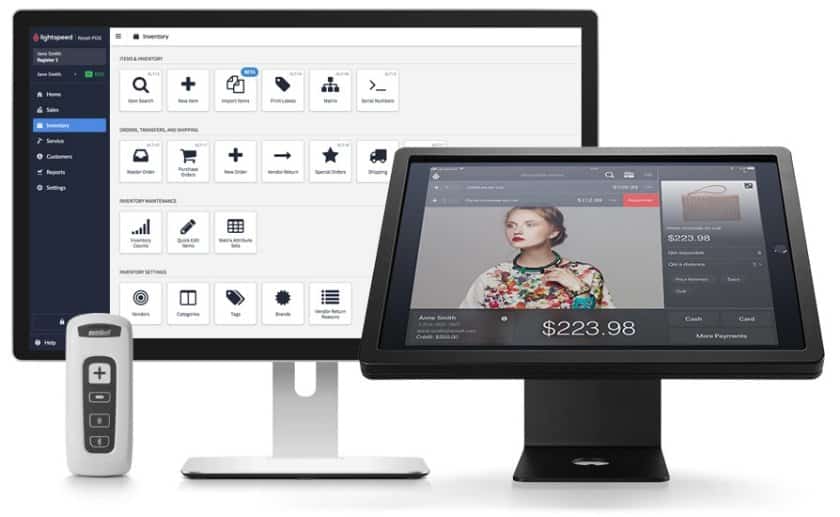
Lightspeed Retail POS simplifies the process of running a retail store. (Source: Lightspeed Retail)
Some of the criteria we use to evaluate the best POS systems include:
- Price : Most POS software programs charge a monthly fee, and some also charge extra for certain features.
- Ease of use : Test out each POS with a free demo or trial to make sure the interface is easy to navigate, and also read user reviews.
- Customer management tools : Almost all POS systems have a customer directory feature but, otherwise, they vary greatly in what loyalty, marketing, and customer feedback features are included.
- Sales reports : Each type of POS solution will have some kind of reporting tools, but some offer more details and features to create custom reports.
For brick-and-mortar stores, we often recommend Lightspeed. It’s a small business POS with big-business functionality such as custom report builders, detailed inventory tracking, a loyalty program, and built-in payment processing. Plus, it has built-in capabilities to handle consignment products. Visit Lightspeed for a 14-day free trial.
Visit Lightspeed
7. Advertise Your Consignment Shop
Before opening your consignment shop, you’ll need to start advertising and marketing your retail shop . Because you’re on a budget, make sure your strategy is effective by choosing a combination of online and offline marketing efforts.
- Social Media
- Search Engine Optimization (SEO)
In order for customers to find your business, you’ll want to have a website. Creating your own website from scratch can be easy with the right tools. There are many easy ways to make a business website for little or no cost. You need a registered domain and a web hosting service.
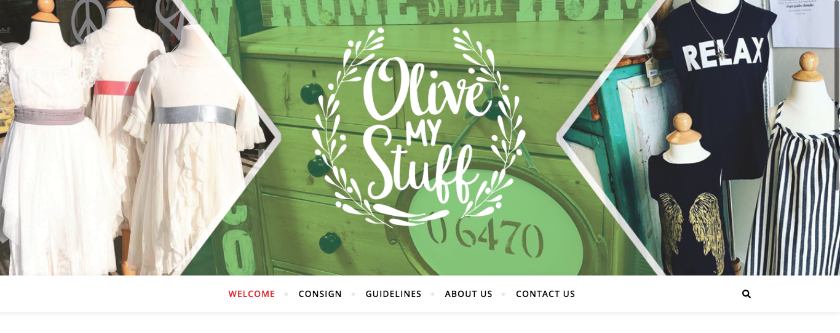
Olive My Stuff, a consignment shop in Connecticut, has a professional website with information on shopping and consigning.
Create social media accounts on channels like Facebook, Instagram, and TikTok to promote your brand and consignment items. You can even sell your secondhand goods on Facebook as well as sell them on Instagram directly. Run paid social ads targeting people who fit your target market in your local area.
Focusing on your SEO strategy is an excellent way to put your consignment shop in front of people who may not have otherwise heard about you. Local SEO , in particular, can help you increase your visibility for local searches. This is an excellent marketing tactic because users searching for “consignment shop near me” are likely high intent.
- Store Signage
- Window Displays
- Customer Loyalty Program
The storefront signage is the first impression shoppers will get from the in-person experience with your consignment shop. Make sure the sign is easily visible and easy to read, while also being reflective of your brand. You want to stand out enough to make passersby curious about what’s inside, especially if you plan to rely heavily on foot traffic. Check out these business sign ideas for inspiration.
While your signage might make the first impression, your window displays have the potential to make the biggest impact. A well-designed storefront with captivating window displays can lure even the most hesitant shoppers into your consignment store. Here are some resources to help you get started:
- Create a Stunning Store Window Display
- Visual Merchandising Techniques
Once your consignment shop is up and running, loyalty programs are a great way to encourage repeat customers and higher transaction amounts. Simple punch cards can be effective. However, using a loyalty program that’s tied in with your POS system offers deeper insights like who is using the program and how effective it is. Lightspeed offers a sophisticated loyalty program that you can add onto Lightspeed POS for a monthly fee.

8. Hire & Train Employees
Last but certainly not least, before opening your store to the public you need to bring on a stellar group of employees to serve as the front lines of your business. If you haven’t hired an employee before, navigating the process can be intimidating. Follow a new hire checklist that outlines all of the gritty steps you need to take such as obtaining an employer identification number (EIN), registering for state and local taxes, and so on.
As a consignment store owner, it’s likely you won’t have a dedicated human resources (HR) team member. Using an affordable solution like Homebase can save you plenty of time and stress by simplifying hiring, employee scheduling, time tracking, and payroll.
Visit Homebase
Training Your Employees
You’ll want your consignment store staff ready to provide top-notch customer service from the moment you open your business. Providing great customer service is a skill that requires practice. If you don’t start training your employees before you open, they’ll be practicing their service skills on your customers.
Instead, hold a weeklong training boot camp before you open. In addition to running through customer service scenarios and role-playing, teach employees about store policies and procedures, the items you’re selling, and any other pertinent information.
9. Plan & Launch Your Grand Opening
Hosting a grand opening celebration is a great way to kick off your new business venture while also gaining some press coverage. To have maximum attendance, recruit friends and family, draft a press release for local media and surrounding businesses, make a Facebook event, notify your local Chamber of Commerce, and take an advertisement out in the local paper.
“One mistake a lot of companies make is staying under the radar until launch. If no one knows what you’re doing and when you’re opening, then you have zero chance of making any sales. Start building some excitement at least six weeks before your launch. Get active on social channels. Interact with likely customers and get the conversation started. Build anticipation with enticing photos, and maybe even incentivize purchases in those early days.” ― Deanna Thompson, Blogger, Closet Full of Cash
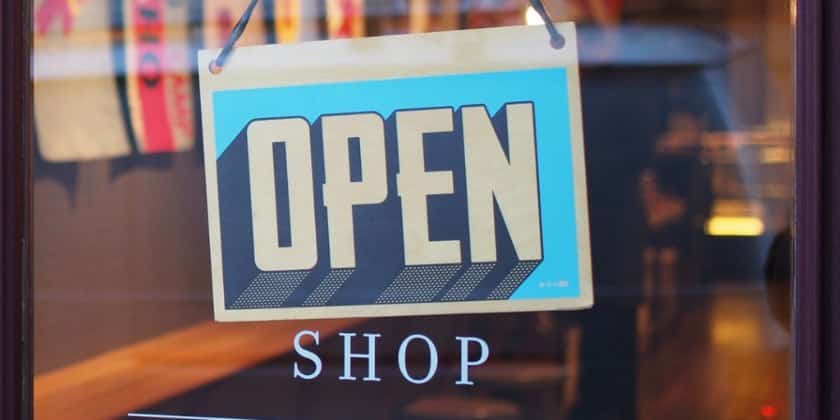
Plan a grand opening to celebrate the launch of your new business.
How to Start a Consignment Shop Frequently Asked Questions (FAQs)
Opening and running a consignment shop can be a tricky business.
What is a consignment shop?
A consignment shop is a store that sells secondhand items, typically clothing and accessories. Consignment stores purchase gently used goods and resell them at a markup to make a profit.
How does a consignment shop work?
As the owner of the consignment shop, you will purchase secondhand goods from customers, professional suppliers, flea market vendors, and so on, and own those items until they are resold in your store for a higher price.
How much does it cost to open a consignment store?
The exact price can vary a lot depending on your location and local real estate prices. However, opening a consignment store will cost roughly $10,000.
Why do consignment stores fail?
Part of learning how to start a consignment shop is figuring out what not to do. There are many reasons a consignment shop could fail. Common reasons include choosing the wrong storefront location, not having in-demand products, too-small profit margins, and insufficient marketing.
Bottom Line
Consignment shops are a great business idea for making money in 2022. More than 20,000 US-based used merchandise stores have a combined annual revenue of $17.6 billion , according to First Research. And these numbers continue to grow, especially as the world becomes more aware of the environmental challenges consumerism brings.
Starting a consignment shop is an excellent way to promote sustainable consumerism while also making a profit. And with the market growing the way it is, there’s plenty of opportunity for consignment shops of all kinds. There’s never been a better time to start a consignment business of your own.
About the Author

Find Meaghan On LinkedIn Twitter
Meaghan Brophy
Meaghan Brophy is a Retail Expert at Fit Small Business focusing on small business retail and ecommerce content. Meaghan’s 10+ years of retail experience includes working at local book and dance supply stores, handcrafting gifts at an eco-friendly manufacturer, developing private label brands, and managing a team of more than 40 sales and service professionals at a local spa.
Join Fit Small Business
Sign up to receive more well-researched small business articles and topics in your inbox, personalized for you. Select the newsletters you’re interested in below.
- Which Plan To Set Up?

I call this time of the year Retirement Plan Crazy Season where plan sponsors decided to change plan providers to get things changing smoothly on January 1. I call it Crazy Season based on NASCAR’s Crazy Season when drivers and car sponsors switch teams by making new deals for the following Cup season.
In addition, it is this time of the year that many employers decide to implement a plan for the current year as the deadline for putting a plan in place for a calendar year plan is now the due date of your tax return.
One of the difficult choices for an employer in deciding to sponsor a plan is which type of qualified plan to sponsor. Here is just a small list:
1. Number of employees to participate: The more, maybe not the merrier. But the more, is less likely you will be pursuing a defined benefit plan and more likely pursuing a 401(k) plan.
2. Age and compensation of the owner(s)/highly compensated employees. Despite what the folks protesting at Wall Street believe, one of the goals of setting up a retirement plan is saving the maximum for the owners and highly compensated employees of the business. One way to achieve maximum savings is the use of a defined benefit plan or a cross-tested allocation that will award higher contributions to these high-paid employees and some of the key factors are age and compensation.
3. How much can the Employer afford to contribute? When it comes to defined benefit plans and safe harbor 401(k) allocations, as well as the near obsolete money purchase plans, the employer must dedicate a fixed contribution each year (which is decided after the end of the Plan Year). Does the Employer see that it has the cash flow over the next couple of years to make such a financial commitment? I can’t tell you how many times I have had sole proprietors say they want to save the maximum under a defined benefit plan. All of a sudden, they needed to pare back after the sticker shock of the maximum contribution that the actuary determined.
4. Ask the Employees. A small business is usually not a democracy but it may be wise to ask employees for input in setting up a retirement plan. Namely, the questionnaire really should be tailored towards trying to identify whether they see this plan as an important employee benefit and if the employer decides the 401(k) route, whether the employees would defer. Now employees shouldn’t have a say in designing the plan since they aren’t going to be the ones funding the contribution.
5. Find a financial advisor. If a small business has a non-owner employee, a financial advisor should be hired. No ifs, ands, or buts.
6. Find a good TPA/ERISA attorney. To have a good retirement plan, you need a good team. I cannot stress the need for businesses to find a solid third-party administration firm (TPA) and a good ERISA attorney (preferably an independent ERISA attorney who will draft plan documents at costs comparable to what a TPA would charge).
Latest Posts
- Some TPAs are in the administration business, some are not
- The problem with too much loyalty to providers
- The Problem of Plan design
- Filing that late 5500 can be a weapon of mass destruction
See more »
DISCLAIMER: Because of the generality of this update, the information provided herein may not be applicable in all situations and should not be acted upon without specific legal advice based on particular situations. Attorney Advertising.
Refine your interests »
Written by:

PUBLISH YOUR CONTENT ON JD SUPRA NOW
- Increased visibility
- Actionable analytics
- Ongoing guidance
Published In:
Ary rosenbaum - the rosenbaum law firm p.c. on:.

"My best business intelligence, in one easy email…"

We earn commissions if you shop through the links below. Read more
Tobacco Shop
Back to All Business Ideas
How to Set up and Operate a Successful Tobacco Shop
Written by: Carolyn Young
Carolyn Young is a business writer who focuses on entrepreneurial concepts and the business formation. She has over 25 years of experience in business roles, and has authored several entrepreneurship textbooks.
Edited by: David Lepeska
David has been writing and learning about business, finance and globalization for a quarter-century, starting with a small New York consulting firm in the 1990s.
Published on April 21, 2022
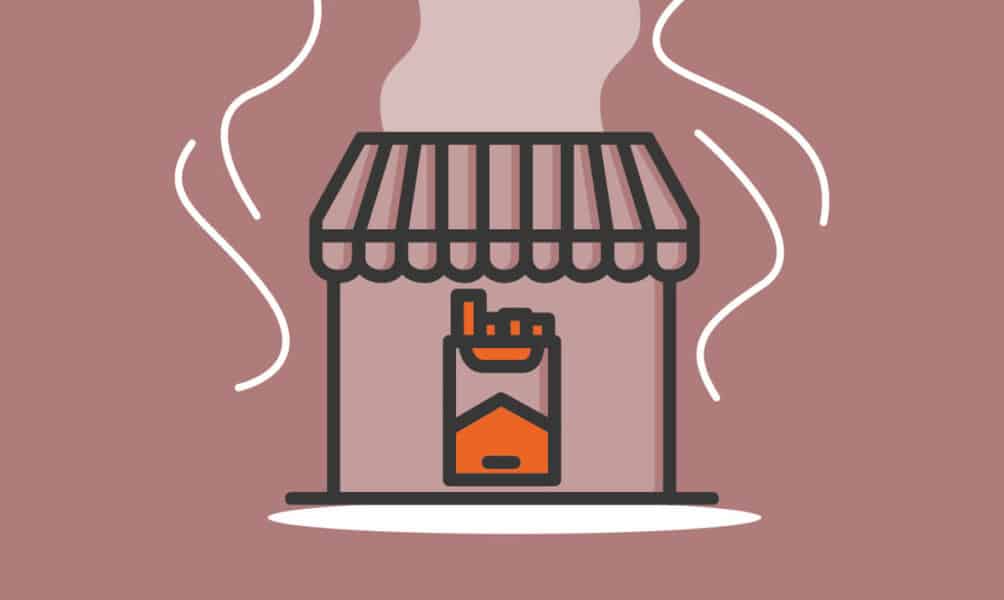
Investment range
$11,550 - $62,100
Revenue potential
$110,000 - $365,000 p.a.
Time to build
1 – 3 months
Profit potential
$44,000 - $146,000 p.a.
Industry trend
Consider these crucial factors when launching your tobacco shop:
- Define your products — Decide on the types of products you will offer, such as cigarettes, cigars, pipe tobacco, vaping products, accessories, and specialty items like humidors or lighters.
- Tobacco retail license — Apply for a tobacco retail license or permit from your state’s regulatory agency. Requirements vary by location and may include background checks and specific fees.
- Age restrictions — Implement strict policies to ensure compliance with age restrictions for purchasing tobacco products. This typically includes verifying the age of customers through identification checks.
- Choosing a location — Select a high-traffic location with good visibility, such as near shopping centers or busy streets.
- Sourcing suppliers — Establish relationships with reliable suppliers and distributors to ensure a consistent and high-quality inventory.
- Register your business — A limited liability company (LLC) is the best legal structure for new businesses because it is fast and simple. Form your business immediately using ZenBusiness LLC formation service or hire one of the best LLC services on the market.
- Legal business aspects — Register for taxes, open a business bank account, and get an EIN .
- Advertising and labeling — Ensure all advertising and product labeling comply with local, state, and federal regulations regarding health warnings and marketing restrictions.
Interactive Checklist at your fingertips—begin your tobacco shop today!
You May Also Wonder:
Is a tobacco shop profitable?
A tobacco shop can be profitable, but you need to have a high volume of sales because profit margins are low. The key is to offer the products that are most in demand and to have a great location.
What are some popular tobacco brands and products that I should consider stocking?
Popular tobacco brands and products can vary depending on the region and preferences of your target market. Some well-known tobacco brands include Marlboro, Camel, Newport, Winston, and Dunhill. It’s also important to consider stocking a variety of tobacco products such as cigarettes, cigars, pipe tobacco, rolling tobacco, and smokeless tobacco options.
Can I start a tobacco shop on the side?
Starting a tobacco shop on the side is possible, but it’s important to research and comply with local regulations and licensing requirements. Be aware of any restrictions or special permits needed to sell tobacco products in your area.
What steps should I take to ensure the freshness and quality of tobacco products?
Store tobacco products in a cool, dry place away from direct sunlight; maintain proper humidity levels for cigars and pipe tobacco using a humidor or other suitable storage solutions. Rotate stock regularly to prevent stale products from being sold and check expiration dates and remove any expired or outdated products from your inventory.
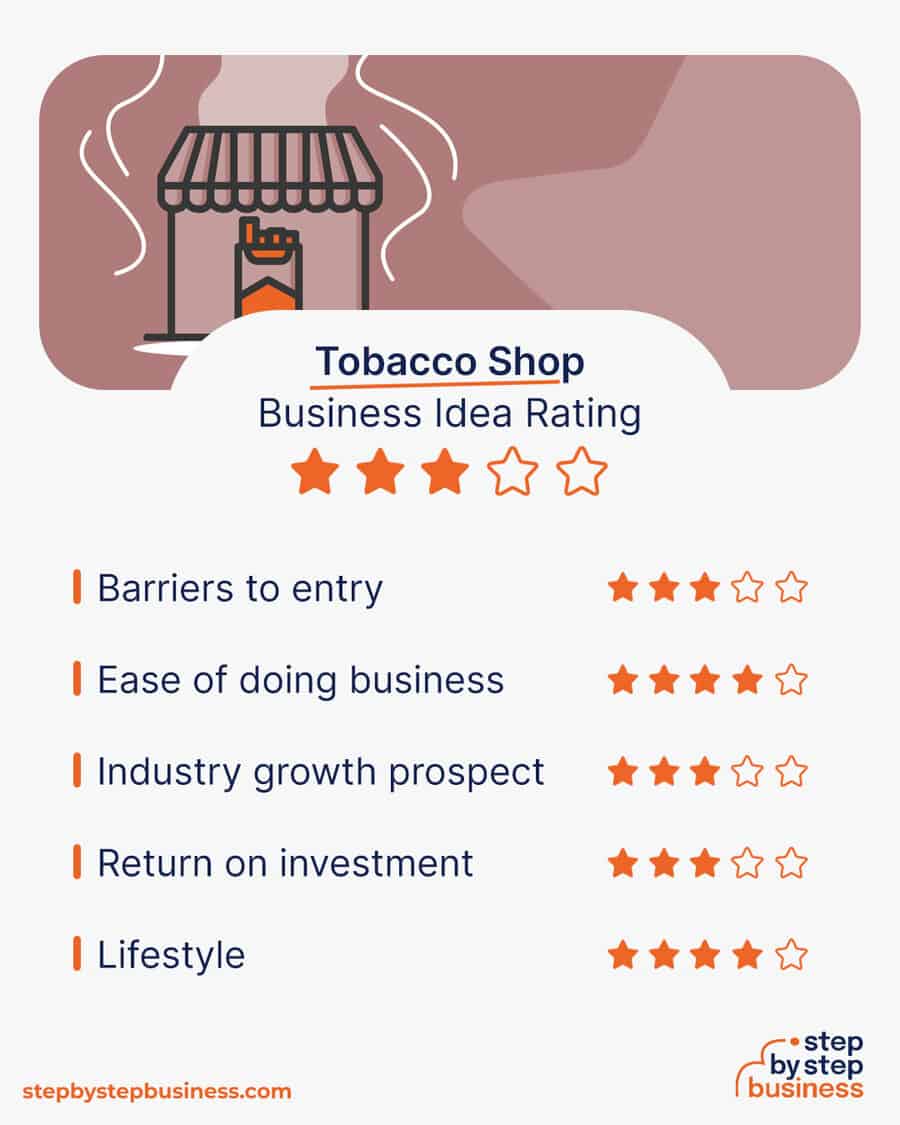
Step 1: Decide if the Business Is Right for You
Pros and cons.
Starting a tobacco shop has pros and cons to consider before deciding if it’s right for you.
- Large Market – Demand for tobacco products remains strong
- Social Experience – Meet interesting people
- Product Variety – Candy, snacks, vapes to boost revenue
- Strict Regulations – Subject to government regulations
- Low Margins – Profit margins for a tobacco shop are low
Tobacco industry trends
Industry size and growth.
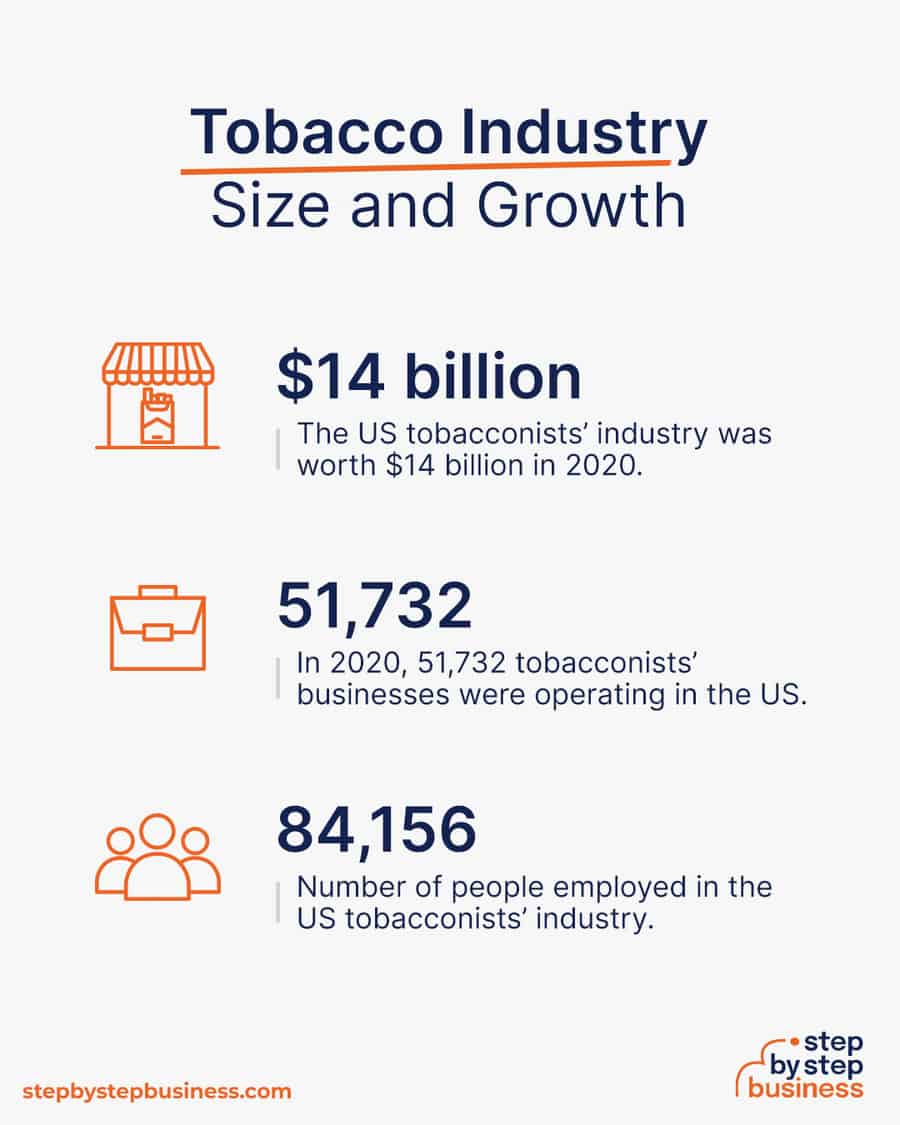
- Industry size and past growth – The US tobacconists’ industry was worth $14 billion in 2020 after expanding moderately the previous five years,(( https://www.ibisworld.com/united-states/market-research-reports/tobacconists-industry/ )) although it took a hit during the pandemic. Interestingly, however, US tobacco production increased by nearly 6% in 2020 as the pandemic took hold.(( https://www.ibisworld.com/industry-statistics/market-size/cigarette-tobacco-manufacturing-united-states/ ))
- Growth forecast – The US tobacconists’ industry is projected to grow slowly the next five years.
- Number of businesses – In 2020, 51,732 tobacconists’ businesses were operating in the US.
- Number of people employed – In 2020, the US tobacconists’ industry employed 84,156 people.
Trends and challenges
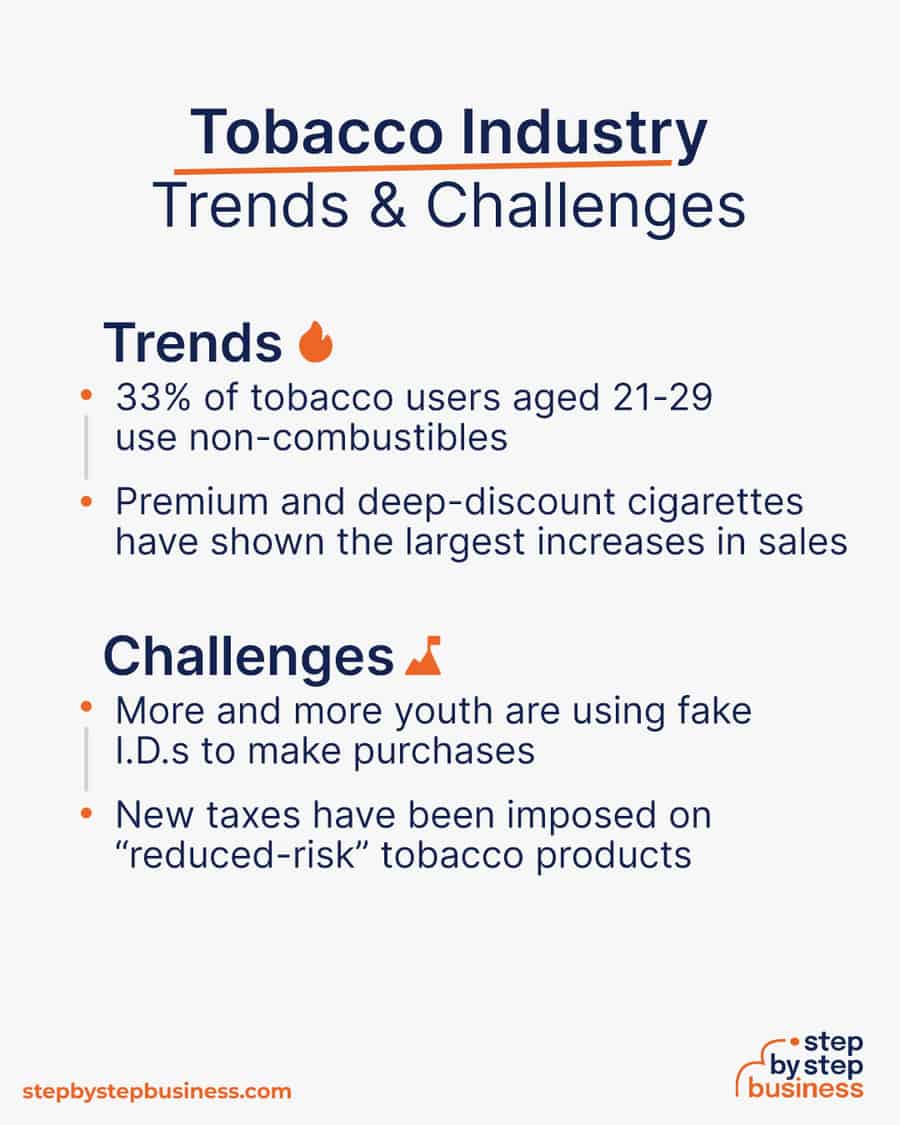
Trends in the tobacco shop industry include:
- 33% of tobacco users aged 21-29 use non-combustibles, such as chew, dip, dissolvables, e-cigarettes, and snuff.
- Premium cigarettes and deep-discount cigarettes have shown the largest increases in sales in recent years.
Challenges in the tobacco shop industry include:
- Since the US raised the minimum age for tobacco from 18 to 21, more and more youth are using fake I.D.s to make purchases, presenting a risk for tobacco shops.
- New taxes have been imposed on “reduced-risk” tobacco products such as e-cigarettes, and the dangers of e-cigarettes are increasingly being exposed, which may cause sales for that product segment to decline.
How much does it cost to start a tobacco shop business?
Startup costs for an online tobacco shop are about $11,000. The largest cost is for an inventory of tobacco products. To start a brick-and-mortar tobacco shop costs about $60,000. Costs include shop rental and preparation, and an entire inventory for your shop.
How much can you earn from a tobacco shop business?
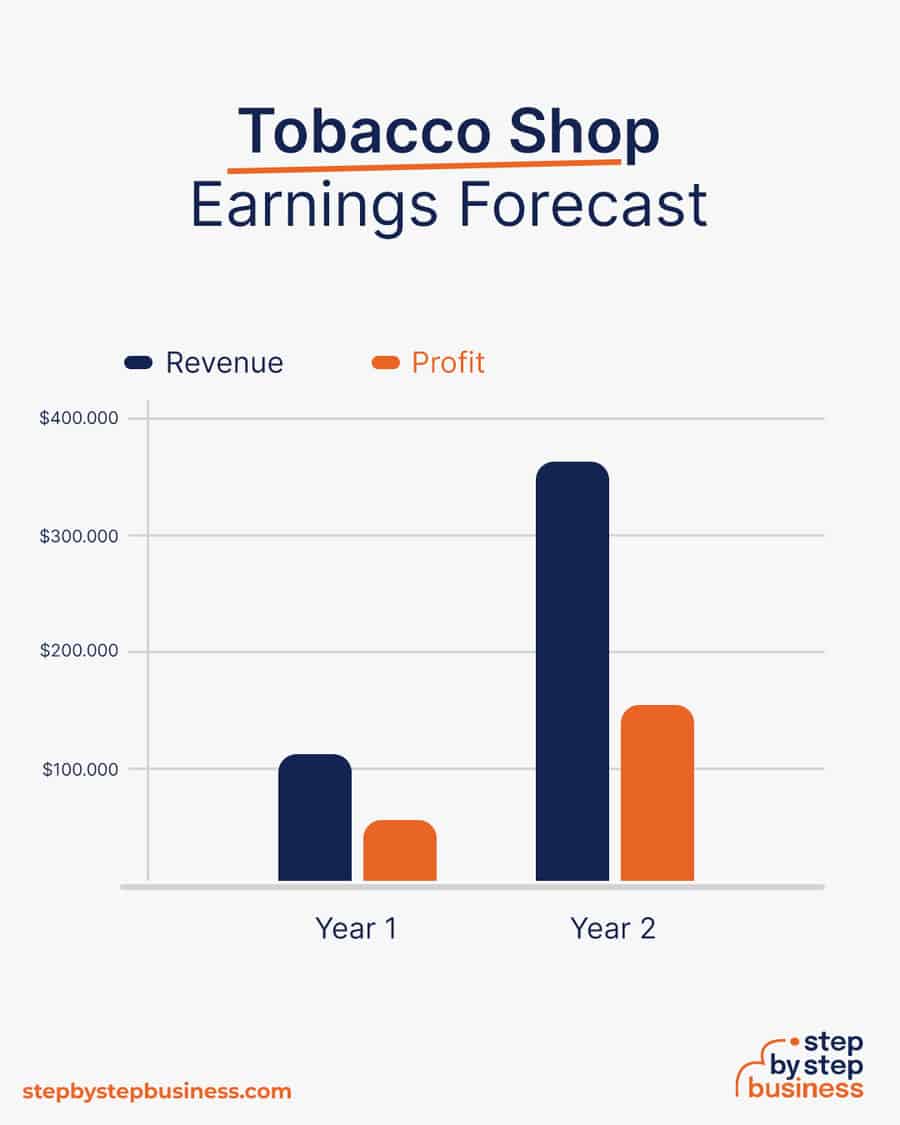
Prices for tobacco products vary greatly. Packs of cigarettes cost around $7 depending on the brand and your location. In New York City the average pack costs about $14. Pipes, cigars, and other tobacco products have varying prices. For an online store, your profit margin should be about 40%. For a physical store, it will be about 10%. These calculations assume you’ll start with an online store.
In your first year or two, you could make $300 in sales per day, bringing in $110,000 in annual revenue. This would mean $44,000 in profit, assuming that 40% margin. As your site grows in popularity, sales could climb to $1,000 per day. With annual revenue of $365,000, you’d make a tidy profit of $146,000.
What barriers to entry are there?
There are a few barriers to entry for a tobacco shop. Your biggest challenges will be:
- The startup costs of inventory and the physical store
- Breaking into a competitive market
Related Business Ideas
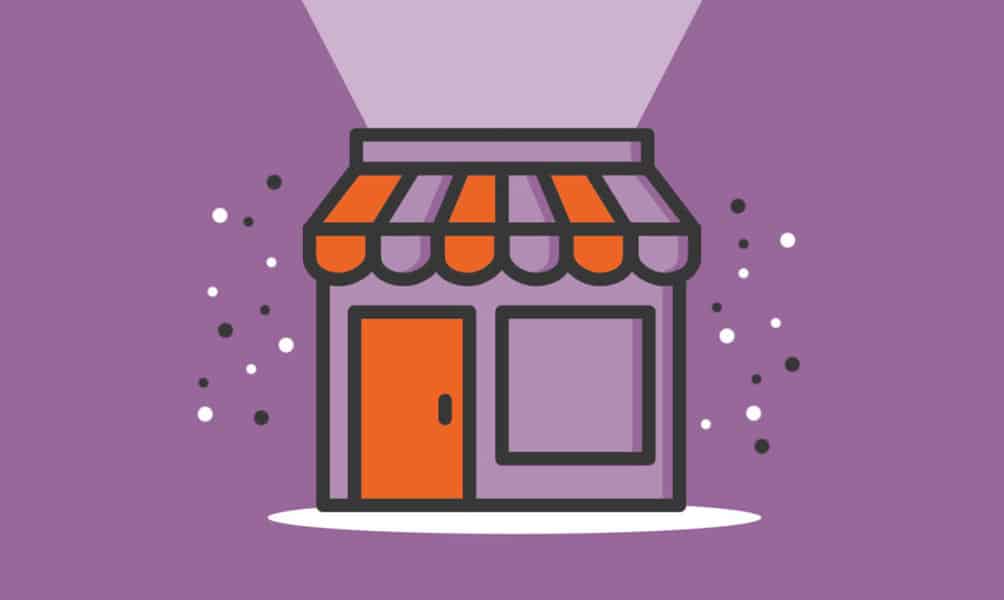
The Basics of Starting a Convenience Store
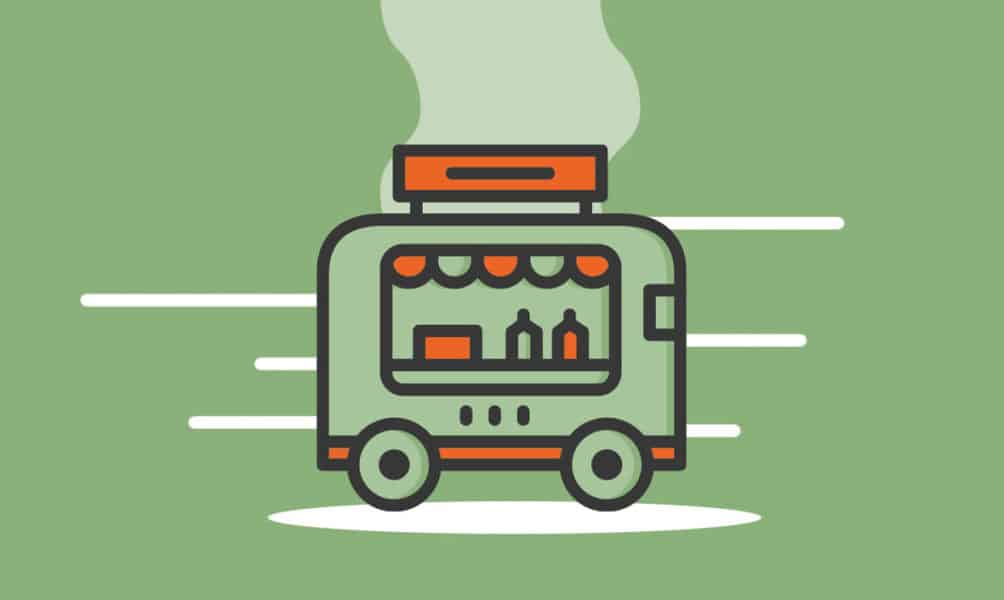
13 Steps to Launching a Food Truck Business
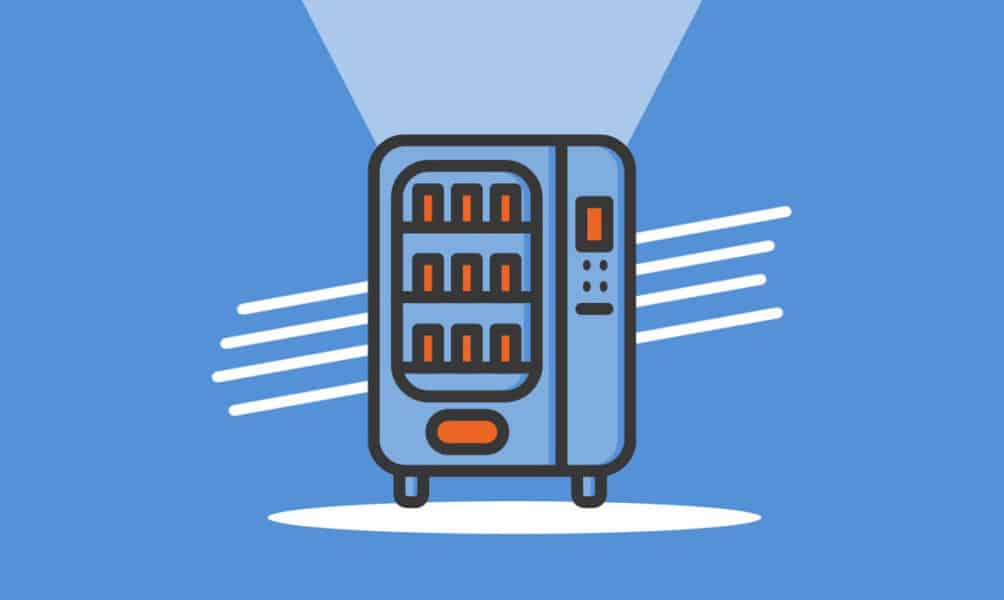
Profitable Side Hustle: Starting Your Vending Machine Venture
Step 2: hone your idea.
Now that you know what’s involved in starting a tobacco shop, it’s a good idea to hone your concept in preparation to enter a competitive market.
Market research will give you the upper hand, even if you’re already positive that you have a perfect product or service. Conducting market research is important, because it can help you understand your customers better, who your competitors are, and your business landscape.
Why? Identify an opportunity
Research tobacco shops in your area to examine their products, price points, and what sells best. You’re looking for a market gap to fill. For instance, maybe the local market is missing a shop that specializes in smokeless tobacco products like vape products or a pipe tobacco and cigar shop .
You might consider targeting a niche market by specializing in a certain aspect of your industry, such as hookah tobacco or electronic cigarettes.
This could jumpstart your word-of-mouth marketing and attract clients right away.
What? Determine your tobacco products
You can offer a wide variety of products in your shop including:
- Smokeless tobacco products
- Bags of tobacco and shells for rolling
- Cigarette rolling machines
- Chewing tobacco
- Pipe tobacco
- Hookah tobacco
- Electronic cigarettes
- Candy, gum, nuts, snacks
How much should you charge for tobacco?
Prices for tobacco products vary widely. Check competitor prices to find an average. For an online store, you should aim for a profit margin of about 40%.
Once you know your costs, you can use this Step By Step profit margin calculator to determine your mark-up and final price points. Remember, the prices you use at launch should be subject to change if warranted by the market.
Who? Identify your target market
Your target market will be broad. You should spread out your marketing to include sites like TikTok, Instagram, and Facebook.
Where? Choose your tobacco shop location
If you decide to open a brick-and-mortar shop, the success of your tobacco shop is largely dependent on its location.
Look for a location where customers can comfortably browse your products. Consider areas with a high concentration of cigar bars, lounges, or fine dining restaurants, as these places may attract a clientele that values premium tobacco products.
You can find commercial space to rent in your area on sites such as Craigslist , Crexi , and Instant Offices .
When choosing a commercial space, you may want to follow these rules of thumb:
- Central location accessible via public transport
- Ventilated and spacious, with good natural light
- Flexible lease that can be extended as your business grows
- Ready-to-use space with no major renovations or repairs needed
Step 3: Brainstorm a Tobacco Shop Name
Here are some ideas for brainstorming your business name:
- Short, unique, and catchy names tend to stand out
- Names that are easy to say and spell tend to do better
- Name should be relevant to your product or service offerings
- Ask around — family, friends, colleagues, social media — for suggestions
- Including keywords, such as “tobacco” or “tobacco shop”, boosts SEO
- Name should allow for expansion, for ex: “Smokin’ Deals Tobacco” over “Vape Station”
- A location-based name can help establish a strong connection with your local community and help with the SEO but might hinder future expansion
Once you’ve got a list of potential names, visit the website of the US Patent and Trademark Office to make sure they are available for registration and check the availability of related domain names using our Domain Name Search tool. Using “.com” or “.org” sharply increases credibility, so it’s best to focus on these.
Find a Domain
Powered by GoDaddy.com
Finally, make your choice among the names that pass this screening and go ahead with domain registration and social media account creation. Your business name is one of the key differentiators that sets your business apart. Once you pick your company name, and start with the branding, it is hard to change the business name. Therefore, it’s important to carefully consider your choice before you start a business entity.
Step 4: Create a Tobacco Shop Business Plan
Here are the key components of a business plan:

- Executive Summary: Provide a concise overview of your tobacco shop, highlighting its range of tobacco products, target market, and strategies for creating a unique shopping experience.
- Business Overview: Describe your shop’s focus on selling various tobacco products, including cigarettes, cigars, pipe tobacco, and smoking accessories.
- Product and Services: Detail the range of products offered, such as premium cigars, tobacco blends, smoking pipes, rolling papers, and possibly vape products.
- Market Analysis: Assess the local demand for tobacco products, identifying potential customers like regular smokers, cigar enthusiasts, or newcomers to pipe smoking.
- Competitive Analysis: Compare your shop to other tobacco retailers in the area, focusing on your product variety, quality, or specialized services like tobacco sampling or cigar lounges.
- Sales and Marketing: Outline your strategy for attracting customers, using tactics like in-store events, social media marketing, or loyalty programs.
- Management Team: Highlight the expertise of your team, particularly in tobacco product knowledge, retail management, and customer service.
- Operations Plan: Describe the operational aspects, including inventory management, supplier relations, and customer service standards.
- Financial Plan: Provide an overview of financial aspects, covering startup costs, pricing strategy, and revenue projections.
- Appendix: Include supplementary documents like supplier agreements, market research data, or detailed product catalogs to support your business plan.
If you’ve never created a business plan, it can be an intimidating task. You might consider hiring a business plan specialist to create a top-notch business plan for you.
Step 5: Register Your Business
Registering your business is an absolutely crucial step — it’s the prerequisite to paying taxes, raising capital, opening a bank account, and other guideposts on the road to getting a business up and running.
Plus, registration is exciting because it makes the entire process official. Once it’s complete, you’ll have your own business!
Choose where to register your company
Your business location is important because it can affect taxes, legal requirements, and revenue. Most people will register their business in the state where they live, but if you’re planning to expand, you might consider looking elsewhere, as some states could offer real advantages when it comes to tobacco shops.
If you’re willing to move, you could really maximize your business! Keep in mind, it’s relatively easy to transfer your business to another state.
Choose your business structure
Business entities come in several varieties, each with its pros and cons. The legal structure you choose for your tobacco shop will shape your taxes, personal liability, and business registration requirements, so choose wisely.
Here are the main options:

- Sole Proprietorship – The most common structure for small businesses makes no legal distinction between company and owner. All income goes to the owner, who’s also liable for any debts, losses, or liabilities incurred by the business. The owner pays taxes on business income on his or her personal tax return.
- General Partnership – Similar to a sole proprietorship, but for two or more people. Again, owners keep the profits and are liable for losses. The partners pay taxes on their share of business income on their personal tax returns.
- Limited Liability Company (LLC) – Combines the characteristics of corporations with those of sole proprietorships or partnerships. Again, the owners are not personally liable for debts.
- C Corp – Under this structure, the business is a distinct legal entity and the owner or owners are not personally liable for its debts. Owners take profits through shareholder dividends, rather than directly. The corporation pays taxes, and owners pay taxes on their dividends, which is sometimes referred to as double taxation.
- S Corp – An S-Corporation refers to the tax classification of the business but is not a business entity. An S-Corp can be either a corporation or an LLC , which just need to elect to be an S-Corp for tax status. In an S-Corp, income is passed through directly to shareholders, who pay taxes on their share of business income on their personal tax returns.
We recommend that new business owners choose LLC as it offers liability protection and pass-through taxation while being simpler to form than a corporation. You can form an LLC in as little as five minutes using an online LLC formation service. They will check that your business name is available before filing, submit your articles of organization , and answer any questions you might have.
Form Your LLC
Choose Your State
We recommend ZenBusiness as the Best LLC Service for 2024

Step 6: Register for Taxes
The final step before you’re able to pay taxes is getting an Employer Identification Number , or EIN. You can file for your EIN online or by mail or fax: visit the IRS website to learn more. Keep in mind, if you’ve chosen to be a sole proprietorship you can simply use your social security number as your EIN.
Once you have your EIN, you’ll need to choose your tax year. Financially speaking, your business will operate in a calendar year (January–December) or a fiscal year, a 12-month period that can start in any month. This will determine your tax cycle, while your business structure will determine which taxes you’ll pay.
The IRS website also offers a tax-payers checklist , and taxes can be filed online.
It is important to consult an accountant or other professional to help you with your taxes to ensure you’re completing them correctly.
Step 7: Fund your Business
Securing financing is your next step and there are plenty of ways to raise capital:
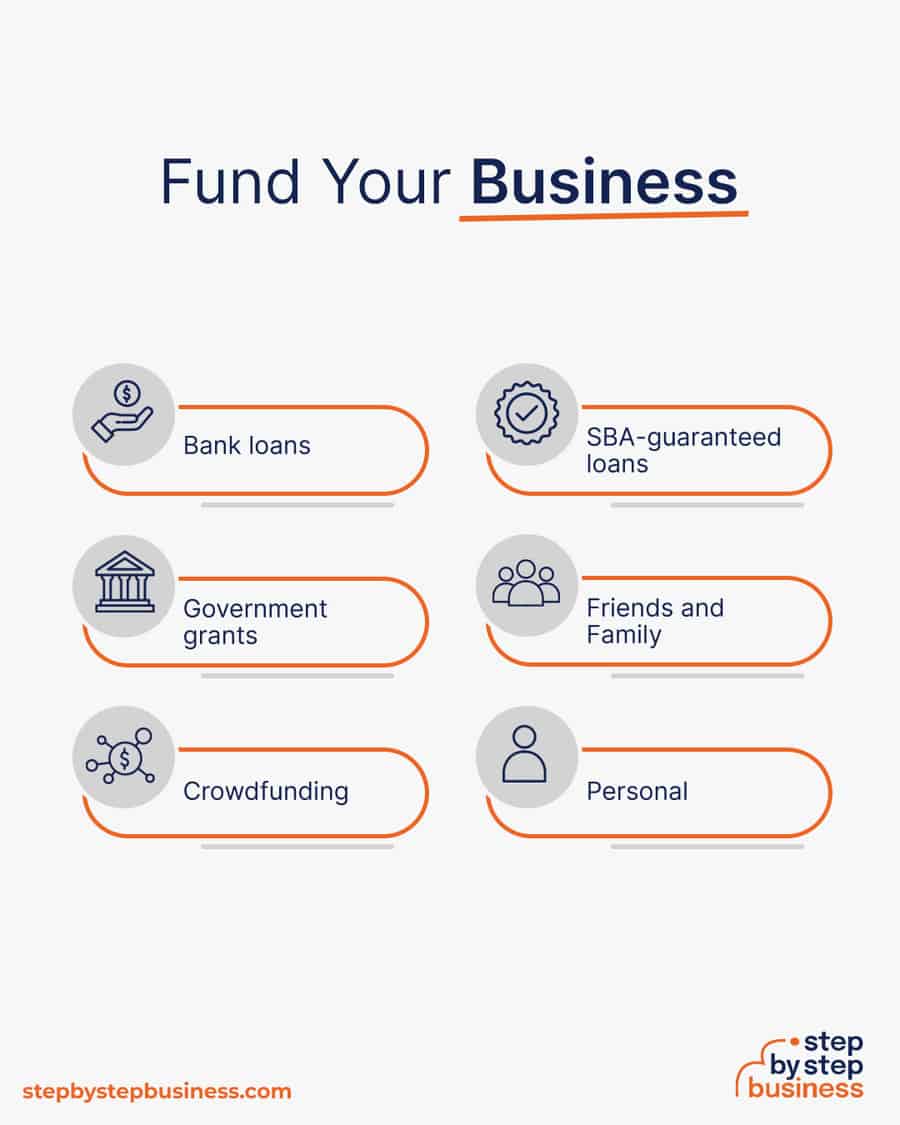
- Bank loans: This is the most common method but getting approved requires a rock-solid business plan and strong credit history.
- SBA-guaranteed loans: The Small Business Administration can act as guarantor, helping gain that elusive bank approval via an SBA-guaranteed loan .
- Government grants: A handful of financial assistance programs help fund entrepreneurs. Visit Grants.gov to learn which might work for you.
- Friends and Family: Reach out to friends and family to provide a business loan or investment in your concept. It’s a good idea to have legal advice when doing so because SEC regulations apply.
- Crowdfunding: Websites like Kickstarter and Indiegogo offer an increasingly popular low-risk option, in which donors fund your vision. Entrepreneurial crowdfunding sites like Fundable and WeFunder enable multiple investors to fund your business.
- Personal: Self-fund your business via your savings or the sale of property or other assets.
Bank and SBA loans are probably the best option, other than friends and family, for funding a tobacco shop business.
Step 8: Apply for Tobacco Shop Business Licenses and Permits
Starting a tobacco shop business requires obtaining a number of licenses and permits from local, state, and federal governments.
Every state has its own requirements to get a tobacco license. Check with your state to learn about the process.
Federal regulations, licenses, and permits associated with starting your business include doing business as (DBA), health licenses and permits from the Occupational Safety and Health Administration ( OSHA ), trademarks, copyrights, patents, and other intellectual properties, as well as industry-specific licenses and permits.
You may also need state-level and local county or city-based licenses and permits. The license requirements and how to obtain them vary, so check the websites of your state, city, and county governments or contact the appropriate person to learn more.
You could also check this SBA guide for your state’s requirements, but we recommend using MyCorporation’s Business License Compliance Package . They will research the exact forms you need for your business and state and provide them to ensure you’re fully compliant.
This is not a step to be taken lightly, as failing to comply with legal requirements can result in hefty penalties.
If you feel overwhelmed by this step or don’t know how to begin, it might be a good idea to hire a professional to help you check all the legal boxes.
Step 9: Open a Business Bank Account
Before you start making money, you’ll need a place to keep it, and that requires opening a bank account .
Keeping your business finances separate from your personal account makes it easy to file taxes and track your company’s income, so it’s worth doing even if you’re running your tobacco shop business as a sole proprietorship. Opening a business bank account is quite simple, and similar to opening a personal one. Most major banks offer accounts tailored for businesses — just inquire at your preferred bank to learn about their rates and features.
Banks vary in terms of offerings, so it’s a good idea to examine your options and select the best plan for you. Once you choose your bank, bring in your EIN (or Social Security Number if you decide on a sole proprietorship), articles of incorporation, and other legal documents and open your new account.
Step 10: Get Business Insurance
Business insurance is an area that often gets overlooked yet it can be vital to your success as an entrepreneur. Insurance protects you from unexpected events that can have a devastating impact on your business.
Here are some types of insurance to consider:

- General liability: The most comprehensive type of insurance, acting as a catch-all for many business elements that require coverage. If you get just one kind of insurance, this is it. It even protects against bodily injury and property damage.
- Business Property: Provides coverage for your equipment and supplies.
- Equipment Breakdown Insurance: Covers the cost of replacing or repairing equipment that has broken due to mechanical issues.
- Worker’s compensation: Provides compensation to employees injured on the job.
- Property: Covers your physical space, whether it is a cart, storefront, or office.
- Commercial auto: Protection for your company-owned vehicle.
- Professional liability: Protects against claims from a client who says they suffered a loss due to an error or omission in your work.
- Business owner’s policy (BOP): This is an insurance plan that acts as an all-in-one insurance policy, a combination of the above insurance types.
Step 11: Prepare to Launch
As opening day nears, prepare for launch by reviewing and improving some key elements of your business.
Essential software and tools
Being an entrepreneur often means wearing many hats, from marketing to sales to accounting, which can be overwhelming. Fortunately, many websites and digital tools are available to help simplify many business tasks.
You may want to use industry-specific software, such as Korona POS , PTechPOS , or NRS , to manage your purchasing, inventory, and payments.
- Popular web-based accounting programs for smaller businesses include Quickbooks , Freshbooks , and Xero .
- If you’re unfamiliar with basic accounting, you may want to hire a professional, especially as you begin. The consequences for filing incorrect tax documents can be harsh, so accuracy is crucial.
Develop your website
Developing a website for a tobacco shop requires careful consideration of both design and functionality. You have two main options: using a website builder like Wix or Squarespace , which offers user-friendly interfaces and customizable templates, or hiring a professional web developer, which can provide a more tailored and unique design.
If the business model includes online sales, integrating an e-commerce store is vital. This store should be secure, easy to use, and well-organized, showcasing your products attractively and clearly.
Launching a tobacco shop requires strategic marketing to attract and retain customers effectively. Here are some focused strategies to consider:
- Optimize for Local SEO : Ensure your shop’s website is optimized for local search engine results. This includes using relevant local keywords, such as the city or neighborhood where your shop is located, and ensuring your site is mobile-friendly. Regularly update your content with local references and information about tobacco products.
- Get Listed in Local Directories : Register your shop in local business directories and on platforms like Google My Business. This improves your visibility in local search results and helps potential customers find your shop easily.
- Social Media Marketing : Leverage social media platforms to engage with your local community. Share posts about new products, special offers, and shop events. Use targeted ads to reach potential customers in your area.
- Email Marketing : Collect email addresses from your customers and send regular newsletters with updates, promotions, and educational content about tobacco products. This keeps your shop top-of-mind and encourages repeat business.
- Host Events and Workshops : Organize events like cigar tasting or educational workshops about different tobacco products. This can attract new customers and create a community around your shop.
- Loyalty Programs : Implement a loyalty program to reward repeat customers. This could include discounts, special offers, or early access to new products.
- Collaborate with Local Businesses : Partner with nearby businesses for cross-promotions. For example, collaborate with local cafes or bars where smoking is allowed, offering discounts to their customers.
- Influencer Partnerships : Partner with local influencers or prominent personalities in the tobacco community to promote your products and shop.
- High-Quality Product Photography : Invest in professional photography for your products. High-quality images can be used on your website, social media, and in advertising, enhancing the perceived value of your products.
- Community Involvement : Participate in and sponsor local community events. This raises awareness of your shop and shows your investment in the local community.
Focus on USPs

Unique selling propositions, or USPs, are the characteristics of a product or service that set it apart from the competition. Customers today are inundated with buying options, so you’ll have a real advantage if they are able to quickly grasp how your tobacco shop meets their needs or wishes. It’s wise to do all you can to ensure your USPs stand out on your website and in your marketing and promotional materials, stimulating buyer desire.
Global pizza chain Domino’s is renowned for its USP: “Hot pizza in 30 minutes or less, guaranteed.” Signature USPs for your tobacco shop business could be:
- Smoke up — we got you covered
- Come chill in our smoke and vape shop
- Smokeless tobacco products – reduce your health risk
You may not like to network or use personal connections for business gain. But your personal and professional networks likely offer considerable untapped business potential. Maybe that Facebook friend you met in college is now running a tobacco shop, or a LinkedIn contact of yours is connected to dozens of potential clients. Maybe your cousin or neighbor has been working in tobacco for years and can offer invaluable insight and industry connections. The possibilities are endless, so it’s a good idea to review your personal and professional networks and reach out to those with possible links to or interest in tobacco. You’ll probably generate new customers or find companies with which you could establish a partnership. Online businesses might also consider affiliate marketing as a way to build relationships with potential partners and boost business.
Step 12: Build Your Team
If you’re starting out small from a home office, you may not need any employees. But as your business grows, you will likely need workers to fill various roles. Potential positions for a tobacco shop business include:
- Shop Clerks – make sales, customer service
- General Manager – ordering, inventory management, accounting
- Marketing Lead – SEO strategies, social media
At some point, you may need to hire all of these positions or simply a few, depending on the size and needs of your business. You might also hire multiple workers for a single role or a single worker for multiple roles, again depending on need.
Free-of-charge methods to recruit employees include posting ads on popular platforms such as LinkedIn, Facebook, or Jobs.com. You might also consider a premium recruitment option, such as advertising on Indeed , Glassdoor , or ZipRecruiter . Further, if you have the resources, you could consider hiring a recruitment agency to help you find talent.
Step 13: Run a Tobacco Shop – Start Making Money!
The tobacco shop industry is thriving, offering a whole new world of products including smokeless tobacco products. If you have a love for smoking, with some hard work and a small investment, you can build a lucrative tobacco shop, whether online or in a brick-and-mortar location. It’s a great opportunity to be in control of your work life and your income while doing what you enjoy.
You’ve taken the first step by educating yourself, so it’s time to hit the ground running and launch your successful tobacco shop!
Leave a Reply Cancel reply
Your email address will not be published. Required fields are marked *
Save my name, email, and website in this browser for the next time I comment.
- Decide if the Business Is Right for You
- Hone Your Idea
- Brainstorm a Tobacco Shop Name
- Create a Tobacco Shop Business Plan
- Register Your Business
- Register for Taxes
- Fund your Business
- Apply for Tobacco Shop Business Licenses and Permits
- Open a Business Bank Account
- Get Business Insurance
- Prepare to Launch
- Build Your Team
- Run a Tobacco Shop - Start Making Money!
Subscribe to Our Newsletter
Featured resources.

16 Retail Business Ideas with High Growth Potential
Carolyn Young
Published on December 1, 2022
The world of retail is huge, and lucrative opportunities are many. Retail offers endless areas for a budding entrepreneur to explore ideas for newbu ...

17 Business Ideas that Help the Community
Esther Strauss
Published on July 29, 2022
Just about everybody wants to live in a warm, welcoming close-knit community, and you can help build one by starting a business that helps peopleliv ...
No thanks, I don't want to stay up to date on industry trends and news.
How to start a small plant shop
Table of Contents
Self-funding
Small business loans, investments, physical store, online store, unique selling point, target audience, market research, customer profile, name and logo, brand guidelines, measurable goals, call to action, online payments, in-store payments, bookkeeping with countingup.
If you have a bit of a green thumb and love taking care of foliage, you might consider starting a plant shop. This business could be a great way to bring more colour into your community while earning money for yourself.
With this guide, you can take a seedling of an idea and grow it into a successful venture. We cover everything you need to know to get started. You’ll be sprouting with success in no time.
Learn everything you need to know about:
- Bookkeeping
Before you can start, you’ll need to think about how you’ll fund your plant shop. There are a few methods to consider, and we’ll cover the three most popular.
If you have the necessary capital to start up your business, you’ll benefit from retaining complete control. Plus, you can avoid taking on debt or paying interest on a loan.
On the other hand, you may decide you need to take out a bank loan . You’ll need to submit an application to seek the amount you need. Not all applications are successful, but having a strong business plan will improve your chances.
The third popular funding option is seeking investments. These can be from friends and family, to invest for a share of the business. Or you could approach angel investors, which, again, would require a good business plan. Professional investors may also offer guidance and connections in exchange for a stake in your business.
After you secure funding, you can decide how to structure your shop. Will it be an online-only delivery service or will you open a physical shop? Either way, you are likely going to need a location .
If you decide to open a physical shop, search for a location that is accessible and think about how you’ll draw customers. If you look to sell small, indoor plants, a town or city centre may be appropriate. But, if you plan to sell larger ones, your shop may need to be accessible to parking.
If your shop is online, you will need a storage warehouse for the plants. The location must be accessible for a courier company to deliver your goods if you don’t plan to do it yourself. With that said, maintaining a warehouse full of plants may require a lot of electricity and water, so look at the utility rates when choosing a location.
A physical store or warehouse will require you to keep the plants healthy enough to sell. To do this, you will likely need to think about the necessary equipment .
- Moisture metre: tells you if your plants need watering, which may be challenging to judge indoors.
- Watering vessel: this can range from a watering can to a sprinkler system, depending on the number of plants.
- Humidifier: this releases water vapour to increase moisture in the air.
- Pots: these are necessary to keep plants in.
You could plan to grow the plants yourself, but that will result in extra waiting time before you can sell. Alternatively, you could have a dedicated supplier lined up to purchase the plants.
There may be wholesale suppliers of plants or local garden centres, depending on your area. If you intend to bulk-buy plants from them, you may be able to negotiate lower prices per unit. Plus, finding a reliable and exclusive supplier could lead to deals or loyalty discounts.
When choosing suppliers, you also need to think about transportation. Some suppliers may deliver to you, but if that is not the case, you may need to add a van to the equipment your business requires. Driving to restock or deliver to customers, also means you need to keep track of fuel costs. Countingup, which is a business current account and accounting tool, lets you capture receipts with your phone’s camera and record them as expenses.
To succeed with your plant shop, consider your unique selling point (USP) . A USP helps you choose what elements to focus on to bring in customers. By identifying a gap in the market, you can provide people with something only your shop can offer.
For example, you could choose to sell a particular type of plant, such as tropical plants.
Alternatively, you could choose to create a unique experience for your customers. For example, you could launch a subscription service where you send customers one plant a month, including all of the plant care instructions.
Another important aspect to consider for your plant shop is your target audience . This is the group or a few groups of different people who are likely to be interested enough in what you sell to become customers.
To help you discover your target audience, conduct market research . There are many ways to do this, but speaking to the public is most straightforward. For example, you can send out surveys or set up interviews, which allow you to ask questions to find out who will be interested in the shop.
For further research, look at the overall plant market by seeing what similar businesses offer. It may help you to determine the demand for certain products and the prices others charge. You can use this information to put together a sales forecast which is useful for a business plan.
After conducting market research, you may have found some similarities between the people your plant shop most appeals to. To use that information effectively, you can put together customer profiles (sometimes called customer avatars). These profiles outline hypothetical people who embody the characteristics of your ideal shoppers.
Customer profiles can include:
- Occupations
Together this profile can summarise who the person is and their lifestyle. It will be a helpful asset for effective branding and marketing.
For new ventures, differentiating your business from others is crucial to success. The best way to do this is to create a strong brand for your plant shop. Base this brand on your customer profiles and judge what appeals to that audience.
The two most impactful elements to your brand are your name and logo . They indicate to customers what your business is and can form a solid first impression. Your title should communicate your brand’s personality verbally or in written form, and the logo should show it visually.
Beyond the name and logo, consider other things to form your branding. Making decisions about these early on and creating brand guidelines mean that you will find it easier to build recognition and form relationships with your customers.
When writing brand guidelines, you can include:
- Colour scheme — choose two or three colours that your brand will use visually (e.g. Coca Cola’s red and white ).
- Tone of voice — decide how you would like to communicate to customers (e.g. friendly, conversational and often cheeky like Innocent ).
- Brand story — create a narrative that suits the feelings you aim to bring out in your customers (e.g. IKEA’s ambition to make furniture accessible).
- Typography — choose one or two fonts and use variations (e.g. Instagram uses the Billabong font).
Once you determine your business brand, you can build a marketing strategy around it. So, look back to your customer profiles and think about how you’ll reach those people. To make sure you can get the best out of promoting your business, you should lay out some goals to achieve and a strategy for your campaign. A marketing campaign may involve a few different ways to advertise but they all will aim for the same goal.
Before you launch a campaign to promote your brand, decide what you set out to achieve. It can be easy to say you want to bring in more customers or gain more followers on social media. Your goals will also need to be measurable , so you can track your progress.
To establish these aims, consider specific numbers to strive for. It would also be helpful to set yourself a timeline. You can look back on the goals and see how close you are to achieving them.
If for some reason, you don’t reach the goal by the time your campaign ends, you can decide to change what you do next time. For example, say you aim to increase your followers on Instagram by 200, but only reach 50. To fix this, you may increase output or alter the content you post.
To work towards your goals, you need to plan out a campaign strategy. Choose the proper channels to put your marketing and what call to action you will use.
There are many channels you can use to market your plant shop with a range of costs. For example, a television advert involves costs to filming, producing and paying for the space. On the other hand, a radio advert would be cheaper if you use a local station and record it yourself.
Today, social media is a popular place to focus on for marketing because it’s where most customers spend their time. But it depends on your market. If you aim at people above 65 it may not be the best way to reach them. To decide on your channels, think about the ideal customer and compare marketing they could see within your budget.
The CTA (call to action) needs to be defined and follow the strategy you have laid for your marketing. Without a critical message, it could confuse customers and fail to get them to engage with your brand. All of your marketing should follow a call to action that encourages the audience to do something. For example, you may want people to follow your social media page, enter a competition, or visit the shop, for example.
Depending on the type of business your plant shop is, whether online or at a physical location, you have to consider how you want to take payments from customers.
If customers pay online, you need to have a website that will allow them to do this. Your site will need to be updated regularly with your catalogue and have a dedicated secure payment method. Many eCommerce businesses use website builders like Shopify , which help you to set up a site and let customers pay.
If you open a physical shop, you will have to decide whether to take cash, cards or both.
Accepting cash allows you to have the money immediately, which will increase your cash flow (money being transferred in and out) to help you cover business costs. With that said, it can turn your shop into a security risk if you store lots of cash. Another downside is that keeping track of your money is more complex, as it does not leave a paper trail for you to record. Cash makes filing taxes more challenging to look back on the year.
Card payments are much easier to record and follow. Still, if a customer uses a credit card, providers often take a percentage with a transaction fee. Using cards makes paying much quicker and easier for the customer, but some older customers may still like the option to pay cash.
For more information, see: how to accept credit card payments .
Taking payments of any kind through your business would benefit from setting up a separate business account. Having a dedicated place to direct the money from sales makes seeing what is coming into your plant shop more straightforward.
Countingup is the business’s current account with built-in accounting software, including an expense categorisation feature. It lets you sort your costs in an accessible and transparent way.
Having your incoming and outgoing available for you to see through the Countingup app also provides you with a cash flow insights feature. It gives you updates on the financial management of your business, which continue as you grow your shop.
Start your three-month free trial today. Find out more here .

- Counting Up on Facebook
- Counting Up on Twitter
- Counting Up on LinkedIn
Related Resources
Invoice as a self-employed cleaner – with template.
As a self-employed cleaner, like with any other service, you deserve payment for
Bookkeeping and accounting tips for hairdressers
As a self-employed hairdresser or salon owner, bookkeeping and accounting can be hard
What expenses can you claim as a childminder?
Being a childminder can be a great way to earn extra income or
How to get more clients as a freelance makeup artist
Whether you’re a professional makeup artist, a bridal makeup artist or a student
How to start a supported living business
Starting a supported living business is a challenging, but incredibly rewarding, way to
How To Start A Vending Machine Business In The UK
Starting a business is a great way to become your own boss and
How to start a dog daycare business
If you think dogs are a treat to be around, you’re not alone.
How to start a babysitting business
If you love spending time with children and offer to babysit for family,
How to start a cat sitting business
Did you know that 24% of the UK population own a cat? That’s
Money laundering regulations for estate agents
In December 2020, the government issued the National risk assessment of money laundering
How to sell jewellery designs to companies
Do you enjoy creating unique jewellery designs? If so, you might want to
How to become a self-employed labourer
Do you enjoy working with your hands and like the idea of being
How To Start A Tea Stall? Tea Shop Business Plan.
Table of Contents:
1. Cost Of Opening A Tea Shop In India
2. chai business in india, 3. tea shop business plan, 4. tea business profit margin, faqs on tea shop business plan.
Tea is the most preferred business of all time, in every part of India. The sellers sell different types of tea prepared by automatic machines or in the traditional way, i.e. on the stove. Planning to open your own tea stall business ? In future this article will help you in finding a detailed guide towards how to start a tea stall with a small amount of investment in a country like India. It contains a business plan with cost and profit margin. Starting a small tea stall business is very profitable and is a self-rewarding business.
Depending upon the investing capacity of the individual, the store can be set up in any size, at any scale. Also, the individuals can look out for famous tea outlets giving out their franchises. In a country like India, every time is tea time! Especially the mornings of the people in India are incomplete without tea. People, without a doubt, prefer tea over coffee. For every thirty cups of tea, one cup of coffee is preferred. In an Indian adult's daily routine, an average of two cups of tea is preferred every day. Sometimes it goes beyond 4-5 cups a day.
After China, India is the largest tea producer in the world and the highest tea consuming country on a global level. Tea is one of the most popular beverages consumed by the general public daily due to its added health benefits and taste. A tea stall , to begin with, is a perfect way to kick start a small business. Not only will it earn profits in metro cities, but also in small towns.
For women looking out for opportunities to become financially independent, tea shop business is a perfect option. Although to earn huge profits, the individual will have to put in a lot of hard work, long working hours and build customer relationships through customer interaction.
Varieties of tea the sellers can offer to the customers:
- Regular Tea

1. Setting up of tea stall business plan
Depending upon the individual's investment capacity, a proper business model must be created. Depending upon the model, a small tea stall or a tea bar can be set up. Small tea stall s will sell the tea sling with other tea time snacks to the customers at a lower price. These stalls usually do not come with a seating arrangement. A cup of tea usually costs around Rs 5-10. Tea is offered to the customers in paper cups or kulhads. The stalls can sell other items such as bread toast, cigarettes, tobacco, noodles, omelettes, along with tea. This is the lowest cost model and can be set up with a minimal investment of Rs.50,000.
Whereas, tea bars are operated in retail locations with a proper seating arrangement and a pleasant ambience. The tea there is sold at a premium price. They serve different varieties of tea. Tea bars require huge capital investment.
2. Franchise /Ownership
In the recent past, the demand for tea bars has increased. A lot of companies are ready to offer franchises to individuals looking to start something new. To start a new business with an already established brand is a better option. With a well-established brand, customers start ringing in from the very first day. However, if the individual has prior experience in the line of business, they can also opt for starting their own company. A franchise is considered to be a safe option, but starting one's own venture can be more profitable.
3. Profit earned by tea stalls
Before starting the tea business , gross profit earned by selling one cup of tea must be calculated. A tea stall and a tea bar would definitely fetch different profit margins. A high-cost margin cannot be expected from a low-cost model. In a low-cost model, i.e., a roadside tea stall a 100% gross margin can be expected from one cup of tea sold as the overhead cost is estimated to be very low. A good amount of profit can be earned. The footfall of the general public is good.
4. Location
This is the most crucial factor while determining the profitability of the tea stall . Individuals consume tea in India from morning to evening. To start a tea stall places like commercial locations, offices, shopping centres, markets and colleges are the best option. They help in ensuring easy accessibility—a place where a good number of pedestrians visit is also a good option. Tea is a perishable item. People prefer having it when it is warm and on the go. So one cannot usually operate it at a place far removed from the hustle bustle of the general public. Thus location has to be chosen wisely where there is a gathering of a huge crowd on a daily basis.
5. Stall business registration and license
All businesses have to be registered first before they are started. The tea stalls are usually run on proprietorship models. To run based on a proprietorship model, an individual's PAN card is sufficient. Also, a trade license from the local municipal authority is required to be sanctioned. For a tea bar, FSSAI registration and also fire license is required. The shop owner will have to come up with a shop name and get the GST number.
Also Read: Tea Brands in India
6. Establishment of the store
A small tea shop would require a variety of utensils and ingredients. Minimal utensils such as cooking pan, spoon, sugar, milk, gas, glasses and chai leaves. The stall can also be set upon a van so that changing location, if need be, can also be an option.
7. Go online
There are a lot of websites on the internet promoting the tea business online. A quality website and web hosting can be set up with a nominal investment, and the tea sale can shoot up. The shop's establishment will help build the brand reputation among the existing and potential upcoming customers. If proper use of social media websites is done to spread the word about the tea stall, it will help gather a bigger audience.
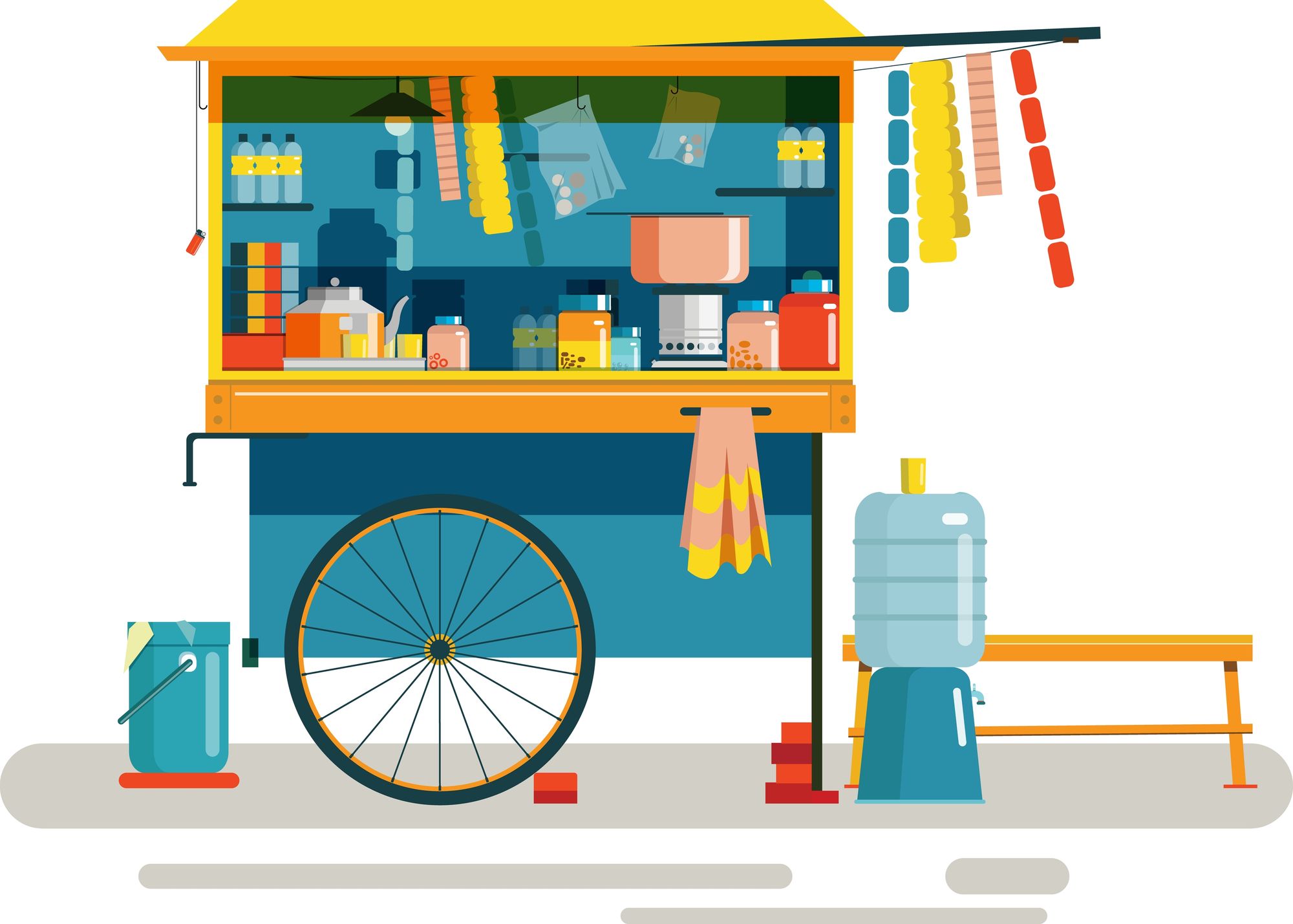
We hope our in-depth guide on how to start a tea stall turned out to be helpful for you. Starting a tea stall business in India is worth a shot as drinking tea is never going out of fashion in this country. But it needs a lot of planning to make the Chai business a huge success. If one chooses to start their own store rather than going to take a franchise, it will open future options for further expansion.
The Chai business has huge potential and also with changing times the demand for good tea cafes are increasing. It is pocket-friendly for the customers and is the best option for a small meet up with friends as, in India, a lot more can happen over a cup of tea than any other beverage!
1) How To Start A Business From Scratch? 2) How To Start Your Own Franchise? 3) How To Start A Stationery Business? 4) How to Start Export Business in India? 5) How to Start a YouTube Channel for Your Business? 6) Best Green Tea Brands in India
Stay updated with new business ideas & business tips with OkCredit blogs in- English, Hindi, Malayalam, Marathi & more! Download OkCredit now & get rid of your bookkeeping hassles.OkCredit is 100% Made in India.

Q. How much does it cost to start a tea stall?
Ans- The lowest cost model and can be set up with a minimal investment of Rs. 50,000 for Tea Shop Business Plan or Chai Business in India. Tea is offered to the customers in paper cups or kulhads. The stalls can sell other items such as bread toast, cigarettes, tobacco, noodles, omelettes, along with tea.
Q. Are tea stalls profitable?
Ans- The Tea Business Profit Margin many a time varies on a location basis. After calculating extra costs to this, a cup of tea would cost you around 3.5-5 Rupees. If you own a stall and sell a cup for 10-20 Rupees, you have a profit margin of about Rs. 15. For a Chai Business, where you can set higher prices, your profits could be up to 55-60 Rs per cup.
Q. How do I start a tea selling business?
Ans- Answering the peak pointers on how to start a tea business in India, follow these specific methods to success:
- Curate a proper business plan.
- Find target customers.
- Conduct market research.
- Register your business officially with the authorities.
- Legalise your Tea Business
Q. How do I open a tea cafe?
Ans- To make a Tea Shop Business Plan or open a Chai Business in India you must follow the steps below:
- Comply with local, country and state legal regulations
- Get all necessary licenses sorted first
- Research on your local competitors
- Invest in attractive interiors and decoration
- Pick a prime location to set your Chai Business
- Use what you learn from the competitors to target your consumer base
Q. How much does a Chaiwala earn?
Ans- In the competitive Chai Business, the Tea Business Profit Margin averaging on metropolitan cities based on selling 900 cups a day which is priced at 5 to 7 Rupees can make around Rs. 5300 daily approx. Tea Shops on Highway price their tea to Rs. 100 and an average selling on 400 cups per day makes the daily income up to Rs. 4000.
Q. What equipment is needed for a tea shop?
Ans- The Cost Of Opening A Tea Shop In India mainly depends on the equipments needed for a Chai Business. Some of the main ones will include-
- Plates And CupsEating Utensils
- Sugar And Cream Dispensers
- Tea Baskets To Hold The Tea While Steeping
- Honey Dispensers
- Table Linens
Q. How do I register for a tea shop?
Ans- Business License or Food License for Chai Business is needed as per the Tea Control Order, 2005. To get your Tea Shop Business Plan registered, the manufacturer should submit Form A to the concerned Licensing Authority. The license becomes valid for three years after being granted, after which it could be renewed for an additional 3 years.
Read the best of business ideas, tips for small businesses, the latest update on technology & more by OkCredit.
Recent Posts
Cable manufacturers in india [5 best manufacturers], air compressor manufacturer in india [top 11 manufacturers], pet bottle manufacturers in india [top 7 manufacturers], paint manufacturers in india [6 best manufacturers], silk saree manufacturers in india [best manufacturers], you might be interested in, foreign direct investment(fdi) 101: a complete guide, series funding [types, how it works and more], sustainable architecture ideas that can improve our lives.
How to Use Instagram for Business and Drive Results in 2024
Everything you need to know about using Instagram for business — from setting up your account to creating a winning strategy.

Table of Contents
Is your business still “like”-ing the idea of using Instagram, rather than confidently sliding into the DMs of the platform’s full potential? It’s high time to stop scrolling and start strategizing.
If you’re wondering how to use Instagram for business in 2024 , we’ve got you covered. In this guide, we’ll share the top strategies to help your brand thrive on the ever-evolving platform.
Bonus: Claim your free pack of 15 creative Instagram post templates made by Hootsuite’s professional graphic designers. Easily customize them in Canva, and start getting more engagement today.
How to set up Instagram for business in 4 steps
Using Instagram for business is a bit different than using a personal account. But don’t worry, it’s not rocket science! Follow these 4 simple steps to get your brand up and running on Instagram.
1. Switch to an Instagram business account
Before you start using Instagram for business, you need to create an Instagram account for business. It’s free and anyone can do it.
Here’s how to switch your existing Instagram account to a business account:
- From your profile, tap the hamburger (three lines) menu icon in the upper-right corner.
- Tap Settings and privacy . Then, scroll down until you see the Account type and tools menu.
- Next, click Switch to a professional account to change the account you’re logged into into an Instagram business account.
- Tap Continue (you may need to tap it multiple times as Instagram previews the available features of a professional account).
- Select a Category and use the slider to choose whether to show it on your profile, then tap Done .
- Choose Business (unless it makes sense for you to choose Creator ), and tap Next .
- Use the slider to opt in or out of promotional emails from Instagram for professional accounts, then tap Next .
- Add or edit relevant contact details, then use the slider to choose whether to show your contact information on your profile, then tap Next (or tap Don’t use my contact info to skip this step).
- If you plan to connect your Instagram business account with a Facebook business page, follow the prompts to connect your account to your Facebook Page. This is technically optional, but it’s necessary in order to use Instagram shopping features or run ads on Instagram .
- Next, you’ll be prompted to add additional features to your account, like telling Instagram your goals, adding details to your portfolio, and growing your audience. If you want to save this for later, tap the X in the top left corner to close this window and return to your profile.
If you’re interested in making an Instagram account for business simply sign up for a new Instagram account , and convert it to an Instagram business account.
You can have up to five Instagram accounts , so go ahead and keep your personal Instagram account personal if that’s what you prefer. Learn more about the difference between Instagram business and creator accounts .
2. Add business information to your bio
In 150 characters or less, your Instagram bio should describe your brand and showcase your brand voice . We’ve got a full guide to creating an effective Instagram bio for business (complete with templates), but here’s a quick video to walk you through the basics:
Also be sure to make the most of the other components of your Instagram business profile:
- Profile pic: Most brands use their logo. Your profile photo displays as 110 x 110 pixels (cropped to a circle), but it’s stored at 320 x 320, so that’s the size you should upload.
- Link in bio: Link to your website, your latest blog post, a current campaign or a Link Tree .
- Contact information: If you didn’t add contact info during your account creation, you can do so at any time by tapping Edit profile . Instagram will then add a Contact button to your profile.
- Action buttons: If relevant, you can add a button that allows customers to book or reserve appointments or to order food. To use this feature, you need an account with one of Instagram’s partners . Tap Edit profile , then scroll down to Action Buttons.
- Story highlights and covers: Instagram Story highlights are another way to maximize your profile real estate by providing more information about your brand, products, or services. Organize Stories into saved collections, then add some polish with Highlight covers.

Create. Schedule. Publish. Engage. Measure. Win.
3. Connect your product catalog
To tag products in Instagram content, or to run certain kinds of Instagram ads, you need to create a product catalog. You can do this in Meta’s Commerce Manager.
- Head to Commerce Manager and click Start Now , then select Create a catalog and click Get started again.
- Select Ecommerce , then click Next.
- If you have a shop on an ecommerce platform like Shopify or BigCommerce, click Connect to an ecommerce platform and follow the prompts to create your catalog. Otherwise, click Upload product info , name your catalog and click Next.
- Click View catalog to open your catalog, then Add items to start adding products.
We’ve got a whole post on using Commerce Manager if you’d like more details on how this tool works.
4. Turn on Instagram shopping
Once your catalog is full of products, it’s time to turn on Instagram’s shopping features.
- Go to the Get started page.
- Select Get started .’
- Click Create a shop , then Get started , then Next.
- Review the pre-selected sales channels and add or subtract accounts as needed.
- Choose the account/sales channel you want to connect your shop to. If you’re already selling on Shopify or another partner platform, change your Checkout method to reflect this . When everything is set up, click Next.
- Next, choose the countries you want to ship your products to. Note that Instagram Shopping is not available everywhere. You can choose from available countries in the drop-down menu.
- Add in your business email . This is where you’ll get any communication about your Instagram Shop.
- Select your business portfolio or create a new one. Click Next .
- Select the catalog you want to use for your shop and click Next . To select a catalog, it must meet catalog eligibility requirements for shops. You can’t switch this catalog later. Note: If you don’t have a catalog already, you won’t see this step.
- Look over your shop details, review and agree to the Seller Agreement and click Finish setup to complete creating your shop.
We’ve got a full blog post explaining everything you need to know about Instagram Shopping if you want to focus on this particular aspect of using Instagram for business.
How to use Instagram for business: 8 strategies
Standing out as a business on Instagram can be, well, tough. Use these Instagram for business tips to make it easier.
1. Research your audience
A good social media strategy starts with a sound understanding of your audience.
Instagram’s audience demographics give you an overall picture of who uses the platform. For example, 18-34-year-olds represent the largest ad audience on the site.
However, that doesn’t mean your specific audience on Instagram will be made up of 18-to-34-year-olds. For example, looking at the audience insights for my own Instagram account, I can see that my audience skews older than the Instagram average:
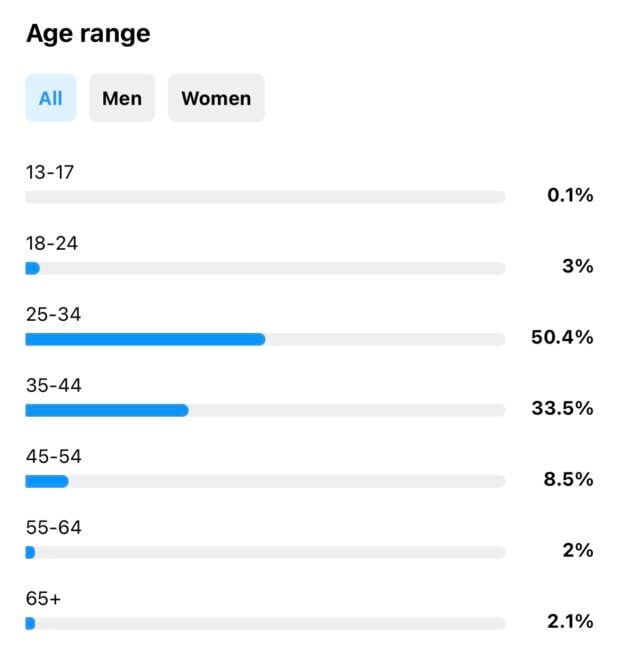
You can find demographic information on your existing audience using Instagram Insights , Meta Business Suite , or Hootsuite Analytics . But, if you’re just getting started using Instagram for business, you might not have a large enough following to gain meaningful insights here yet.
In that case, take a look at the demographics of your audience on other social channels and of your existing customer base. While this won’t translate exactly to Instagram, it should give you a sense of who’s interested in your business and what you have to say.
Understanding your audience puts you in a better position to create targeted content and business captions for Instagram that resonate. Since audience research is an important foundation for your content strategy, we’ve got a whole post dedicated to helping you find your target market .
2. Figure out your content mix
Now that you know who your audience is, you need to determine what to share with them. Rather than posting random content whenever the mood strikes, you need to develop a content strategy that speaks to your audience and keeps them engaged, all while contributing to real business goals .
While you should certainly post some promotional content to get people excited about your products and drive sales, you also need to provide content that builds community and sparks engagement.
That might mean including user-generated content or other curated resources , sharing insider expertise about your industry, or joining in on a trending meme. (But tread carefully here—only join in on trends that are appropriate for your brand voice.)
i am wearing a disguise pic.twitter.com/HlWFQb8P22 — no name (@nonamebrands) October 31, 2022
Look for opportunities to develop themes or regular installments that you can build into a series. “Content buckets” allow you to check certain boxes without having to overthink creation. The more planning you do upfront, the better you’ll be able to produce regular content and respond to last-minute or unplanned events.
3. Schedule your content in advance
From Reels to Stories to posts, there are many options when it comes to Instagram content.
The best way to create a unified strategy is to schedule your content across all Instagram surfaces (and other social platforms) using a content calendar . Or, take it up a level and schedule all your content to publish automatically at the right time using a tool like the Hootsuite Publisher . Yes, you can even schedule Stories and Reels in advance.
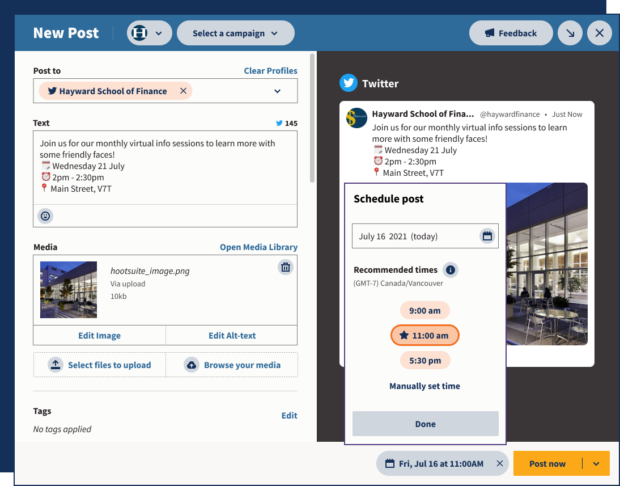
The added advantage here is that you can create your content in dedicated blocks of time and schedule it to post at the best time for your audience . Even if that time is outside business hours, on the weekend, or in the middle of the night.
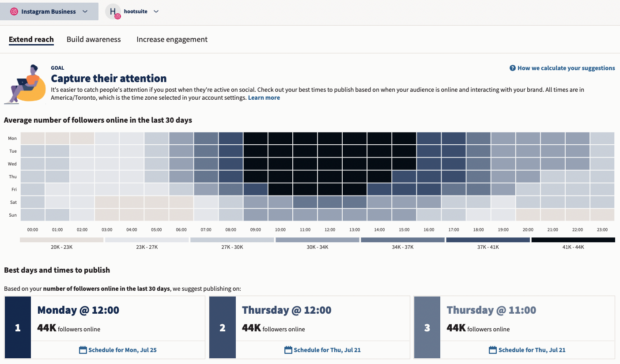
4. Tag products
When you share content about your products on Instagram, tagging makes it much easier for people to learn more or buy. You can tag up to 20 products in a photo feed post.

Source: Tory Burch
To tag products, create your Instagram post or Reel as usual. Then, on the final screen before posting, tap Tag products . You can tag products from your own shop or someone else’s, which creates great opportunities for collaboration and cross-promotion.
In Stories, you can tag products using the Product link sticker.

Source: Pat McGrath
5. Track your results (and learn from wins and losses)
With an Instagram for business account, you have access to the platform’s built-in analytics tools to help you understand how well different types of content perform.
There are several other analytics tools available, including Hootsuite’s , that can track longer time frames, automate reporting and make it easier to compare Instagram metrics across other social media platforms.

No matter which social media marketing tools you use, the important thing is to check in regularly to learn what kind of content resonates best with your target audience. You’ll start to see patterns about what generates the most engagement, as well as what kinds of social media content increase views beyond your existing follower base. ( Hint: Try Instagram Reels .)
Use these lessons to hone your content strategy over time.
6. Treat Instagram as a customer service channel
Success on Instagram requires you to engage with your followers rather than just blast content out and hope someone likes it. One important component of this two-way communication is monitoring your DMs for questions, comments, and customer service requests.
Instagram business accounts have access to a couple of DM features that make managing customer service easier on the platform. First, your inbox is divided into Primary and General tabs to make it easier to keep track of your messages. And second, you can create saved replies to commonly asked questions that you can access via keyboard shortcuts.
Hootsuite Inbox makes it even easier to manage your DMs by allowing you to assign messages to the appropriate team members . Or, create templated replies to common questions to save your team time and effort.
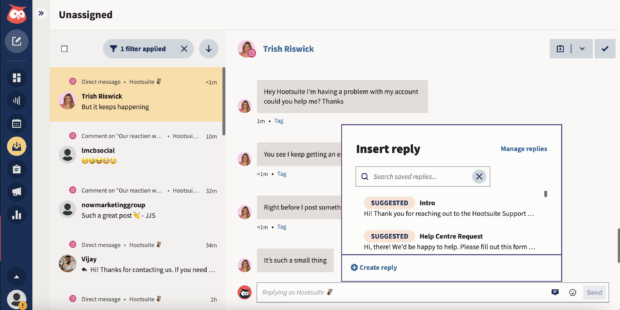
Manage all your messages stress-free with easy routing, saved replies, and friendly chatbots. Try Hootsuite’s Inbox today.
7. Automate content creation
The average Instagram business account posts 1.55 times per day on the main feed.
That’s a lot of content!
Luckily, manual content creation is now a thing of the past. These days, it’s easy to speed up content creation processes like copywriting and graphic design with the help of generative AI tools .
OwlyWriter AI is Hootsuite’s latest generative AI tool, free to all Hootsuite users. Use OwlyWriter to generate quick social media captions , and get inspiration for your posts across platforms.
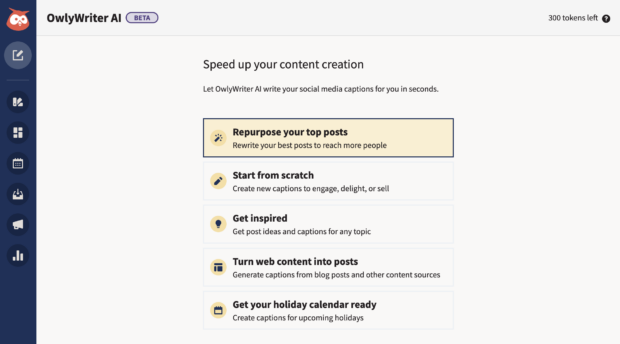
You can also leverage outside tools like ChatGPT, Dall-E, Midjourney, and more. But, because OwlyWriter is oh-so convenient in your Hootsuite dashboard, we recommend starting there. Check out our blog on the best AI content creation tools here .
Always remember, content generated by AI should always be seen as a starting point, not a finished product . Be sure to check over any AI generated content for accuracy, brand voice, style, and tone before posting.

OwlyWriter AI instantly generates captions and content ideas for every social media network. It’s seriously easy.
8. Elevate your grid aesthetics
Looking to make your Instagram grid stand out from the crowd? With Hootsuite’s Instagram Grid integration , you can make a totally aesthetic Instagram grid in just a few clicks.
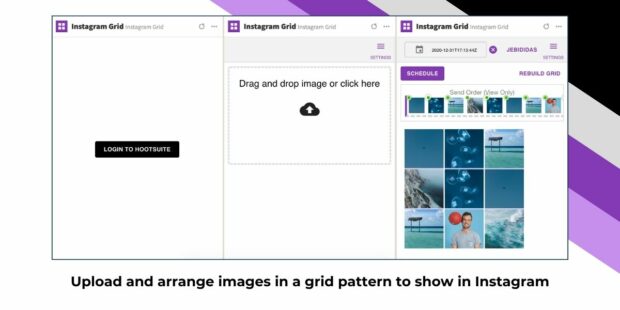
Here’s how it works:
- Seamless planning: Planning your grid layout has never been easier. With Instagram planning apps like Instagram Grid, you can visualize how your posts will look together , ensuring a cohesive and visually appealing grid.
- Drag-and-drop simplicity: Want to rearrange your grid? No problem. With easy-to-use drag-and-drop functionality , you can experiment with different layouts until you find the perfect arrangement.
- Scheduled posts: Say goodbye to last-minute scrambling. With Hootsuite, you can schedule your grid posts in advance , ensuring that your grid remains active and engaging even when you’re busy.
- Curate like a pro: Discover and curate high-quality content right from the Hootsuite dashboard. Whether it’s user-generated content, AI hashtag suggestions , or trending topics, we’ve got the tools you need to keep your grid fresh and relevant.
- Track your success: With Hootsuite’s analytics dashboard, you can track engagement metrics and understand what resonates with your audience. Use these insights to refine your grid strategy and drive even more engagement.
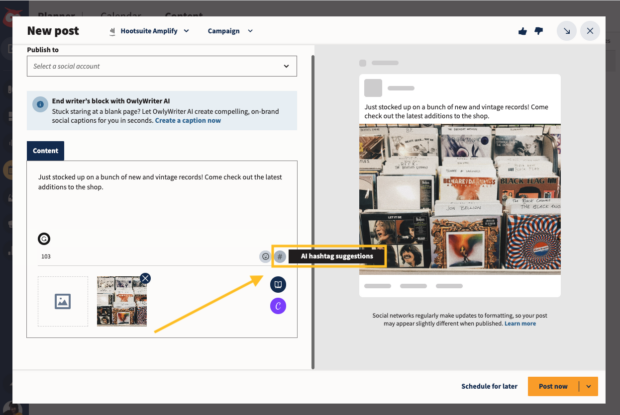
FAQs about using Instagram for business
Is instagram for business free.
It’s free to set up an Instagram business account, promote your business, and even set up an Instagram shop.
The only fees for Instagram business accounts are ad costs if you choose to run Instagram ads , and selling fees if you use Commerce Manager to allow your customers to check out and complete their purchase within the Meta platform.
There is also no fee to use Instagram Shopping to tag products and direct users to your website to buy them.
What is the difference between personal and business Instagram?
The difference between personal and business Instagram accounts is pretty straightforward. Personal accounts are great for sharing your daily life and connecting with friends and family. But, if you’re running a business or want to promote or sell a product, a business account on Instagram offers tools like analytics, shopping, and advertising to help you reach your goals.
What is the best time to post on Instagram for business?
The best time to post on Instagram for your business depends on who you’re trying to reach and what you’re sharing. Mornings generally bring the most engagement for brand accounts, though certain industries, like real estate, retail, or entertainment accounts, may see more success posting in the evening.
Check out our comprehensive guide on the best times to post on every social network to learn more.
How does Instagram work for business?
By switching your personal profile to a business account, you unlock a treasure trove of tools to boost your business. Get free access to features like Instagram Insights, which lets you peek into who’s engaging with your business on Instagram, or Commerce Manager, which lets you tag and sell products directly on Instagram. It’s like having your own personal business assistant right at your fingertips!
What are the disadvantages of using Instagram for business?
While business Instagram accounts are a great way to sell products and be seen, there are a few drawbacks to consider.
First, increased competition among businesses on the platform can make it tough to secure organic reach. Second, managing a business account requires consistent effort, and eventually you may want to consider hiring a social media manager . Third, unlike personal accounts, where updates are more flexible, business profiles carry the weight of reputation and customer perception. Be sure to read up on managing social media crises before you get started.
Save time managing Instagram for business using Hootsuite. From a single dashboard, you can schedule and publish posts, carousels, Stories, Reels, and ads directly to Instagram — and engage your audience, measure performance, and handle all your other social media profiles. Try it free today.
Easily create, analyze, and schedule Instagram posts, Stories, Reels, and Threads with Hootsuite. Save time and get results.
Become a better social marketer.
Get expert social media advice delivered straight to your inbox.
Hannah Macready is a freelance writer with 12 years of experience in social media and digital marketing. Her work has appeared in publications such as Fast Company and The Globe & Mail, and has been used in global social media campaigns for brands like Grosvenor Americas and Intuit Mailchimp. In her spare time, Hannah likes exploring the outdoors with her two dogs, Soup and Salad.

Money blog: Landlords setting up limited companies to protect themselves from budget
With less than a week to go until a budget the government has repeatedly warned will be "painful", a rising number of landlords are creating limited companies to hold buy-to-let properties. Read this and the rest of today's money news below - and watch the latest episode of New Money.
Friday 25 October 2024 07:55, UK
Please use Chrome browser for a more accessible video player
- Millions of Britons can't get supermarket loyalty card - here's why
- Landlords setting up limited companies to protect themselves from budget
- Chancellor to rewrite fiscal rules to give herself more headroom in budget
Essential reads
- 14 top destinations for a winter holiday that won't break the bank
- Britons on certain benefits could get free 50% on savings
- Cheap Eats: Great British Menu veteran shares salad and curry tips
- Which taxes could go up in the budget?
- Analysis: How chancellor could give herself another £50bn to play with
Tips and advice
- Eurostar launches service with big discounts - but there's a catch
- Five banks offering nearly £200 to customers who join from rivals
- Basically... Railcards
Real Bedford FC play in the lower leagues of English football. A matchday there seems, at first glance, like any other non-league club - a sense of community, a place to have a pie and a pint.
But if you look a bit closer, you notice that the ground is actually sponsored by huge cryptocurrency companies like Gemini and Luxor - and that the club is owned by Bitcoin podcaster Peter McCormack.
Sky News' series New Money takes a look inside new digital industries, speaking to some of the influencers, content creators and business owners across the UK.
In this episode we spend a day at Real Bedford FC to find out Peter's plan to get his team to the Premier League - all backed by Bitcoin.
Millions of people are excluded from loyalty schemes offering lower prices at some of the UK's biggest retailers, according to consumer brand Which?.
Sign-up criteria like minimum age, UK residency, email addresses or app downloads force some shoppers to pay 10%-33% more for affected items on average.
Vulnerable groups like young carers and the homeless are excluded, Which? said.
"This means a 17-year-old single parent living independently would not get a discount on baby food at some supermarkets, while a homeless person would have to pay more for a meal deal at others," the group said.
A Boots spokesperson said: "We are committed to providing great prices and value for money for all customers through a wide range of deals, discounts and promotions."
A Lidl spokesperson said everything they do is designed to give households access to good food at low prices. In-store promotions are available and app age restrictions are in line with legal requirements related to certain offers.
A spokesperson for Sainsbury's loyalty scheme, Nectar, said customers can register without an email address or mobile number by contacting the Nectar Helpline.
A Tesco spokesperson said: "Clubcard unlocks the best value at Tesco, with shoppers able to save £360 a year."
A Waitrose spokesperson said: "Our age and address requirements are in line with some other retailers and reflect our store locations."
A Superdrug spokesperson said: "As an accessible retailer, we aim to offer great value to all our customers."
They said delivery was only available to addresses within the UK and Republic of Ireland and the Health and Beauty Card membership reflects this.
Every Friday we take an overview of the mortgage market, hearing from industry voices and getting a round-up of the best rates courtesy of the independent experts at Moneyfactscompare.co.uk . This week our focus is on the buy-to-let market.
Landlords have been facing uncertainty amid speculation capital gains tax could be hiked in next week's budget.
"They have had to review their portfolios over the years due to changing taxation rules," says Moneyfacts finance expert Rachel Springall.
"Landlords making purchases are making efforts to shelter themselves from a challenging tax environment by setting up a limited company."
A study out this week by Hamptons revealed more than 5,000 limited companies were created in Great Britain in September to hold buy-to-let property, a 28% increase year-on-year.
There have been almost 50,000 limited companies established since the start of 2024 - more than in the whole of 2021.
Aneisha Beveridge, head of research at Hamptons, said: "While landlord purchase numbers are well down on pre-pandemic levels, there's been no sign of a slowdown in the number of companies being set up to put them in. Most new purchases are now made in a company structure.
"An increase in personal tax rates will only widen the gap between the tax paid by landlords who own homes in their own name or a company name further."
Moneyfacts has looked at the best rates on offer for those buying to let...
Moneyfacts also rounds up what it calls "best buys", which look beyond the lowest rates and takes in incentives and fees...
Millions of pension pots containing almost £10,000 are estimated to be lying unclaimed or inactive.
£31.1bn spread across 3.29 million pots are now considered lost, containing an average sum of £9,470, according to research charity the Pensions Policy Institute (PPI).
Switching jobs combined with automatic enrolment into workplace pensions is driving the problem, with the total value of lost pensions rising by £12bn in the last six years.
There are options available to track down your lost cash, according to Chris Blackwood, spokesperson for the PPI's Pension Attention campaign.
"If you can do one thing today, visit pensionattention.co.uk and use the pension tracing tools to find any lost pension pots.
"You could also retrace your career steps, check old papers, look for any gaps in your pension history, and contact your provider to update your contact details."
People may find they can track down pensions by speaking to former employers or by logging into pension providers' websites or apps.
The government's Pension Tracing Service is also available to help people find lost pension pots.
The Pensions and Lifetime Savings Association website provides an idea of whether savers are on track for the sort of income they expect in retirement.
Ferrari has revealed its first new supercar in more than a decade.
The new F80 has a 1,200-horsepower V6 hybrid engine and can do zero to 60mph in just 1.9 seconds.
It has a top speed of about 217 miles per hour.
If you're interested, it will set you back a cool £3m - one of the brand's most expensive models to date.
Production will be limited to 799 units and deliveries are scheduled to begin by the end of next year.
"Supercar" usually describes high-performance sports cars, but Ferrari exclusively uses the term for its rare, limited-edition models.
The F80 is inspired by aerospace design, with the car's cell made from carbon fibre and the subframes for the front and rear suspension components crafted from aluminium.
By Greg Milam , chief north of England correspondent
Chris Downes's piercing blue eyes stare out from the mugshot on a Cheshire Police news release.
He "has been causing problems within this town through shoplifting for over two decades", it reads.
It announces a criminal behaviour order banning the 60-year-old from entering any part of his local town centre of Macclesfield and every Co-op store in Cheshire.
"I feel like I've been punished twice," Chris says, once for the original offence and again with the banning order. It causes inconvenience with things like doctor's appointments and shopping for him and his elderly mother.
Chris is one of those people we rarely hear from in all the talk about the explosion in shoplifting in Britain. He is one of that legion of shoplifters and agreed to speak to Sky News.
"Why did I do it? I did it because of a drug problem. I had no option," he says.
"I know it's wrong but it wasn't hurting any individual as I see it. I wasn't taking old ladies' handbags, I'm not saying shoplifting is right but needs must I suppose."
Addiction issues are a familiar feature of shoplifters' stories. We have spoken to a number who, almost word for word, say the same as Chris Downes. They want things to be different, they say, but cannot break the cycle.
Read on here...
Rachel Reeves's plan to change the government's fiscal rules on borrowing could have "frightening long-term consequences", leading financial advisers at Blick Rothenberg have said.
Tweaking how the UK's debt is defined could give the chancellor another £50bn to play with at next week's budget - see our previous posts for details.
"Increased borrowing and increased borrowing costs would have to be paid back by all taxpayers over time and with interest," said Nick Winters, a partner at Blick Rothenberg.
"At some point, she would need to raise taxes even further or risk widening the fiscal £22bn 'black hole', which given the tax rises already proposed in the budget, is a scary possibility."
Mr Winters said the change could present her with a "big, temporary win" - but "there are only so many tweaks our economy can take before it crumbles".
(This is an abridged version of Conway's original analysis from earlier this month - read the full thing here )
I want you to ponder the fiscal rules Rachel Reeves is confronted with at this, her first budget. Most pressingly, ponder the so-called debt rule, which insists that the chancellor must have the national debt - well, technically it's "public sector net debt excluding Bank of England interventions" - falling within five years.
There is, it's worth underlining at this point, nothing fundamental about this rule. Reeves inherited it from the Conservative Party, who only dreamed it up a few years ago, after COVID.
To meet this rule, she needs the national debt to be falling between the fourth and fifth year of the OBR's five-year forecast. And according to the last OBR forecasts, which date back to Jeremy Hunt's last budget, it is. But not by much: only by £8.9bn.
If that number rings a bell, it is because this is the much-vaunted, but not much understood, "headroom" figure a lot of people in Westminster like to drone on about.
And - if you're taking these rules very literally, which everyone in Westminster seems to be doing - then the takeaway is that the chancellor really doesn't have much room left to spend in the coming budget. She only has £8.9bn extra leeway to borrow!
The first thing to say is there's nothing gospel about these rules. There's no tablet of stone that says the national debt needs to be falling in five years' time.
Second, sometimes investments in things can actually generate more money than they cost. But since the debt rule only looks five years into the future, you only ever see the cost and not the eventual breakeven point.
Third, the debt rule used by this government actually focuses on a measure of the national debt which might not necessarily be the right one.
The measure we currently use excludes the Bank of England, which seemed, a few years ago, to be a sensible thing to do. The Bank has been engaged in a policy called quantitative easing which involves buying and selling lots of government debt - which distorts the national debt. Perhaps it's best to exclude it.
Except that recently those Bank of England interventions have actually been serving to drive up losses for the state. I won't go into it in depth here for risk of causing a headache, but the upshot is most economists think focusing on a debt measure which is mostly being affected right now not by government decisions but by the central bank reversing a monetary policy exercise seems pretty perverse.
In other words, there's a very strong argument that instead of focusing on the ex-BoE measure of net debt, the fiscal rules should instead be focusing on the overall measure of net debt. And here's the thing: when you look at that measure of net debt, lo and behold it's falling more between year four and five. In other words, there's considerably more headroom: just under £25bn rather than just under £9bn based on that other Bank-excluding measure of debt.
Might Reeves declare, at the budget or in the run-up, that it makes far more sense to focus on overall PSND from now on? Quite plausibly. And while in one respect it's a fiddle, in her defence it's a fiddle from one silly rule to an ever so slightly less silly rule.
It would also mean she has more room to borrow to invest - if that's what she chooses to do. But it doesn't resolve the deeper issue: that both of these measures fixate on the short-term cost of debt without taking into account the long-term benefits of investment.
If Reeves is determined to stick to the, some would say arbitrary, five-year deadline to get debt falling but wants to incorporate some measure of the benefits of investment, she could always choose one of two other measures for this rule.
She could focus on something called "public sector net financial liabilities" or "public sector net worth". Both of these measures include some of the assets owned by the state as well as its debts - the upshot being that hopefully they reflect a little more of the benefits of investing more money.
The problem with these measures is they are subject to quite a lot of revision when, say, accountants change their opinion about the value of the national road or rail network. So some would argue these measures are prone to more volatility and fiddling than simple net debt.
Even so, these measures would dramatically transform the "headroom" picture. All of a sudden, Reeves would have over £60bn of headroom to play with. More than enough to splurge on loads of investments without breaking her fiscal rule.
There's one other change to the rule that would probably make more sense than any of the above: changing that five-year deadline to a 10 or even 15-year deadline. At that kind of horizon, a pound spent on a decent investment would suddenly look net positive for the economy rather than a drain.
Rachel Reeves will rewrite the government's fiscal rules in next week's budget to allow her to increase borrowing for public investment by around £50bn.
Speaking to Sky News in Washington DC, the chancellor said that the self-imposed rule under which borrowing must be falling by the fifth year of economic forecasts will be redefined from the current measure of public sector net debt.
Ms Reeves would not be drawn on what measure will replace the current rule but there is speculation that she will favour using public sector debt net of financial liabilities (PSNFL).
Under this definition, investments such as the government's student loans book are defined as assets rather than liabilities, which on current measures would allow a further £53bn of borrowing.
The chancellor said the second fiscal rule, under which day-to-day spending must be funded from government revenue rather than borrowing, would be unchanged.
Growing consensus
Ms Reeves cited support for increasing the debt threshold from leading British economists, as well as the International Monetary Fund, which this week said public investment should be protected and was "badly needed" in the UK .
She insisted the change was necessary to end years of declining public investment and deliver on Labour's promise to deliver growth.
"Under the plans that I have inherited from the previous Conservative government, public sector net investment as a share of our economy was due to decline steeply during the course of this parliament," she said.
"I don't want that path for Britain when there are so many opportunities in industries from life sciences to carbon capture, storage and clean energy to AI and technology, as well as the need to repair our crumbling schools and hospitals."
Ms Reeves denied that she was effectively fiddling the rules to get around her manifesto pledge not to increase income tax, VAT or national insurance.
"The rule that really bites is the first rule, the stability rule, to get day-to-day spending funded by tax receipts. That's something that the previous government weren't even trying to achieve and we will show in the budget next week how we will deliver on that promise.
"The second role is about being responsible. By seizing the opportunities, but doing it in a way where we are making sure we're getting value for money for every pound of taxpayers' money spent.
"Of course we'll put guardrails in place to ensure that every pound of taxpayers' money that is spent is spent wisely, and will involve the National Audit Office and the Office of Budget Responsibility in that."
The first test of the change in the debt rule will be the reaction of bond markets, which rose slightly on Thursday following reports of Ms Reeves's plans.
Taken together, the redefined fiscal rules set the terms of a budget that is likely to see tax rises and public spending cuts balanced by more freedom to borrow.
Tax rises not ruled out
Ms Reeves did not rule out a raft of tax rises, including adding national insurance to employers' pension contributions, from which public sector employers may be exempt.
"I was clear in the statement I made to the House of Commons in July that there will be difficult decisions in this budget around spending, welfare and taxation. But the precise details I will set out to the House of Commons next week.
"I will be a responsible chancellor. I will be honest and transparent about the challenges we face, but also how we'll fix them to wipe the slate clean after the mismanagement we've seen in the last few years under the Conservatives."
Gareth Davies, shadow exchequer secretary, said: "Before the election Rachel Reeves promised that she would not 'fiddle' the fiscal rules, and now it seems she is going to do exactly that. Remarkably she is announcing this not to Parliament, but to the IMF in advance of the budget.
"This is already having real world effects, with borrowing costs rising. This uncertainty over additional borrowing risks interest rates staying higher and for longer. It's families up and down the country who would pay the price."
The NHS offers a free jab every year to people at higher risk of getting seriously ill from flu.
If you're eligible, you may be able to get a flu vaccine from a pharmacy, your GP surgery, your care home, your maternity service or your employer (if you're a frontline health or social care worker).
You can get the free NHS flu vaccine if you:
- Are aged 65 or over in England, Wales and Northern Ireland
- Are aged 50 or over in Scotland
- Are pregnant
- Live in a care home
- Are the main carer for an older or disabled person, or receive carer's allowance
- Live with someone who has a weakened immune system
- Are a frontline health and social care worker
- Are of school-age (reception to year 11)
- Have certain medical conditions (the NHS has a full list )
Most eligible adults will be able to get the flu vaccine from 3 October.
If you don't qualify for a free flu jab on the NHS or at work, you'll have to pay, with prices from around £10-22 if bought from major supermarkets and pharmacies.
Be the first to get Breaking News
Install the Sky News app for free


IMAGES
VIDEO
COMMENTS
12 Key Steps To Open a Coffee Shop. 1. Have a Vision. Passion with a vision is the driving force you need to move into action and succeed. Your desire will be the fuel to your success, and your ...
Startup costs for a thrift store range from $2,500 to $35,000. The low end represents opening an online store with the largest costs being inventory and a website setup. The high end reflects the cost of opening a physical store. You'll need a handful of items to successfully launch your thrift store business.
Step 1: Create a Retail Store Business Plan. A business plan is a written document containing a business's goals, methods for attaining those goals, and a time frame for achieving them. It's a crucial first step in starting any business. Writing a business plan gives you a definitive path to follow and set you up for success.
Create a Company Description. After you have the executive summary in place, you can work on the company description, which contains more specific information. In the description, you'll need to ...
How to Start a Baking Business. Whether you're passionate about creating decoratively frosted cakes or artisan sourdough loaves, you must create an action plan for turning your passion for baking into a business.Discover the steps of opening a bakery below. 1. Choose a Bakery Style. While there are many bakery business models, they all fall under one of two umbrella categories: retail and ...
Here's what to include in your executive summary: Business name and location: Start with your business's name and physical or online location. Mission statement: A single sentence summarizing your business goals and market needs. Products/services: Briefly describe your offering, highlighting its unique features.
Step 3: Register your business. With your business plan and budget in hand, you can now move onto the next step involved in learning how to start a retail business—making it official. Come up ...
The Ultimate Step-by-Step Coffee Shop Guide (2024) 2024 is the best time to start a coffee shop. With 210 million daily coffee drinkers in the United States and two billion cups consumed worldwide, the American and global markets point to a solid retail coffee future. Whether you want to start a coffee truck business, open a drive-thru coffee ...
Here, we outline the equipment, utilities and supplies you'll need to start your own coffee shop. We'll also look at the process of sourcing equipment, utilities, and suppliers. Equipment. Opening a café or coffee shop requires a lot of equipment.
The first part of your start-up is always the same: your business plan. Your coffee shop business plan will look very similar to any other. It should include: Your business proposition. Unique selling point (USP) Target customer. Marketing strategy. Sources of funding. Overheads.
Opening an Ice Cream Shop. Opening an ice cream shop may seem like an overwhelming task at first. However, breaking down the process into steps makes it easier to tackle. Follow our 10-step guide to opening an ice cream shop. 1. Ice Cream Shop Concepts and Branding.
When writing a well-rounded business plan, include the following sections: Executive summary: The executive summary should be the first item in the business plan, but it should be written last. It ...
Step 5: Register Your Business. Registering your business is an absolutely crucial step — it's the prerequisite to paying taxes, raising capital, opening a bank account, and other guideposts on the road to getting a business up and running. Plus, registration is exciting because it makes the entire process official.
Once you've opened your shop, you'll be charged a one-time shop set-up fee of $15 USD. This fee helps us invest in support for new sellers, as well as enhanced security checks to protect our marketplace. If you onboard using Payoneer, the fee will be in USD and is non-refundable. Taxes may apply.
3. Create your store's business plan. Author Lee Bolman once said, "A vision without a strategy remains an illusion." That's why the next step is creating a solid business plan that sets your reseller business up for success. Your business plan should combine all your ideas into a clear strategy for making your consignment store profitable.
Here's how to start a consignment shop―as a brick-and-mortar store―in nine steps. 1. Choose the Right Type of Consignment Shop. If you're wondering how to start a consignment shop, the first step is to narrow down exactly what kind of store you want to open.
Writing the business plan for a fabric shop. Once you have gathered all the information in the previous sections, you can start writing the business plan for your fabric shop. The business plan is made up of two major components: A financial forecast that aims to highlight the potential profitability of the project and the need for initial ...
Despite what the folks protesting at Wall Street believe, one of the goals of setting up a retirement plan is saving the maximum for the owners and highly compensated employees of the business.
Step 3: Brainstorm a Tobacco Shop Name. Here are some ideas for brainstorming your business name: Short, unique, and catchy names tend to stand out. Names that are easy to say and spell tend to do better. Name should be relevant to your product or service offerings.
9 Steps To Set Up an Etsy Shop. Below are nine steps to get your Etsy shop up and running. 1. Create Your Etsy Account. To create a seller account, you must first have a consumer Etsy account ...
When writing brand guidelines, you can include: Colour scheme — choose two or three colours that your brand will use visually (e.g. Coca Cola's red and white). Tone of voice — decide how you would like to communicate to customers (e.g. friendly, conversational and often cheeky like Innocent).
Ans- The lowest cost model and can be set up with a minimal investment of Rs. 50,000 for Tea Shop Business Plan or Chai Business in India. Tea is offered to the customers in paper cups or kulhads. The stalls can sell other items such as bread toast, cigarettes, tobacco, noodles, omelettes, along with tea. Q.
Click Create a shop, then Get started, then Next. Review the pre-selected sales channels and add or subtract accounts as needed. Choose the account/sales channel you want to connect your shop to. If you're already selling on Shopify or another partner platform, change your Checkout method to reflect this. When everything is set up, click Next.
Rachel Reeves's plan to change the government's fiscal rules on borrowing could have "frightening long-term consequences", leading financial advisers at Blick Rothenberg have said. Read this and ...